Physical Address
304 North Cardinal St.
Dorchester Center, MA 02124
Connective tissue tumors presenting primarily in the skin are relatively common. Because the majority of such lesions are benign and clinically nondistinctive they are sometimes neglected by clinicians. However, histologically they constitute a complex group of tumors showing various lines of differentiation and it can be difficult to classify a lesion as benign or malignant. Also, cutaneous or subcutaneous sarcomas, as well as various neoplasms of intermediate malignancy, are seen sufficiently frequently that some knowledge of their behavior and pathological appearances is mandatory for dermatologists and dermatopathologists alike.
Many benign soft tissue lesions – lipoma and fibrous histiocytoma being the most common – are often slow growing and asymptomatic. As a result, they frequently remain untreated unless they are a cosmetic nuisance, and so an accurate estimation of their incidence (which is probably relatively high) is impossible. However, sarcomas are relatively rare at any site, including the skin, accounting for less than 1% of all malignant neoplasms.
In this chapter, emphasis is placed upon those lesions that commonly present in the skin; various nondermatologic conditions are included for the sake of completeness and because they may be seen, albeit very occasionally, in dermatopathological practice.
When dealing with any soft tissue neoplasm, the single most important dictum to be strictly followed is that adequate tissue sampling, surgically and pathologically, is essential for accurate diagnosis. The range of diagnostic and non-specific histologic appearances seen in these tumors is very wide, reflecting the multipotentiality of mesenchyme; only by obtaining an overall view of a given neoplasm can a reliable diagnosis be made. In this regard, punch and shave biopsies can be exceedingly challenging or sometimes impossible to definitively diagnosis.
A number of cutaneous mesenchymal tumors have genetic features that can be helpful diagnostically. In general, malignant soft tissue tumors fall into the class of complex karyotype sarcomas (e.g., angiosarcoma and leiomyosarcoma) or simple genetic profile (e.g., clear cell sarcoma or dermatofibrosarcoma) often associated with a chromosomal translocation or, less often, with mutation or loss of a specific gene. An exhaustive discussion of the molecular diagnostics of soft tissue tumors is beyond the scope of this chapter, but see Chapter 2 for additional discussion of relevant techniques. Most of the molecular features discussed in this chapter can be used diagnostically when required, although some of the tests are available only in specialized centers.
Lipomas are the most common connective tissue tumors. They appear to occur more frequently in the obese, usually in middle and late adult life, may be multiple, especially in young adults, and are purportedly more common in females. This, however, may only be a reflection of the greater tendency of women to request cosmetic attention for otherwise innocuous lesions. Lipomas are very uncommon in children and when present should raise the possibility of Bannayan-Riley-Ruvalcaba syndrome. Congenital lipomas are very rare. Multiple lesions may occur in a familial setting. A case of multiple lipomas after total body electron beam therapy for mycosis fungoides has been reported. Multiple lipomas have also been described in association with rosiglitazone, a peroxisome proliferator-activator receptor (PPAR) gamma agonist, in association with systemic chemotherapy for Hodgkin lymphoma and in Cowden disease.
The lesions are found most often on the trunk, abdomen or neck, followed by the proximal extremities, and rarely on the face (particularly the forehead), scalp, hands or feet. Palmar lipomas are exceptional and may present with lesions simulating piezogenic pedal papules. Periungual and subungual lesions are exceptional. Trauma has been associated with induction of lipomas although it is not clear whether all of these lesions may represent pseudolipomas. The latter sometimes includes an intravascular lesion. Villous lipomatous proliferation of synovial membrane (lipoma arborescens) represents an infiltration of sub synovial connective tissue by adipose tissue. Typically, lipomas originate subcutaneously, are slow growing, mobile and painless; sometimes they are multiple. Size varies and some lesions are very large. Dermal examples are often clinically confused with fibroepithelial polyps. Although the lesions are usually well circumscribed, the less common deep variants, which may arise in muscle or in association with a tendon sheath or nerve, are generally ill defined and infiltrative.
Subcutaneous lipomas are entirely benign and local excision is nearly always curative; recurrence is infrequent (less than 5%) and progression to liposarcoma virtually never occurs.
Lipomas at all locations show clonal karyotypic abnormalities in up to 75% of cases. The most common rearrangement involves the 12q13~15 region affecting the HMGA2 gene. The deregulation of HMGA2 appears to play a role in the genesis of the tumor. The most common translocation is t(3;12)(q27~28;q13~15) leading to a fusion gene HMGA2-LPP . Many other translocations involving different chromosomes may be seen including 1p36, 1p32~34, 2p22~24, 2q35~37, 5q33, 9p21~22, 12p11~13, 13q12~14, and 4q27~28. Other less common chromosomal aberrations include 6p21~23 (sometimes involving the HMGA1B ), 13q11~12 and 12q22~24. The only translocation associated with 6p21~23 is t(3;6)(q27-28;p21~23).
The tumors are usually encapsulated, lobulated, and largely composed of univacuolated mature adipocytes, the nucleus and cytoplasm of which are compressed centrifugally ( Fig. 35.1 ). The lobules are divided by delicate fibrous septa containing thin-walled vessels. Degenerative changes, often characterized by fibrosis, focal fat necrosis, or myxoid change, are not uncommon, particularly in long-standing or frequently traumatized cases ( Figs 35.2–35.7 ). Prominent myxoid change and high vascularity are sometime present. However, the majority of lipomas with prominent myxoid change (myxolipomas) are now considered to be part of the spectrum of spindle cell lipomas. Foci of other fully differentiated mesenchymal elements, including bone or cartilage, can also be seen.
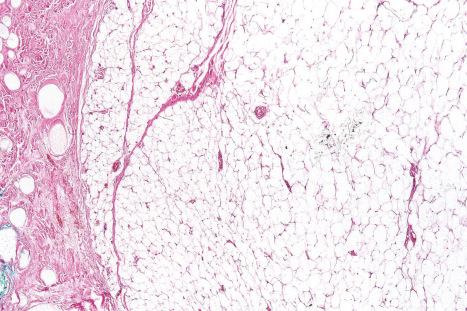
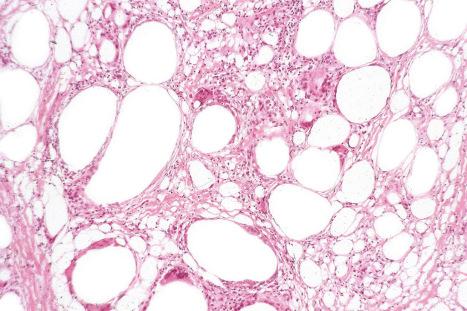
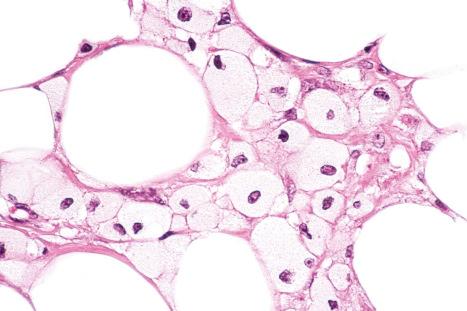
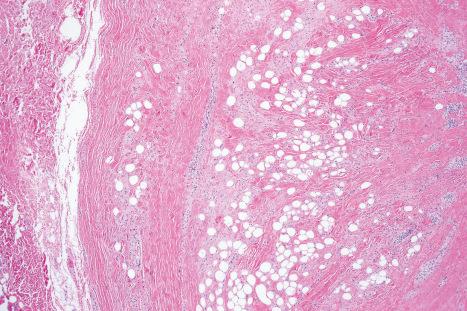
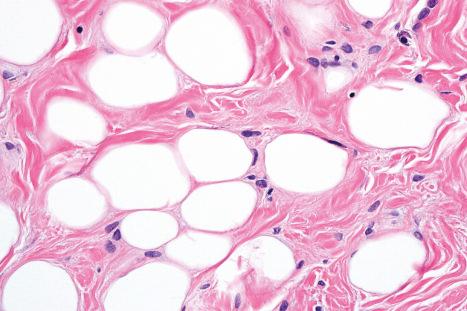
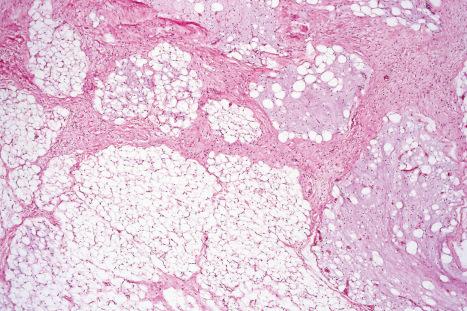
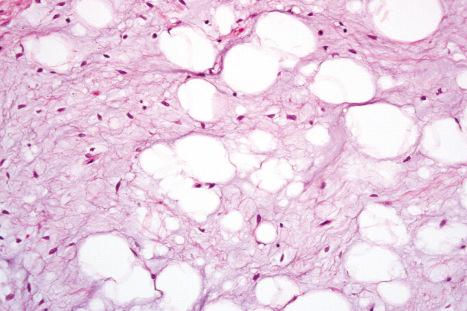
Although nuclear pleomorphism, hyperchromasia, and mitotic activity do not occur in lipomas, in any benign fatty lesion (or even in normal adipose tissue) occasional vacuolated nuclei known as lochkern may be seen ( Fig. 35.8 ). These must not be confused with lipoblasts, the most important diagnostic feature of liposarcoma, which are characterized by multiple intracytoplasmic lipid vacuoles associated with scalloping of peripherally located hyperchromatic or bizarre nuclei. In some lesions there are septa of collagen between adipose tissue lobules and they are referred to as fibrolipomas or sclerotic lipomas. A variant of lipoma with predilection for acral sites (fingers, wrists, toes) and characterized by prominent collagenous or myxocollagenous stroma, bland stellate or spindle-shaped cells and scattered adipocytes has been described as sclerotic (fibroma-like) lipoma. A further variant, known as fibrohistiocytic lipoma, has been reported. Typically, it presents in the subcutis of the trunk and shows predilection for young men. Most lesions are small and asymptomatic. Tumors are well circumscribed and consist of lobules of mature adipocytes containing focal areas with plump spindle-shaped cells arranged in a fascicular or focal storiform pattern. Rare lipomas may contain metaplastic bone. Those containing sweat glands do not represent an adenolipoma but rather entrapment of normal glands by the tumor. Lesions containing smooth muscle are rare, regarded as a distinct entity under the term myolipoma and tend to be deep seated. Secondary changes including focal areas of fat necrosis with foamy histiocytes are often seen and some cases show membranous fat necrosis.
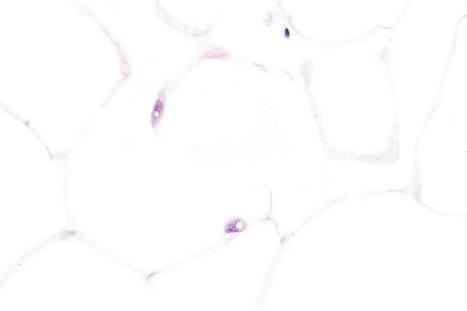
Dermal lipomas are less well circumscribed and consist of scattered groups of mature adipocytes between collagen bundles ( Figs 35.9 and 35.10 ). Nevus lipomatosus superficialis is histologically indistinguishable from dermal lipoma. The former term should therefore only be used, as a diagnostic term, in a specific clinical context (see below).
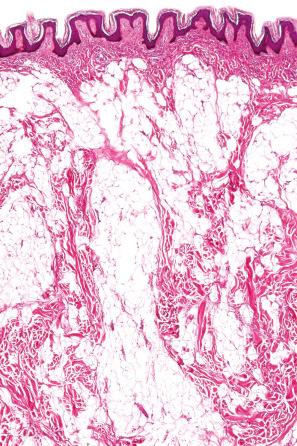
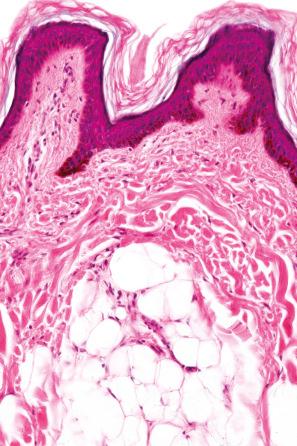
The diagnosis of a lipoma is usually straightforward. Distinction from an atypical lipomatous tumor (adipocytic /lipoma-like variant) is mainly based on the presence of adipocytes varying in size and shape and with hyperchromatic nuclei in the latter. In addition, atypical stromal cells are usually present in the latter. The absence of lipoblasts is not a helpful finding as they are not always present in atypical lipomatous tumor. In particularly difficult cases, immunohistochemistry with MDM2 and CDK4 may be helpful (see under atypical lipomatous tumor). Dermal lipomas can be confused with pseudolipomatosis cutis. The latter is an artifactual incidental finding distinguished from a dermal lipoma by the presence of empty, round spaces simulating adipocytes but lacking nuclei and of variable size.
Nevus lipomatosus superficialis is an uncommon form of connective tissue nevus, manifest principally by the deposition of fatty tissue in the dermis. In its classical form, it is characterized by multiple papular, polypoid or plaque-like lesions, up to 2 cm in diameter, which almost always arise unilaterally on the posterior surfaces of the buttocks, upper thighs or lower back. More extensive and diffuse involvement may occur and patients present with prominent folds in what has been described as the Michelin tire appearance. Typically, the lesions present in early childhood or adolescence. Unusual associations include co-occurrence with lipedematous scalp, folliculosebaceous cystic hamartoma, dermoid cysts, angiokeratoma of Fordyce, perifollicular fibromas, and trichofolliculoma. A case associated with intramuscular lipomatosis has been reported. A solitary form, usually seen in adults, shows a predilection for the same sites or occurs elsewhere and is more likely to represent a variant of fibroepithelial polyp or skin tag ( Figs 35.11 and 35.12 ). Such lesions have been described as pedunculated lipofibroma. In all types of nevus lipomatosus the sex incidence is equal. The papules or plaques, varying from skin-colored to yellow, are characteristically broad based and may show superficial comedone formation.
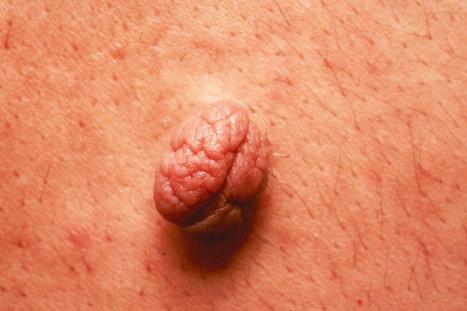
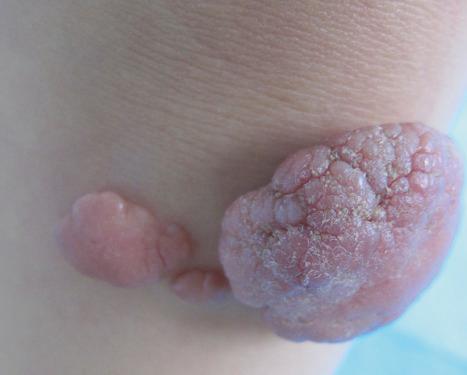
The pathogenesis is unknown. In a single case, a 2p24 deletion has been described.
Although alterations are seen in all the connective tissue elements in the dermis, the predominant feature is deposition of lobules of mature fat in variable quantities in the superficial dermis ( Fig. 35.13 ). These fatty lobules are located particularly around small blood vessels, the numbers of which are also increased. Areas of loose fibrous tissue, diminished elastic fibers and reduced numbers of epidermal appendages may also be a feature. Entrapped hair follicles may appear cystically dilated.
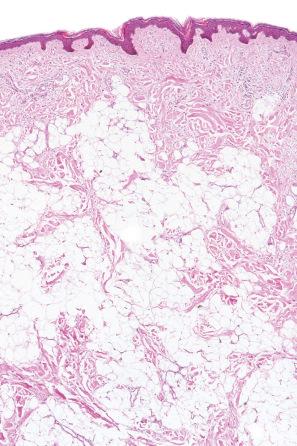
A case with focal pagetoid spread of adipocytes and dystrophic calcification has been described.
As mentioned previously, it has been argued that the solitary form represents a pedunculated, fat-containing skin tag or a lipofibroma. Although the distribution of fat in the superficial dermis makes this suggestion unlikely, the argument is semantic and of no practical value. Nevus lipomatosus superficialis is also histologically indistinguishable from the cutaneous nodules of focal dermal hypoplasia.
Lipomatosis is extremely rare and may present in several forms. Idiopathic forms include symmetric, diffuse and pelvic lipomatosis; the latter does not affect the superficial subcutaneous tissue.
Two variants of lipomatosis affect the superficial subcutaneous tissue:
Multiple symmetric lipomatosis (Launois-Bensaude) represents the commonest form and can be diffuse or localized. In the diffuse variant, there is usually symmetrical involvement of the trunk or proximal limbs, head and neck, pelvis, and occasionally the tongue, abdominal cavity and the intestinal tract; it is seen most often in children (particularly males), although adults may be affected. Single reports of associations with familial hyperlipidemia and tuberous sclerosis have been documented. Some cases show an autosomal dominant inheritance, others are associated with myoclonic epilepsy with ragged red fibers (MERRF), and a number may be associated with diabetes mellitus. The localized variant (multiple symmetric lipomatosis) is characteristically seen in the cervical region, back, shoulders and upper trunk, usually presents in middle-aged Mediterranean males with high alcohol intake, and is known as Madelung disease. Involvement of the mediastinum can be seen. Associated inspiratory dyspnea or obstructive sleep apnea may exceptionally occur. The axillae and groins can also be affected. There is strong association with alcohol abuse and liver disease. A variant of localized symmetrical lipomatosis restricted to the hands or the feet has been reported.
Asymmetric lipomatosis can present at any site and usually has no association with other diseases. Single reports of associations with familial hyperlipidemia and tuberous sclerosis have been documented.
A localized form of lipomatosis of the scalp has been reported as encephalocraniocutaneous lipomatosis (Haberland disease) and is associated with alopecia, aplasia cutis, nevus psiloliparus, skin tags and ocular and cranial abnormalities. It is not associated with Proteus syndrome. A relationship with oculoectodermal syndrome has been proposed. Congenital facial infiltrating lipomatosis refers to a disorder associated with hypertrophy of bones and soft tissues, macrodontia and premature dental eruption.
In addition, cases associated with exogenous or endogenous production of steroids (steroid lipomatosis) with predilection for the face, central chest, upper mid-back and spinal epidural, retro-orbital and mediastinal tissue may occur. An association with antiretroviral therapy (HIV lipodystrophy) has also been documented.
In both idiopathic forms of lipomatosis, only radical surgery can prevent local recurrence. The disadvantages of recommending such treatment must be weighed against the possible functional impairment that the condition may induce.
Mitochondrial DNA damage has been suggested as a possible etiology of symmetric lipomatosis and in lipodystrophy induced by HIV therapy. The localization of the lesions in multiple symmetric lipomatosis suggests an origin from brown fat. The demonstration that cells cultured from lesions synthetize mitochondrial inner membrane protein, a marker of brown fat, gives further support to this theory. Histologically, all forms are characterized by unencapsulated overgrowth of mature adipose tissue.
Adiposis dolorosa (Dercum disease) is a rare disease characterized by painful, circumscribed areas with increased fat in a plaque-like distribution. Usually, multiple body sites are involved but there is predilection for the buttocks, lower limbs and abdomen, particularly in juxta-articular areas. Localized disease is very rare and the breasts may be involved. The condition is much more common in females, between the fourth and sixth decades of live, especially after the menopause, and patients often have associated obesity and psychological problems. Occasional cases are inherited in an autosomal dominant manner. A case associated with the use of corticosteroids, a further patient with hypercholesterolemia and severe atherosclerosis and one with lipomatous hypertrophy of the interatrial septum have been documented. Pain occurs mainly as the result of palpation but may also occur spontaneously or as a result of movement.
A new classification of the disease has been proposed: (1) generalized diffuse without lipomas; (2) generalizsed diffuse associated with lipomas; (3) localized nodular; and (4) juxtaarticular.
The pathogenesis of adiposis dolorosa is unknown. Abnormal flow of lymph through the lymphatics within involved tissue has been suggested as an etiological factor. Biopsy reveals mature adipose tissue with focal areas of fat necrosis and, exceptionally, granulomatous inflammation.
Piezogenic pedal papules characteristically present as multiple skin-colored papules on the heels ( Fig. 35.14 ). They show predilection for the internal aspect of the heels and are usually asymptomatic although pain may be elicited when the patient is standing. Lesions become more noticeable when the patient stands up as a result of pressure. Piezogenic pedal papules are common in patients with Ehlers-Danlos syndrome. They have been described in athletes, including a marathon runner, ice-hockey players, skaters and in association with Prader-Willi syndrome. Rare familial cases have been described. An association with mitral valve prolapse and mitral valve insufficiency has been reported.
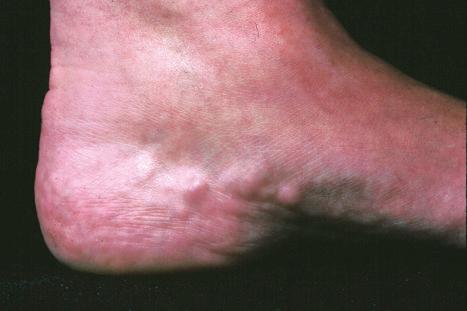
It is likely that trauma plays a role in the pathogenesis of the lesions. A biopsy from a papule shows normal adipose tissue herniating into the dermis. This may mimic an intradermal lipoma but the clinical setting allows a diagnosis to be made. Rarely, prominent myxoid change and vascular proliferation can be seen.
Lipomatosis of nerve (fibrolipomatous hamartoma of nerve, perineural fibrolipoma, perineural lipoma, intraneural lipoma) is a very rare hamartomatous condition usually occurring in children or young adults of either sex, around the wrists and hands, particularly along the distribution of the median nerve followed by the ulnar nerve and (less frequently) others including the brachial plexus and cranial nerves. Presentation at birth is sometimes seen. It can be associated with macrodactyly of the fingers innervated by the involved nerve in up to one-third of cases. Patients typically present with a slowly growing mass, which is either asymptomatic or associated with neurological symptoms including pain, paresthesia, loss of sensation or motor deficit. Carpal tunnel syndrome may develop when the median nerve is involved. Although the lesion is benign, treatment is difficult, as surgical excision often results in permanent neurological deficit.
The lesion is characterized by proliferation of mature fatty and fibrous tissue within the epineurium of a major nerve accompanied by prominent concentric perineural fibrosis ( Fig. 35.15 ). In a handful of cases involving cervical and thoracic spinal nerves, the pathology was restricted to circumferential growth of fat around the epineurium. Rarely, bone formation has been described.
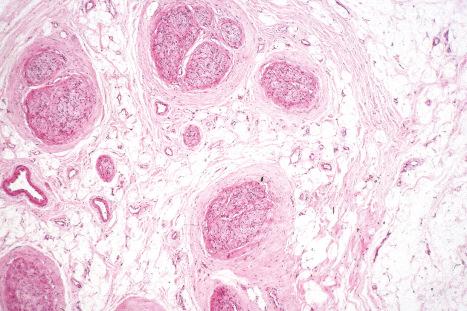
Lipoblastoma is the circumscribed subcutaneous counterpart of lipoma seen in infancy and childhood. Its diffuse form (lipoblastomatosis) is infiltrative and typically involves deeper structures, including muscle.
In either form, this condition most often presents in the first 9 years of life (exceptionally at birth, and 10% between the ages of 10 and 16), affects males more often than females, and is typified by a slowly growing, usually subcutaneous mass with size ranging from 1 to 15 cm. Occasional cases may clinically mimic a hemangioma. Most tumors involve the trunk and extremities, followed by the head and neck. Presentation in the retroperitoneum, mediastinum, and a number of internal organs including the kidney, lung, and heart occurs rarely. Intrascrotal tumors and association with accessory scrota have also been documented. In the infiltrative type, local recurrence can occur following incomplete excision in up to 19% of cases. Familial cases are noted. In about 17% of patients central nervous system anomalies are noted including macrocephaly, developmental delay, autism, Sturge-Weber syndrome, and seizures. Unusual associations include a patient with glomovenous malformations, epidermal nevus, temporal alopecia and heterochromia in addition to a lipoblastoma. A further rare association with cleft palate has been described.
One or more recurrences can occur in up to 46% of cases.
It has been shown that lipoblastoma has a consistent rearrangement of 8q11~q13, resulting in overexpression of the PLAG1 oncogene. Gene partners described as donating promoters include HAS2 , COL1A2 , COL3A1 , RAD51L1 and RAB2A . Rarely additional chromosomal numerical abnormalities, mainly excess copies of chromosome 8, can be found.
Lipoblastoma recapitulates developing fat and therefore contains varying proportions of mature adipocytes, lipoblasts and prelipoblasts arranged in a lobulated pattern and separated by loose fibrous connective tissue septa ( Figs 35.16 and 35.17 ). The stroma is often myxoid with numerous small capillaries giving a ‘crow's feet’ appearance ( Fig. 35.18 ) and may contain very primitive stellate or spindled tumor cells. Hibernoma-like tumors can be seen. Mitotic figures are uncommon; some cases show areas of extramedullary hematopoiesis.
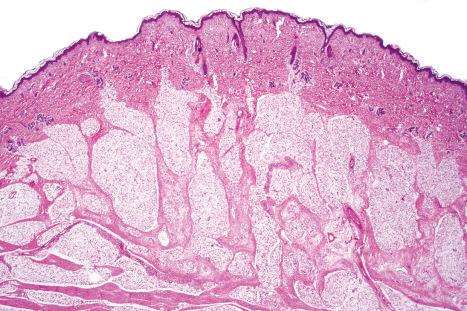
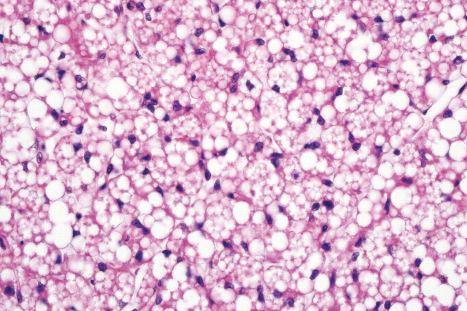
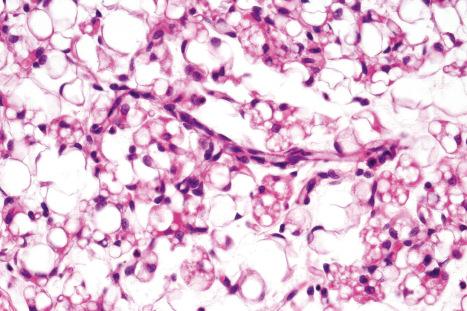
Positivity for S100 protein, CD34 and PLAG1 is seen. In addition desmin may be positive in the spindle cells. The degree of adipocytic differentiation does not predict risk of recurrence. p16 is positive in rare tumors.
Ultrastructural studies show adipocytes in different stages of development.
Distinction from myxoid liposarcoma, which is extremely rare in children, is made possible by the presence of prominent lobulation and the absence of nuclear hyperchromasia in lipoblastoma. Cytogenetics is very useful in allowing distinction between these tumors, as myxoid liposarcoma lacks rearrangement of 8q11~q13 and instead shows a consistent t(12;16)(q13;p11) involving the DDIT3 and FUS genes. Cytogenetics is also very useful in tumors mimicking ordinary lipoma and hibernoma. Human insulin injection may induce lipoatrophy with focal lipoblastoma-like changes.
A few cases of adipose tumors closely resembling lipoblastoma and presenting in the vulva of young to middle-aged patients have been described as lipoblastoma-like tumor of the vulva. Lesions present as a nondescript mass, several centimeters in diameter, sometimes associated with pain. Local recurrence is exceptional. Lesions are lobulated with prominent myxoid change and a rich branching vascular network. Tumor cells vary in proportion and consist of adipocytes, bland spindle-shaped cells, and uni- or multi-vacuolated lipoblasts. Mitotic activity is minimal. Focal positivity for CD34 may rarely be seen. There is usually negative staining for HMGA2 and PLAG1 (as opposed to lipoblastoma) and also for S100 protein, MDM2 and CDK4. Based on the usual loss of RB1 expression, it has been suggested that these tumors are more likely related to spindle cell lipoma rather than lipoblastoma.
Angiolipomas are benign lesions which, in contrast to simple lipomas, are seen most often in young adults and have a predilection for the subcutis of the upper limbs, particularly the forearm and less commonly the trunk. Oral, intra-articular, extradural, breast, and bronchial lesions are exceptional. Familial cases are rarely seen. Parenchymal, CNS and infiltrating intramuscular lesions are best regarded as variants of hemangiomas.
The lesions are typically tender or painful, less than 2 cm in diameter, and may impart a reddish or bluish discoloration to the overlying skin. They are more often multiple than solitary and treatment can be problematic. Multiple lesions have exceptionally been documented in association with diabetes mellitus and as a complication of antiretroviral therapy (particularly with indinavir and saquinavir) in acquired immunodeficiency syndrome (AIDS). A case of intravascular lymphomatosis as well as that of a B-cell lymphoma presenting in an angiolipoma have been documented. Metastatic melanoma within an angiolipoma has also been described. Giant angiolipomas are very rare.
Most cytogenetic studies in angiolipoma have consistently shown a normal karyotype. In only a few tumors cytogenetic abnormalities have been demonstrated including a one with 46,Y,t(X;2)(p22;p12), one with complete loss of a chromosome 13 and two with structural aberrations of chromosome 13 involving the q12~q14 bands. Interestingly, more recently, low-level mutations of protein kinase D2 was demonstrated in 80% of angiolipomas. Aberrant expression of HMGA2 has been documented.
The tumor, almost always encapsulated, is composed of mature adipocytes and varying proportions of irregular, anastomosing small blood vessels without endothelial atypia ( Fig. 35.19 ). Luminal microthrombi are invariably present ( Fig. 35.20 ). Although the blood vessels are usually seen in the periphery of the tumor, they may constitute most of the lesion. Such examples are known as cellular angiolipomas ( Figs 35.21 and 35.22 ).
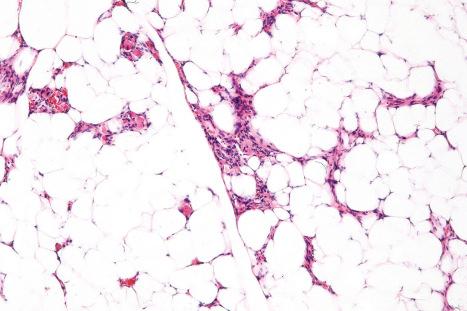
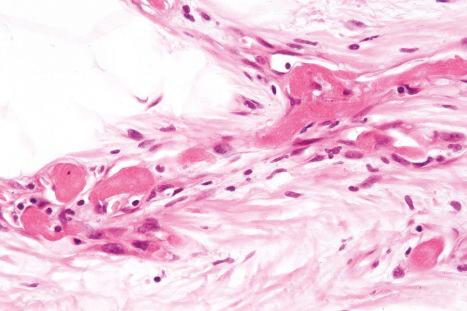
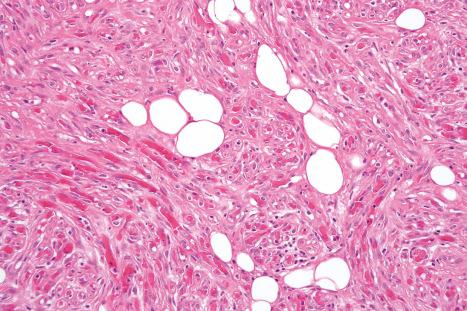
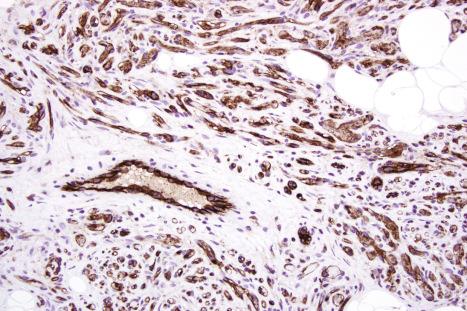
Cellular angiolipoma can be confused with a vascular tumor, especially immature capillary hemangioma and kaposiform hemangioendothelioma. The presence of mature adipocytes and capillaries with microthrombi allows distinction from immature capillary hemangioma. Kaposiform hemangioendothelioma may have capillaries with microthrombi in the periphery of tumor lobules, but mature adipocytes are absent.
Myolipoma, (extrauterine lipoleiomyoma) is a benign adipocytic neoplasm predominantly seen in adult women. Usually, it presents as an incidental, large (median size 10 cm), deep-seated mass in the retroperitoneum or abdomen and rarely in the pelvis or groin. Rarely, it may be seen as a smaller palpable subcutaneous lesion in the trunk and extremities.Complete surgical removal is curative.
Fusion of the HMGA2 and C9orf92 genes with t(9;12)(p22;q14) has been reported in one case. Myolipoma is well circumscribed with biphasic morphology; variable amounts of mature adipose tissue and well-differentiated smooth muscle fibers arranged in fascicles. Cytologic atypia is not seen. Necrosis is not observed. Unusual features include hypercellular fascicles, degenerative atypia, presence of hemosiderin or eosinophils, metaplastic bone or cartilage, and a round cell component. By immunohistochemistry the smooth muscle nature of tumor cells is confirmed by positivity for SMA and desmin. Nuclear positivity of HGMA2 is seen in 2/3 rd of cases.
Expression of estrogen and progesterone receptors has been reported.
Myolipoma must be differentiated from atypical lipomatous tumor/well-differentiated liposarcoma with smooth muscle differentiation based on the presence of cytologic atypia in the latter. Moreover, myolipoma is usually negative for MDM2 and CDK4. Angiomyolipoma is distinguished by the variable presence of thick-walled vessels and the expression of melanocytic markers, such as HMB45 and Melan-A.
Chondroid lipoma is a distinctive tumor that presents predominantly in adult females, with a predilection for the proximal extremities and limb girdles. Tumors in children are very rare. Lesions are usually small and arise mainly in deeper soft tissues and (less commonly) in the subcutis. Rare examples present in the oral cavity, nasopharynx, and pelvis. A case presenting within the peroneal nerve has been described. Clinical features are not distinctive. Tumors are benign and there is no tendency for recurrence after simple excision.
This tumor is characterized by t(11;16)(q13;p13) fusing C11orf95 and MLK2 .
The lesion is well circumscribed, lobular and often encapsulated. It consists of an admixture of mature adipocytes, uni- or multivacuolated lipoblasts and hibernoma-like cells with granular eosinophilic cytoplasm in a myxoid and chondroid matrix, which can show hyalinization ( Figs 35.23 and 35.24 ). Fibrosis and hemorrhage are often seen. The matrix is composed of chondroitin sulfate. Some tumor cells contain glycogen in the cytoplasm. Ossification is exceptional as is the presence of osteoclast-like giant cells.
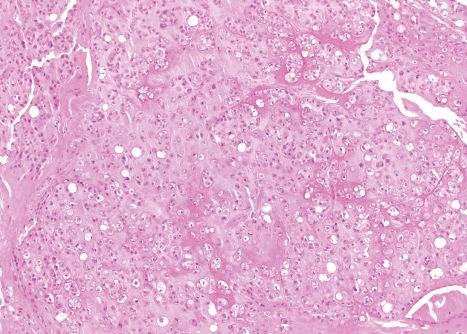
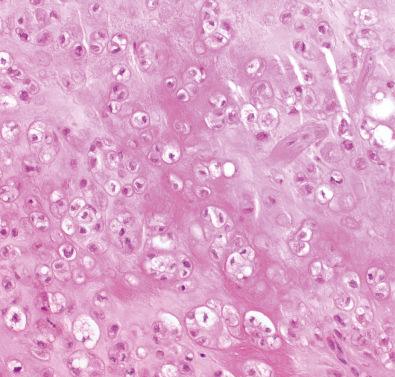
By immunohistochemistry, mature adipocytes are strongly positive for S100 protein; lipoblasts are only weakly positive for this marker. Chondroid lipomas show strong positivity for Cyclin D1. Cytokeratin is very rarely focally positive.
Electron microscopy confirms the presence of lipoblasts and mature fat cells. There is no evidence of true cartilaginous differentiation.
Myxoid liposarcoma usually lacks the presence of a ‘chondroid-like’ matrix and has a characteristic vascular pattern.
In myxoid chondrosarcoma there are no mature adipocytes, although some cells occasionally focally resemble lipoblasts.
Spindle cell lipoma is a comparatively uncommon variant and can be a source of histologic concern to the unwary. Pleomorphic lipoma represents a variant of spindle cell lipoma, from which it is clinically and cytogenetically indistinguishable; it is entirely benign.
Found predominantly in males, they arise mainly in the posterior portion of the neck, shoulder or upper back, and are characteristically seen in the sixth or seventh decade. Multiple lesions are rare and some are familial. Rare cases can occur at other locations including the foot, hand, buttock, flank, oral cavity (including the tongue), larynx, orbit, soft tissues of the perianal area, perineum, groin, aortic valve, mediastinum and breast. The last may represent an example of mammary-type myofibroblastoma of soft tissue, a lesion closely related to spindle cell lipoma. Interestingly, lesions in women commonly occur in atypical locations. They are more common on the extremities and face, are not infrequently dermal, and tend to occur at a younger age. They usually occur as a well-circumscribed, slowly growing, solitary, subcutaneous or (rarely, in up to 13% of cases) dermal lesion, less than 5 cm in diameter. Intramuscular presentation is very rare. A case has been reported at the site of an infantile fibrosarcoma treated with chemotherapy. Spindle cell lipoma is an entirely benign, nonrecurring lesion. Atypical spindle cell lipoma is a term proposed to refer to low-grade malignant adipose tumors with variable cellularity consisting of spindle cells with low to moderate cytologic atypia, adipocytes, lipoblasts, and myxoid stroma in varying proportions and with low potential for local recurrence (see below).
A number of chromosomal abnormalities have been found in spindle cell lipoma, identical to those found in pleomorphic lipoma. Monosomy or partial loss of chromosomes 13 and 16 are the most common alterations also seen in pleomorphic lipoma, strongly suggesting that these two lesions exist as a morphological continuum. Interestingly, similar loss of 13q has been found in mammary-type myofibroblastoma and cellular angiofibroma, suggesting a close link between these tumors. The 13q deletion seems to be involved in the activation of p38 mitogen-activated protein kinase induced by oxidative stress.
Subcutaneous lesions tend to be well circumscribed while dermal tumors are ill defined. Lesions located on the face usually display infiltration of skeletal muscle. In addition to mature univacuolated adipocytes, irregular collections of slender spindled cells are seen with pale eosinophilic cytoplasm, uniform nuclei and rare mitoses ( Fig. 35.25 ). Hyaline bundles of collagen and occasional giant cells may also be present, but lipoblasts are rarely identified. Mast cells are often numerous ( Fig. 35.26 ). The relative proportions of adipose tissue to spindled cells vary between individual cases ( Fig. 35.27 ). Some cases contain few or, rarely, no adipocytes at all. Vascularity also varies and focal hemangiopericytoma-like areas are sometimes seen. Extensive myxoid change can lead to striking degenerative features with a pseudovascular pattern in which papillary structures project into empty spaces ( Fig. 35.28 ). However, it has been shown that at least in some examples showing this change, the spaces are truly lined by endothelial cells, and these should be named angiomatous spindle cell lipoma. Prominent myxoid change is more common in lesions presenting in the oral cavity. In addition to the histologic features of spindle cell lipoma, pleomorphic lipoma is characterized by numerous hyperchromatic and irregular multinucleated giant cells, with nuclei often arranged in a concentric floret pattern (floret giant cells) ( Figs 35.29–35.31 ). Floret-like cells can also be seen in prolapsed orbital fat as a result of a degenerative process. Mitotic figures may rarely be evident and occasional multivacuolated lipoblasts are sometimes present ( Fig. 35.32 ). Lesions that show few or no adipocytes may pose a diagnostic challenge and this can be a feature of tumors with features of pleomorphic lipoma.
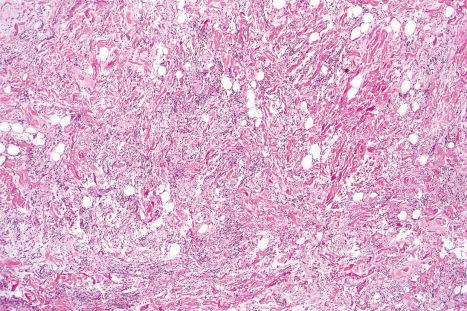
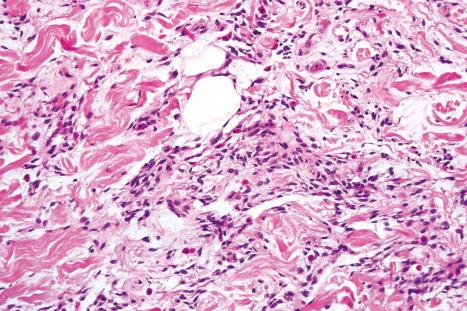
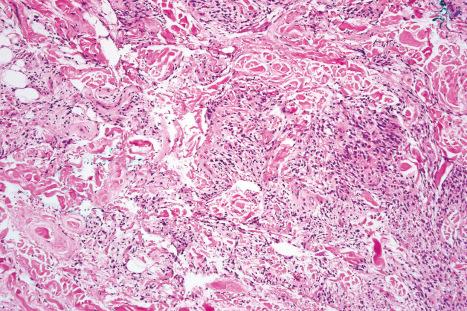
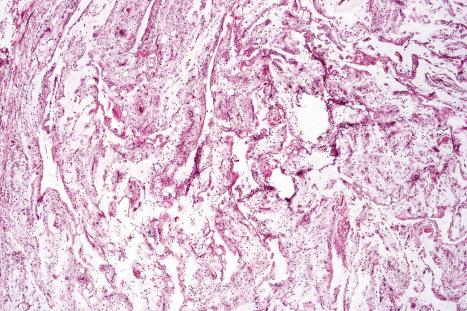
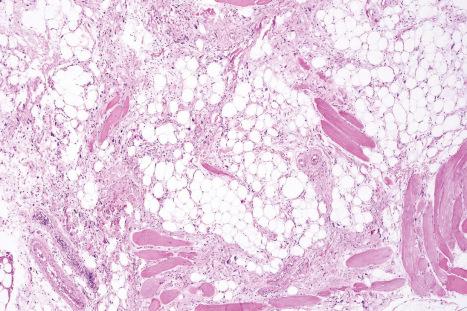
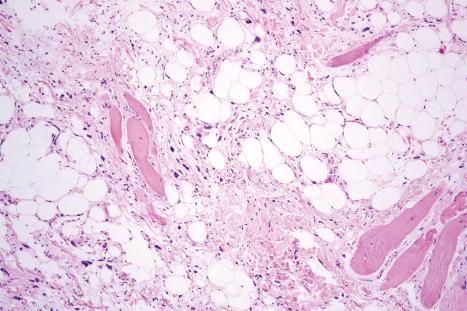
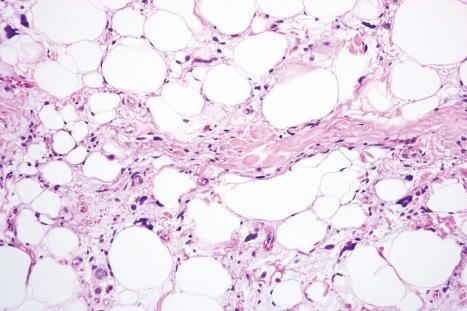
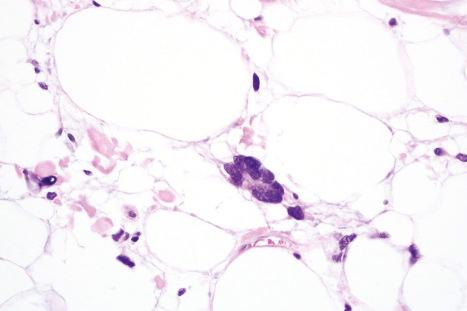
The spindled cells are positive for CD34 but usually negative for S100 protein. However, positivity in the spindle cells for the later has been reported in some cases. Estrogen receptor may be focally positive in some cases. Mature adipocytes are positive for S100. RB1 (retinoblastoma protein) is negative.
Ultrastructural studies show cells with features of mature adipocytes and spindled cells representing undifferentiated mesenchymal cells.
Although the clinical history may be sufficiently characteristic to aid the diagnosis, distinction from liposarcoma is made by the absence of either adipocytic atypia or variation in adipocyte size. Histologically comparable lesions involving deeper soft tissue should be classified as atypical spindle cell lipomatous tumor (previously termed spindle cell liposarcoma), reflecting their much greater tendency to recur.
Hibernoma is a rare, invariably benign tumor resembling normal brown fat, which typically occurs in young adults with a slight female predominance. The tumor most often presents in the interscapular region and thigh followed by the axillae, chest wall and head and neck. It is a slowly growing, highly vascular lesion that may attain a considerable size and is typified macroscopically by tannish-brown fatty tissue. The large majority of tumors are subcutaneous but about 10% of cases are intramuscular. Lesions are benign and there is no tendency for local recurrence.
In cytogenetic studies, hibernomas have shown consistent rearrangement at 11q13. Additionally, MEN1 and/or AIP loss have been described.
Hibernomas are classified histologically into four categories: typical (82% of cases), lipoma-like (7%), myxoid (9%), and spindled cell (2%). Typical hibernoma is characterized by an admixture of multivacuolated large adipocytes with central nuclei, large cells with granular eosinophilic cytoplasm and mature univacuolated adipocytes ( Fig. 35.33 ). They are usually encapsulated and lobulated, being subdivided by fine fibrous septa containing numerous small capillaries. Some cases have focal myxoid stroma and very few resemble spindle cell lipoma. In a subset of lesions large lipoblast-like cells mimicking atypical lipomatous tumors may be conspicuous.
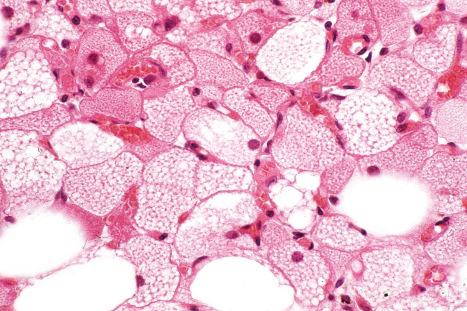
Tumor cells show variable staining for S100 protein; in the spindle cell variant, the spindled cells are CD34 positive. UCP1 positivity has been reported.
Distinction from a granular cell tumor is easy, as in the latter the cells are not vacuolated and there are no mature adipocytes. Lesions with lipoblast-like cells have areas that are otherwise typical of hibernoma and tumor cells are negative for MDM2/CDK4 .
Atypical lipomatous tumors are usually deep seated and may occur in the subcutaneous tissue, within skeletal muscle, the retroperitoneum, the mediastinum, and the spermatic cord. Visceral tumors are very rare. Subcutaneous tumors have a predilection for the legs (particularly the thighs) and the trunk. Patients are more often male and usually present in their sixth and seventh decades, complaining of a slowly growing, painless mass measuring several centimeters. Deep-seated tumors, particularly those arising in the retroperitoneum, are usually very large by the time they are discovered.
Most authors argue that the term ‘well differentiated liposarcoma’ should be reserved for deep seated tumors for which a complete surgical resection cannot usually be achieved: mediastinal, retroperitoneal and spermatic cord. These tumors frequently recur, as a result of incomplete excision, and can eventually undergo dedifferentiation.
Prognosis in atypical lipomatous tumors, as mentioned above, is closely related to site. Peripheral tumors are prognostically more favorable than their retroperitoneal counterparts: the smaller the tumor, the better the outlook. Subcutaneous tumors have a tendency for local recurrence due to incomplete excision but behavior is not aggressive and they do not metastasize unless they become dedifferentiated (see below). Dedifferentiation is exceptional in subcutaneous lesions. Adjuvant radiotherapy following resection of tumors located in the extremities and trunk was associated with a reduction of local relapse risk in a large study.
From the cytogenetic point of view, ring or giant marker chromosomes with integration of variable portions of the 12q13~15 interval characterize ALT. MDM2 at 12q15 is virtually universally amplified. CDK4 is also usually amplified. Other frequently co-amplified genes include HMGA2 , YEATS4, CPM and FRS2. ATF6 and DUSP12 amplification has been found in some cases with 1q21~25 amplicon.
Atypical lipomatous tumor has been traditionally subdivided into four variants: adipocytic, sclerosing, inflammatory and spindle cell. In the latest WHO classification (2013) however, the well-differentiated variant of spindle cell liposarcoma is no longer considered as a morphological variant of atypical lipomatous tumor. Strictly defined, the latter is likely to represent part of the spectrum of a distinctive variant of low-grade adipocytic neoplasm termed atypical spindle cell lipomatous tumor (see below).
Microscopically, the adipocytic lipoma-like type is characterized by an appearance very similar to mature adipose tissue, but with scattered moderate nuclear pleomorphism, which is most prominent in the fibrous stroma, along with variation in adipocyte size and a few lipoblasts ( Figs 35.34–35.36 ). Purely dermal lesions are rare.
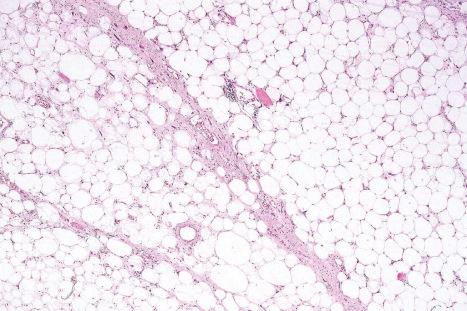
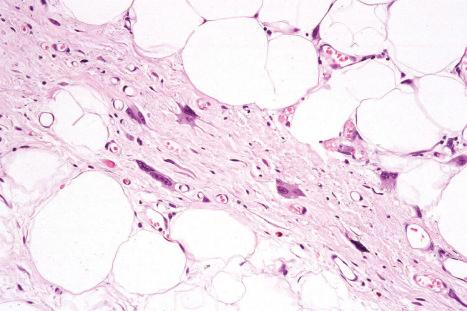
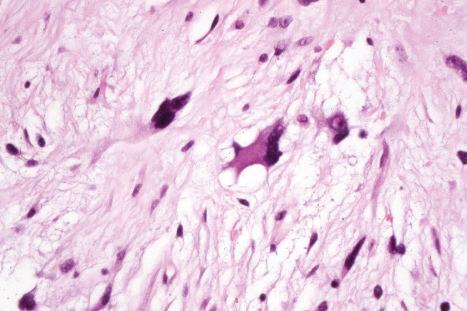
The sclerosing type is always deep seated and consists of variably fibrillary or sclerotic collagenous tissue containing bizarre, often multinucleated cells and rare lipoblasts ( Fig. 35.37 ). Both types show minimal, if any, mitotic activity. Atypical hyperchromatic cells are frequently seen in a perivascular location. Rare cases display a prominent mononuclear inflammatory cell infiltrate, often in a patchy distribution.
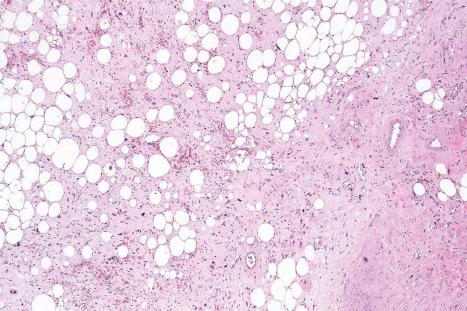
The inflammatory type, usually found in the retroperitoneum, displays a prominent mononuclear inflammatory cell infiltrate that can be so prominent as to obscure the real nature of the neoplasm.
A mixture of morphological variants can be seen in the same tumor, especially in the deep-seated ones. The presence of lipoblasts is not required nor establishes the diagnosis. Metaplastic elements including cartilage, bone, and smooth muscle are sometimes a feature and should not be confused with dedifferentiation.
Immunohistochemistry for MDM2 and CDK4 has been proposed as useful in the distinction of atypical lipomatous tumor/well-differentiated liposarcoma (ALT/WDLPS) from other benign lipomatous tumors. MDM2 and CDK4 tend to be positive in the former and negative in most of the latter. However, a recent study found that immunohistochemistry for both markers has a sensitivity below 50%. FISH and real-time PCR for amplification of MDM2 is a more reliable method. CISH or MLPA represent alternative sensitive methods. p16 has also been advocated as useful in the distinction between ALT-WDLPS and lipoma as the latter do not express this marker. However, the specificity is low and false positives may occur especially in small biopsies. S100 protein is positive in adipocytes and some lipoblasts.
Atypical lipomatous tumor (ALT) is distinguished from a lipoma by the variation in the size of the adipocytes and the presence of cells with hyperchromatic nuclei in the former condition. The changes seen in massive localized lymphedema associated with morbid obesity can mimic an atypical lipomatous tumor but the former lacks adipocytes with atypia and consists of large lobules of mature adipocytes with edema, thick septa and vascular proliferation within the septa. Subconjunctival herniated orbital fat may be confused with an ALT, as the former often contains multinucleate floret-like giant cells (a mimic of pleomorphic lipoma), fibrous tracts and Lockhern cells. However, atypical cells within fibrous septae are absent in subconjuctival herniated fat.
Atypical spindle cell lipomatous tumor is a distinct variant of lipomatous tumor of intermediate malignancy previously described under terms such as atypical spindle cell lipoma, spindle cell liposarcoma, well-differentiated spindle cell liposarcoma, and fibrosarcoma-like lipomatous neoplasm. Tumors present as an asymptomatic or rarely painful subcutaneous or deep-seated mass, several centimeters in diameter, mainly in middle-aged males and with predilection for the limbs (hands and feet) and limb girdles. Local recurrence is seen in about 12% of cases but there is no metastatic potential.
Only up to 50% of lesions are associated with heterozygous deletions of RB1 correlating with loss of RB1 expression on immunohistochemistry. The histologic spectrum is wide and varies from hypocellular lesions with spindle cells displaying mild cytologic atypia, few mature adipocytes and prominent myxoid stroma to more cellular lesions, with spindle cells displaying mild to moderate cytologic atypia, lipoblasts, and less prominent stroma ( Figs 35.38–35.41 ). A subset of tumors mimicking pleomorphic lipoma and referred to as atypical pleomorphic lipomatous tumor is probably part of the same spectrum. Our understanding of this tumor group and its morphological spectrum as well as molecular pathogenesis continue to evolve.
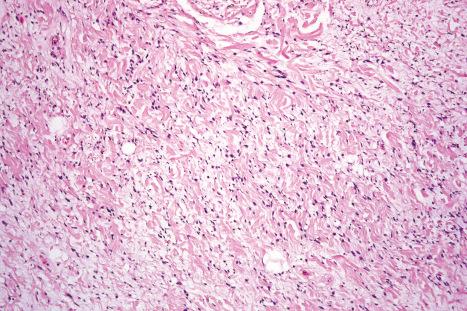
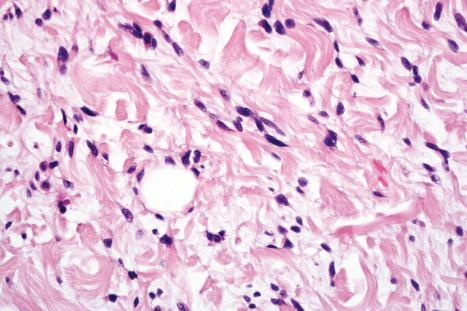
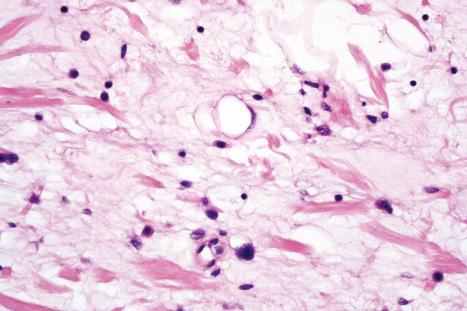
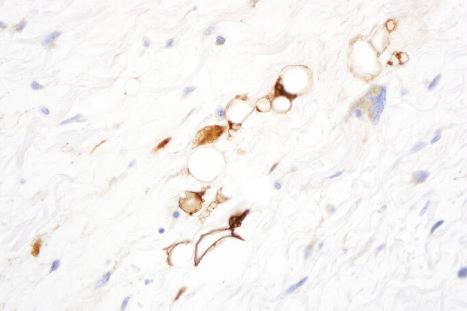
By immunohistochemistry, the spindle cells frequently express CD34 in up to two-thirds of cases, they are positive for S100 protein in about 40% of cases and for desmin in about one-fifth of cases. MDM2 and CDK4 are rarely focally and weakly positive in tumor cells but are not co-expressed in the same tumor and not amplified genetically.
Often this lesion is misdiagnosed as a low-grade malignant peripheral nerve sheath tumor, dermatofibrosarcoma protuberans, spindle cell lipoma, mammary-type myofibroblastoma, and fat-forming solitary fibrous tumor. Distinction from what some term low-grade dedifferentiated liposarcoma is important because of the difference in behavior. In the latter, there is usually abrupt transition between a hypocellular and hypercellular tumor, there is more pleomorphism, and tumor cells display prominent diffuse positivity for MDM2 and CDK4.
Despite being one of the most common soft tissue sarcomas, liposarcoma presents infrequently as a primary subcutaneous lesion and only exceptionally as a primary dermal tumor.
Liposarcoma is traditionally divided into three subtypes:
well-differentiated / dedifferentiated
myxoid, which includes the cellular (previously termed round cell) variant,
pleomorphic.
Dedifferentiation refers to a biphasic tumor containing an atypical lipomatous tumor and a sarcomatous undifferentiated component of variable grade. Dedifferentiation occurs mainly in deep-seated tumors (particularly those occurring in the retroperitoneum) and is exceptional in subcutaneous lesions.
Myxoid liposarcoma occurs in adults, with a peak incidence between the fourth and fifth decades of life, and has no sex predilection. Although rare in children and adolescents, it is the most common type of liposarcoma in this age group. The majority of tumors arise in deep soft tissues, subcutaneous tumors being very rare. The most common site is the lower limb, particularly the thigh. All tumors, without exception, tend to local recurrence, and metastases occur in approximately one-third of cases depending on the grade. The presence of a cellular (previously termed round cell) component, necrosis and p53 overexpression has been found to be associated with poor prognosis. The terminology of round cell liposarcoma is no longer favored under the WHO classification as round cell is not the only morphology adopted by the cellular (higher grade) variant of myxoid liposarcoma.
Pleomorphic liposarcoma is the least common variant of liposarcoma. There is no sex predilection, patients are elderly and tumors are deep seated, presenting mainly on the limbs. Only exceptional tumors occur in the dermis or subcutis. Tumors grow rapidly and there is a high tendency for local recurrence and metastasis. While being by a wide margin the least common liposarcoma in deep soft tissue, it may be the most common liposarcoma to occur as a cutaneous primary.
Dedifferentiated liposarcoma shares the same cytogenetic alterations with atypical lipomatous tumor (well-differentiated liposarcoma), namely a ring or giant marker chromosome associated with amplification and overexpression of the 12q13~15 region containing MDM2 . In addition, JUN (1p32), ASK1 (6q23) and TAB2 (6q25) amplification can be seen..
Myxoid/round cell liposarcomas show a specific t(12;16)(q13;p11) fusing DDIT3 and FUS . In a small subset of cases a t(12;22)(q13;q12) has been found where EWSR1 substitutes for FUS . These translocations are seen in virtually all cases.
No consistent cytogenetic abnormality has been demonstrated in pleomorphic liposarcoma, which often shows complex cytogenetic abnormalities with TP53 mutations.
Dedifferentiated liposarcoma is defined as a well-differentiated liposarcoma showing abrupt transition to a higher grade nonlipogenic sarcoma. Less frequently the transition may be to a non-lipogenic low-grade sarcoma, but this terminology and the behavioral features are debated. In some cases, a well-differentiated area cannot be identified. Focal lipoblastic differentiation may be seen within the dedifferentiated areas. This change can occur in a primary tumor and less often in a recurrence. Although in most cases the dedifferentiated component is pleomorphic, there are often focal less atypical areas that may mimic other tumors such as dermatofibrosarcoma protuberans. Moreover, local recurrences of dedifferentiated liposarcoma may be well-differentiated. Meningothelial-like whorls have also been documented. Heterologous differentiation including osteosarcomatous, chondrosarcomatous, myogenic, and angiosarcomatous components is rarely seen. Positive diffuse staining of MDM2 and/or CDK4 is a constant finding.
Myxoid liposarcoma is composed of fairly uniform stellate or spindled cells with small vacuoles set in a myxoid matrix composed of acid mucopolysaccharide ( Figs 35.42–35.45 ). Mucin pooling, producing a lymphangioma-like pattern, is common. Emphasis should be placed on the presence of a complex plexiform network of small thin-walled capillaries in a pattern resembling chicken-wire or ‘crow's feet.’ Mitoses are sparse. Lipoblasts are most easily identified at the periphery of the tumor. Occasionally, extramedullary hematopoiesis may be seen. The presence of more cellular areas composed of uniform oval-to-round larger cells with hyperchromatic nuclei and inconspicuous cytoplasm indicates round cell change. This is associated with more aggressive behavior and such lesions are known either as combined myxoid and round cell liposarcoma or as high-grade myxoid liposarcoma ( Figs 35.46 and 35.47 ). The round cell component may predominate. Pure round cell liposarcomas are extremely rare in the subcutis, but mixed tumors are occasionally seen. Dedifferentiation in myxoid liposarcoma is exceptional. S100 is positive in lipoblasts and variably positive in the round cell component. Immunohistochemistry for the cancer testis antigen NY-ESO-1has been reported to be consistently positive in this group of tumors but not in other lesions that may be confused with them.
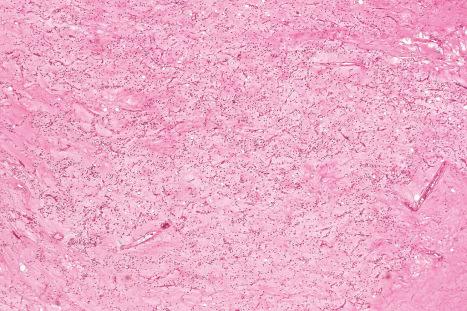
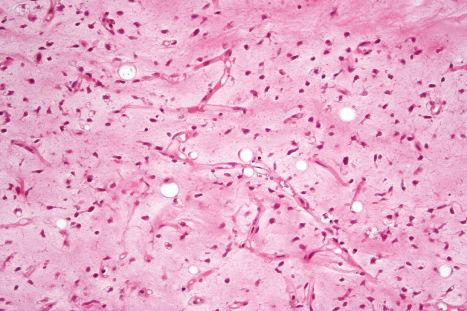
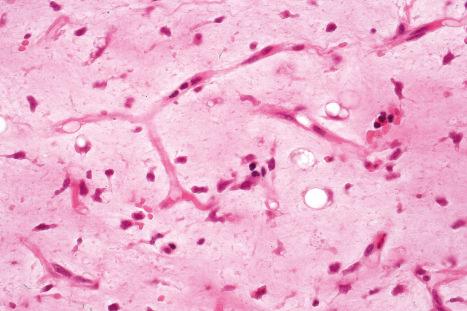
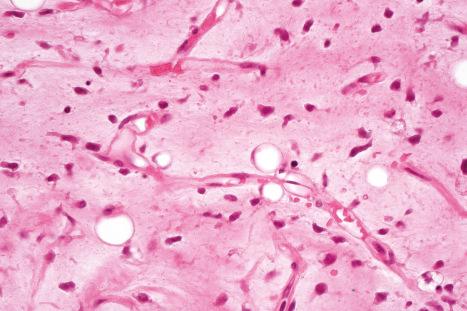
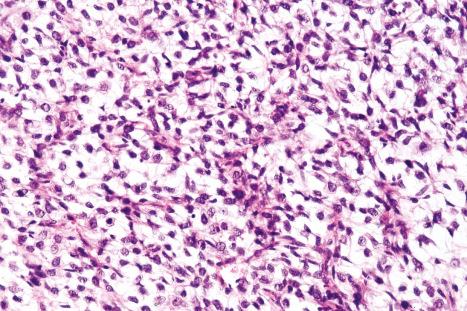
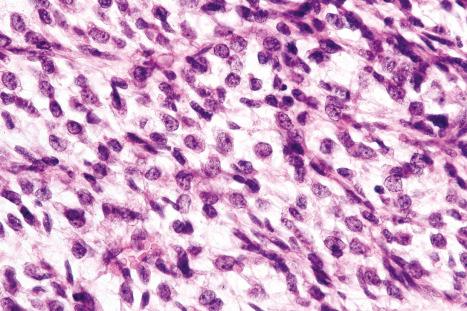
Pleomorphic liposarcoma consists of highly pleomorphic spindle cells, lipoblasts, and numerous multinucleated multivacuolated giant cells ( Fig. 35.48 ). Identification of lipoblasts is vital in distinguishing this variant from other pleomorphic sarcomas.
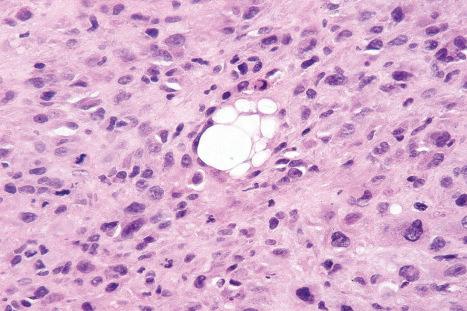
Lipoblasts are variable present within all of these lesions and can be absent or very difficult to find in myxoid and well-differentiated liposarcoma. By definition, they are absent in the dedifferentiated liposarcoma component which is nonadipocytic. In exceptional cases, the dedifferentiated portion of liposarcoma can have a pleomorphic liposarcoma-like component, but 12q15 amplification and MDM2 and CDK4 expression are maintained. In pleomorphic liposarcoma proper, lipoblasts can range from diffusely present to very rare and focal. Typically, lipoblasts are highly variable in size, contain more than one well-defined or punched-out lipid vacuole, and have irregular, hyperchromatic (and sometimes multiple) nuclei, the margins of which are scalloped by the fat droplets.
Nuclear positivity for MDM2 and or CDK4 will help establish the diagnosis of dedifferentiated liposarcoma in most cases (see also atypical lipomatous tumor ). Myxoid liposarcoma is distinguished from other sarcomas by its distinctive vessel morphology. In difficult cases molecular confirmation may be necessary. Myxofibrosarcoma (myxoid malignant fibrous histiocytoma) is recognized by the lack of lipoblasts and the presence of more variable pleomorphism than present in myxoid liposarcoma. Distinction from lipoblastoma may be very difficult or impossible. However, liposarcoma is very rare in children and, in difficult cases, cytogenetic studies may be helpful (see lipoblastoma ). The diagnosis of pleomorphic liposarcoma is based on the identification of lipoblasts in the background of a pleomorphic sarcoma and a lack of MDM2 and/or CDK4 nuclear positivity.
Hypertrophic scars occur most frequently on the head and neck, chest, knees and shoulders and show no racial predilection. Clinically, they may be distinguished from keloids by being less raised and not extending beyond the boundaries of the initiating injury. Unlike keloids, hypertrophic scars are far less prone to recur after treatment, but, in fact, precise distinction between these two lesions is not always possible and they represent a continuous spectrum.
Hypertrophic scar appears to be induced by over-activation of dermal wound healing pathways, in some ways similar to that of keloids below. Transforming growth factor beta 1 has been associated with the induction of both hypertrophic scars and keloids by inducing production of collagen by fibroblasts particularly in early stages. It has been proposed that abnormal blood vessel regulation may predispose to keloid and hypertrophic scar formation. The Wnt pathway is activated as well, particularly in the proliferative phase.
The appearances are typified by a somewhat non-specific dermal fibroblastic proliferation, which is often associated with epidermal atrophy ( Figs 35.49–35.51 ). They tend to be more cellular than keloids, and hyalinized collagen fibers are far less prominent. Mitoses are sometimes noted. A nodular growth pattern is common. Evidence of a foreign body granulomatous reaction may sometimes be present.
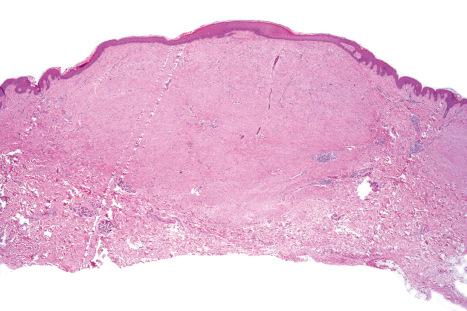
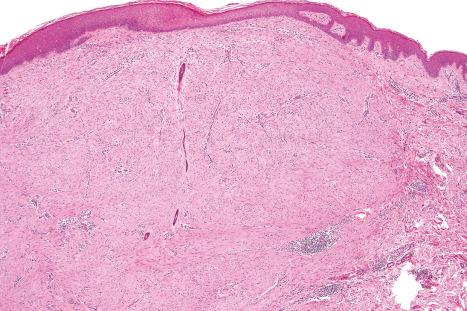
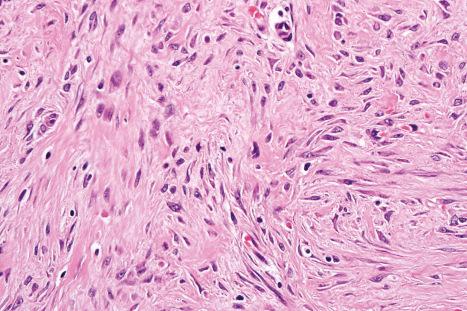
A keloid is a common reactive lesion that represents exuberant scar formation. It typically extends beyond the site of original injury. Although keloids occasionally appear to arise spontaneously, it is believed that most develop as a direct result of local trauma, even if minor or unnoticed ( Figs 35.52–35.54 ). Keloids also develop as a result of inflammation in conditions such as acne vulgaris. The use of isotretinoin has also been linked to the development of keloids. Eruptive keloids associated with aromatase inhibitor therapy, after chickenpox and as a paraneoplastic phenomenon, have been reported. Although these lesions may arise at any age, they are most common in adolescents and young adults; they occur at least four times more frequently in patients of African descent and show a slight predilection for females. A positive family history is not uncommon and probably reflects a genetic predisposition to keloid formation.
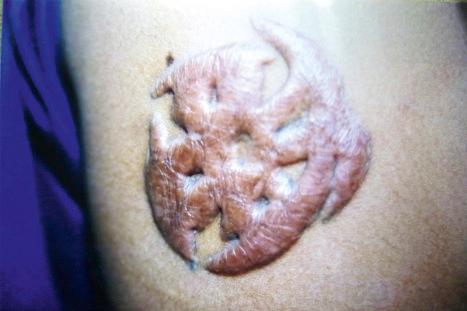
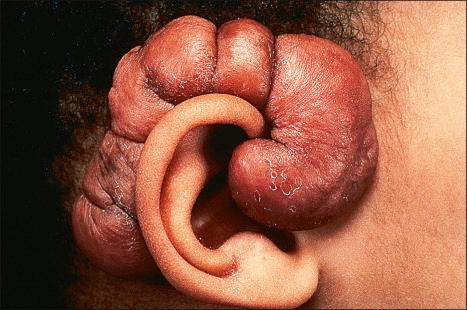
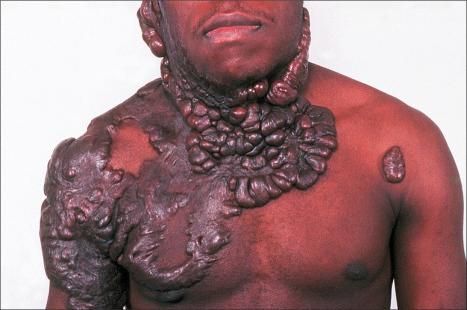
Keloids usually occur on the head and neck (especially the ear), upper chest and arms, but may be seen at almost any cutaneous site although areas such as the hands and feet and the genitalia are very rarely affected. Characteristically, they present as raised, well-circumscribed, rather smooth lesions, becoming progressively more indurated as time passes. They are occasionally itchy or tender and may be multiple, again reflecting individual susceptibility to their development. Irrespective of the treatment used, local recurrence is very common.
The pathogenesis of keloids is not clear but seems to be multifactorial (see also under hypertrophic scar). Genetic predisposition and local tissue tension play an important role. Collagen synthesis is increased in keloids and the quality of the collagen produced is also different from that in normal skin. Apoptosis is reduced in fibroblasts in keloids. There is an increased production of collagen I and III as demonstrated by an increase in levels of mRNA. Transforming growth factor beta (TGF-β) seems to play an important role in wound healing and its increased production has been linked to the pathogenesis of keloids by activating the synthesis of collagen by fibroblasts. The Wnt/β-catenin pathway associated with fibrosis and normal wound healing is strongly up-regulated and epigenetic changes affecting multiple profibrotic pathways are noted.
The interaction between keratinocytes and fibroblasts appears to play an important role in the formation of keloids. It has been demonstrated that when keloid fibroblasts are co-cultured with keloid keratinocytes there is increased production of soluble and insoluble collagen and procollagen III mRNA up-regulation.
The histologic appearances are typified by a nodular fibroblastic proliferation and the presence of hypocellular, ‘glassy’, eosinophilic, thick hyalinized collagen fibers in the dermis ( Figs 35.55 and 35.56 ). Early lesions may show a slight vascularity and foci of myxoid ground substance. Normal mitoses may occasionally be seen.
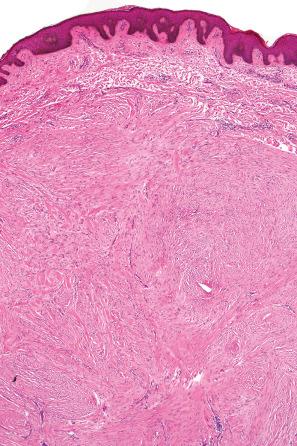
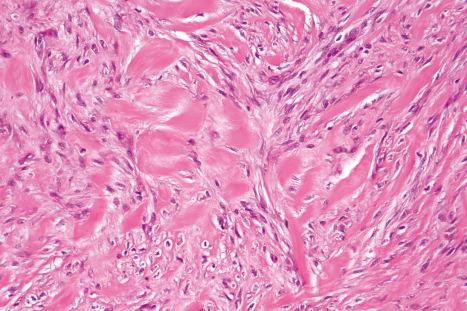
Nodular fasciitis is uncommon and represents a florid proliferative reactive process of unknown etiology. It is most often seen in young or middle-aged adults of either sex, particularly on the limbs (especially the forearms) or trunk. Cases in children including newborns are rare and tend to favor the head and neck area (including the external auditory canal and oral cavity). The lesion presents as a rapidly growing, subcutaneous nodule rarely exceeding 4–5 cm in diameter, and is typically painful or tender. Purely intramuscular lesions may rarely occur. The tumor develops with such speed that most patients present within 3 months of first becoming aware of a mass. Local recurrence may be a feature, but is sufficiently infrequent that its occurrence should raise the possibility of misdiagnosis. Recurrence seems to be more common in lesions of the head and neck mainly in children and in lesions presenting in the auricle. Spontaneous regression may occur. Intraneural and intra-articular lesions are very rare. A case of nodular fasciitis developing at the margin of a second stage Mohs excision of a dermatofibrosarcoma protuberans has been described. A case associated with etanercept therapy for psoriasis is probably coincidental.
An exceptional case of nodular fasciitis with malignant behavior including multiple recurrences and metastatic spread and associated with PPP6R3-USP6 amplification has been described.
Initial studies of nodular fasciitis showed evidence of clonality, suggesting that the lesion is neoplastic. Identification of an MYH9-USP6 gene fusion has firmly established its neoplastic nature, and the tumor has been regarded as an example of transient neoplasm. That is, the tumor has self-limiting growth followed by regression. Several additional novel fusion partners have been identified that use the promoters of genes other than MYH9 to drive USP6 overexpression.
Nodular fasciitis is typified by a relatively well-circumscribed but unencapsulated mass composed of plump spindled cells set in a loose myxoid and collagenous stroma with a typically feathery, microcystic appearance ( Figs 35.57–35.60 ). Numerous thin-walled blood vessels, often lined by rather prominent endothelial cells, ramify through the lesion, usually in a radial arrangement. Foci of hemorrhage and a sparse chronic inflammatory infiltrate composed largely of lymphocytes are usually present, and occasional cases contain foamy histiocytes and multinucleate osteoclast-type giant cells. The plump spindled cells ( Figs 35.61–35.63 ) are mitotically active, but the mitoses are never atypical. The degree of cellularity and relative amounts of collagenous tissue and loose edematous stroma vary between lesions, probably reflecting the duration of the process. Extension into skeletal muscle is rare and mainly seen in lesions of the head and neck.
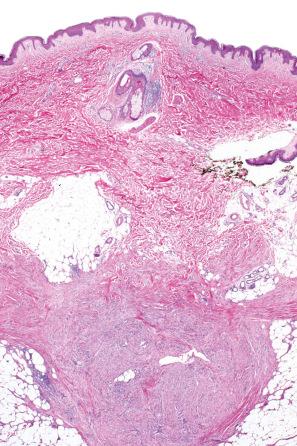
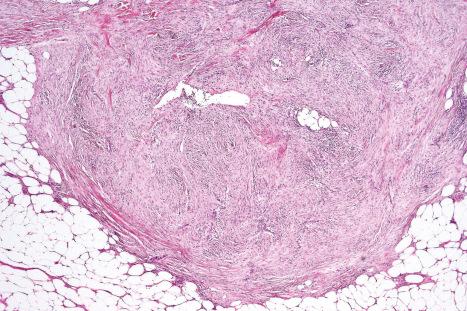
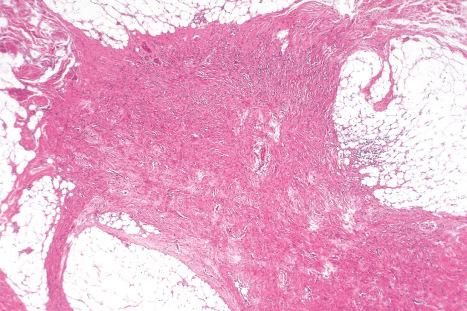
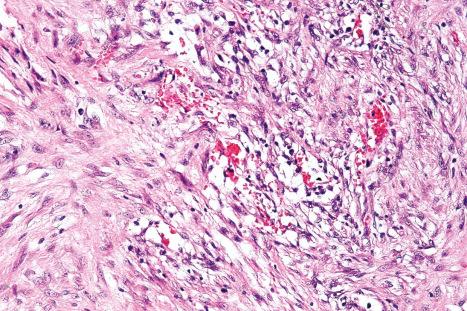
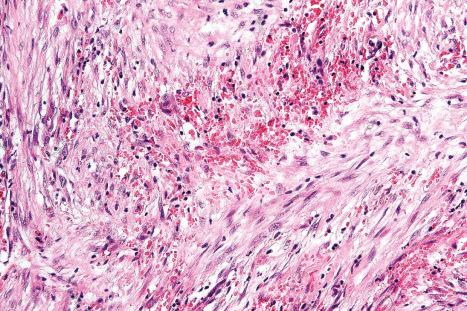
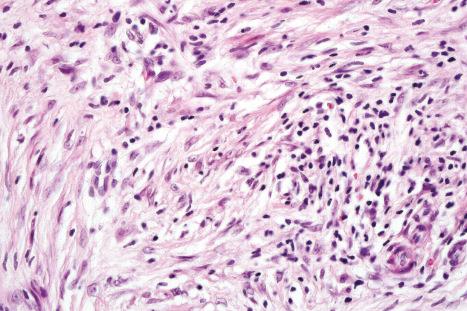
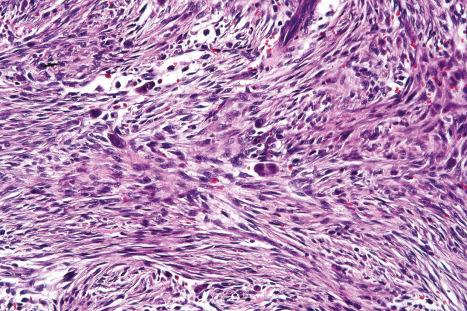
Immunohistochemistry shows diffuse and strong positivity for smooth muscle actin and usually also calponin, but desmin and h-caldesmon are usually negative, in keeping with myofibroblastic differentiation ( Fig. 35.64 ).
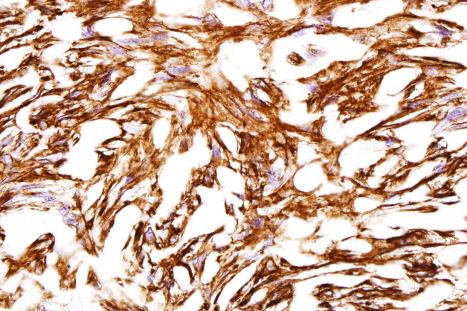
Ultrastructurally, the tumor cells have abundant rough endoplasmic reticulum and contain aggregates of filaments with dense bodies deep to the plasma membrane ( Fig. 35.65 ).
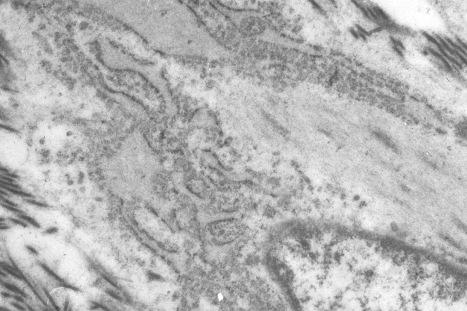
Intradermal fasciitis refers to a very rare variant of fasciitis that primarily arises in the dermis with only focal extension into the subcutaneous tissue. A polypoid architecture is exceptional. Lesions on the ear may rarely extend into the underlying cartilage. Histologic features are identical to those of the classic variant ( Figs 35.66–35.68 ) and tumors display the same molecular abnormality as that seen in the soft tissue counterparts.
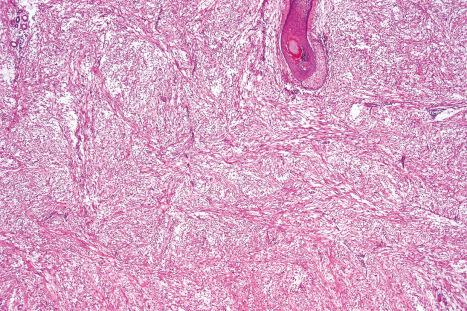
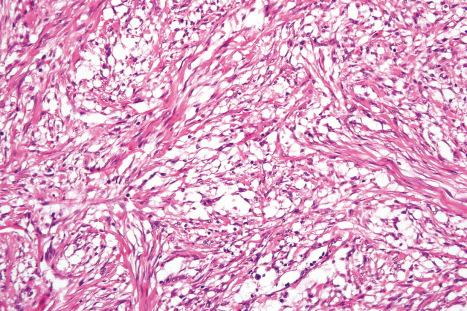
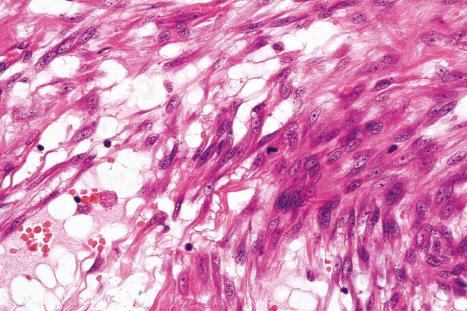
Fasciitis ossificans describes the small proportion of cases of nodular fasciitis that show metaplastic formation of osteoid, mature bone or even cartilage. A zoning pattern of maturation, as seen in myositis ossificans, is usually absent. In some cases, osteoid formation is only focal and calcification may be absent. Fibro-osseous pseudotumor of the digits is described below.
Periosteal fasciitis arises from the periosteum and most often presents on the head of children (usually under the age of 2 years and with predilection for males). It is then known as cranial fasciitis when there is significant erosion of bone. While histologically related to nodular fasciitis, it is not clear that this entity harbors the same fusion gene in the authors’ experience.
Proliferative fasciitis is described below.
Intravascular fasciitis is a very rare lesion seen most often in young adults. Intraoral cases have been described. Although histologically very similar to typical nodular fasciitis, it involves the full thickness and lumen of a peripheral blood vessel (usually a vein), and therefore simulates vascular invasion. To avoid a diagnosis of malignancy, careful attention should be paid to the bland histologic features.
Ultrastructural studies show cells with features of fibroblasts and myofibroblasts.
Features that should raise the possibility of malignancy in diagnostically difficult lesions include abnormal mitotic figures, nuclear hyperchromasia or pleomorphism and necrosis. The dermal variant of nodular fasciitis can be distinguished from benign fibrous histiocytoma because the latter is more polymorphic and actin tends to be only focally positive or negative.
Proliferative fasciitis tends to occur in older adults and quite often affects the subcutaneous tissue of lower limbs, but is otherwise clinically similar to typical nodular fasciitis. Regression, sometimes rapid, may occur. Intradermal lesions are exceptional. Intravascular lesions have been reported. Proliferative myositis is closely allied to proliferative fasciitis. It is a deep intramuscular lesion, which represents the deep counterpart of proliferative fasciitis; it is therefore rarely encountered in dermatology. It usually occurs in the fifth and sixth decades, and most often affects the trunk or proximal upper limbs. Presentation in children is rare. Both are regarded as a reactive conditions of rapid onset and are entirely benign. Most tumors are only a few centimeters in diameter. Simple excision is curative.
Cytogenetic studies have been reported in three cases of proliferative myositis. In two of them the presence of trisomy 2 was demonstrated and, in one, a t(6;14)(q23;q32) was identified. It is not clear that proliferative fasciitis or myositis harbor the MYH9-USP6 fusion characteristic of nodular fasciitis. Histologically, proliferative fasciitis is characterized by the presence of numerous basophilic ganglion-like giant cells, which are often multinucleated and may be mitotically active ( Figs 35.69 and 35.70 ). Distinction from pleomorphic rhabdomyoblasts is afforded by the cytoplasmic basophilia, short history, and usually superficial nature of proliferative fasciitis.
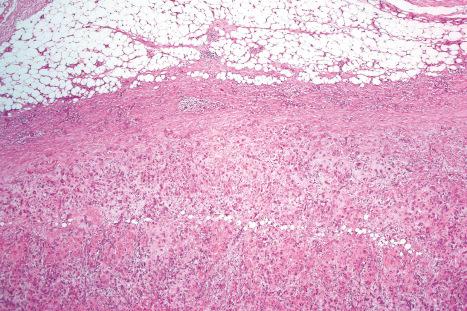
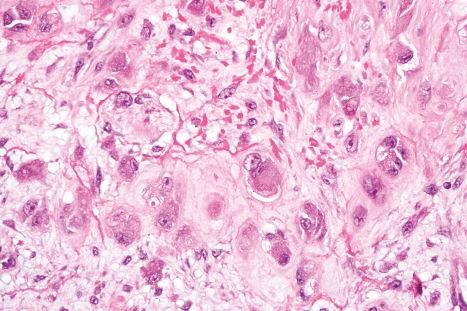
Histologically, proliferative myositis is characterized by proliferating spindled cells and large basophilic ganglion-like cells distributed within the fibrous tissue septa surrounding and dividing striated muscle fibers. These fibers are displaced rather than destroyed by the tumor and lesional cells alternating with skeletal muscle fibers produce a typical ‘checkerboard’ pattern ( Figs 35.71 and 35.72 ). Normal mitotic figures are commonly found. Bone and cartilage may occasionally be seen. Lesions in children tend to be more circumscribed, are more cellular and may show necrosis.
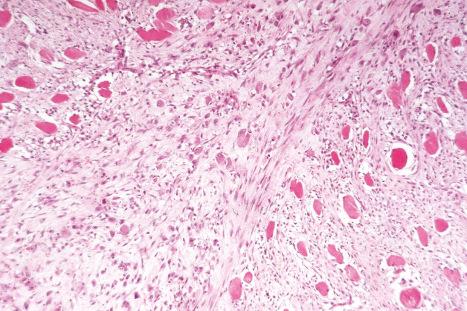
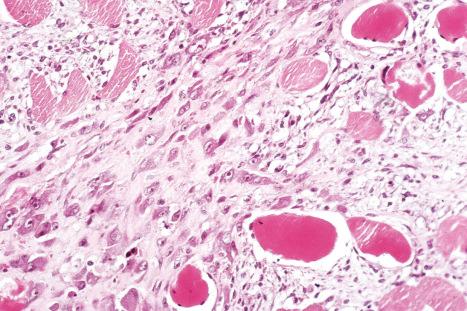
The spindle-shaped proliferating cells are positive for actins (SMA and MSA) but negative for desmin, whereas the ganglion-like cells may be negative for actins and are negative for neural and epithelial markers.
Electron microscopy studies indicate that these cells have features of fibroblasts. The flow cytometry profile of these lesions is diploid.
Distinction from a sarcoma may be difficult in small lesions, especially if close clinicopathological correlation is lacking. Most sarcomas have a larger size and although a ‘checkerboard’ appearance may be present in sarcomas or metastatic carcinomas, this is usually only focal and there is more tendency towards destruction of the surrounding muscle. A desmoid tumor lacks ganglion-like cells and usually replaces the muscle completely.
This is a reactive myofibroblastic proliferation with bone formation, which occurs almost exclusively on the digits ( Fig. 35.73 ). It presents predominantly in young to middle-aged adults, with predilection for females. Cases in adolescents are rare. The fingers, particularly the proximal phalanx of the index finger are by far much more commonly affected than the toes. A single identical lesion occurred on the forehead. The lesion grows rapidly (within a period between 2 to 6 weeks) and it is not attached to bone. There is no tendency for local recurrence.
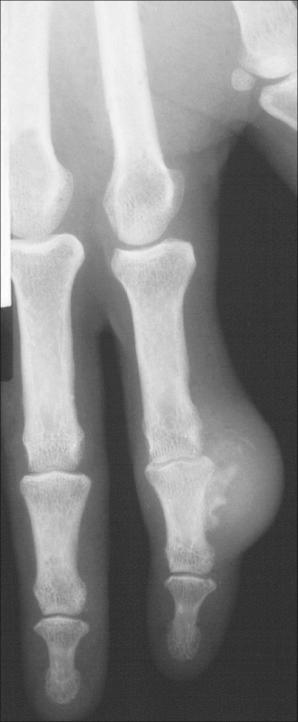
The condition is more common in individuals exposed to repetitive manual labor. It likely represents a superficial counterpart of myositis ossificans.
The tumor is ill-defined and similar to nodular fasciitis, except for the fact that there is formation of osteoid and mature bone ( Figs 35.74–35.76 ). Edematous stroma, vascular proliferation and bundles of spindle-shaped myofibroblast-like cells are seen intermixed with osteoid and mature bone. Mitotic figures are present and their number depends on the age of the lesion. Proliferating cells are positive for smooth muscle actin and calponin.
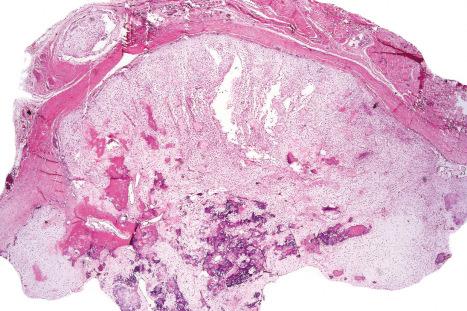
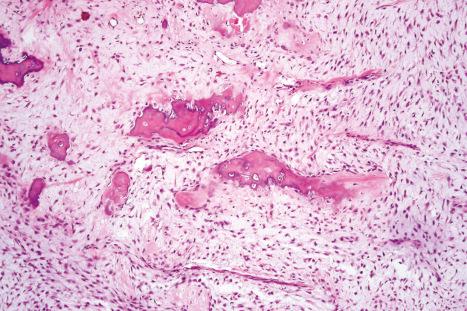
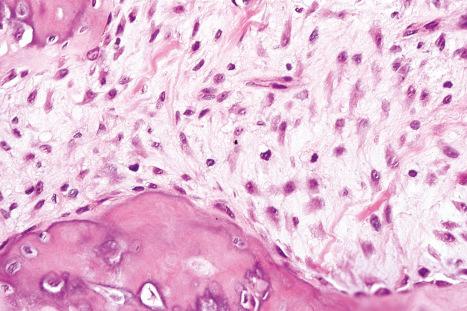
Ischemic fasciitis (also known as atypical decubital fibroplasia) is a relatively rare pseudosarcomatous fibroblastic/myofibroblastic condition that occurs over bony prominences. The great majority of patients are elderly (between the sixth and ninth decades of life) and immobilized. However, cases in ambulatory and even in young patients have been described. Lesions consist of an asymptomatic, subcutaneous, ill-defined mass only occasionally associated with ulceration. The majority of lesions arise in the deep subcutaneous tissue but involvement of the dermis and deeper soft tissues including skeletal muscle and tendons may also be seen. Exclusive involvement of skeletal muscle is very rare. Most tumors are less than 4 cm in diameter but larger lesions also occur. The usual sites are the shoulders, thighs, buttocks, sacral area and chest wall. Local excision is generally curative and recurrences are only seen in patients where the predisposing factor persists. A case of ischemic fasciitis associated with bizarre parosteal osteochondromatous proliferation has been documented.
The proliferation is thought to be due to ischemia induced by pressure resulting from prolonged immobilization. However, a recent study has not consistently found immobility or debilitation. Some cases are triggered by trauma.
Histologically, lesions are multilobular and characterized by replacement of the subcutaneous tissue by areas of fibrinoid necrosis and granulation tissue ( Figs 35.77 and 35.78 ). Myxoid change, hemorrhage and edema are usually prominent. In the areas of necrosis there is marked fibrinoid change and ghosts of necrotic adipocytes are seen. At the periphery there is vascular proliferation accompanied by variable numbers of spindle-shaped and more round cells with irregular hyperchromatic nuclei and a single prominent basophilic nucleolus. Ganglion-like cells similar to those present in proliferative fasciitis are also found and in these the nuclei contain smudged chromatin ( Fig. 35.79 ). Mitotic figures may be found but atypical forms are generally not seen. Thrombosis of blood vessels is also a feature.
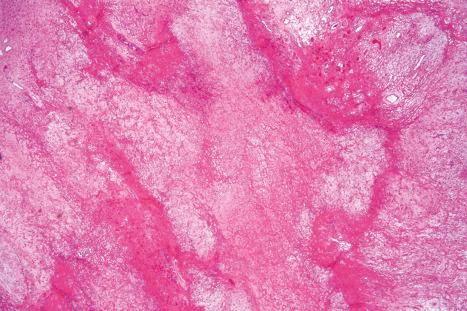
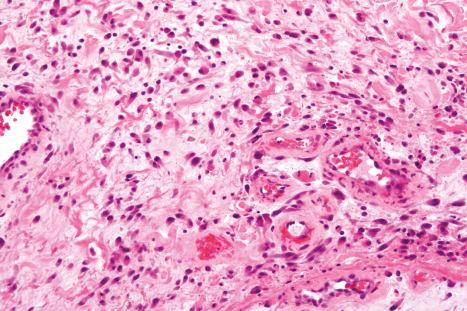
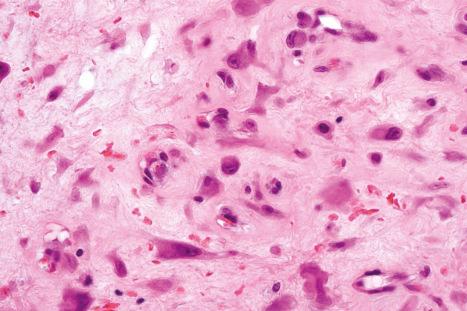
Immunohistochemistry shows that the cells in the proliferation are variably positive for smooth muscle actin (SMA), calponin and desmin. In rare cases positivity for MDM2, CDK4 and p16 can be seen.
As already discussed, this lesion closely resembles proliferative fasciitis and many regard it as a variant of nodular fasciitis. However, the MYH9 - USP6 fusion characteristic of nodular fasciitis has not been documented in this condition. Distinction between ischemic fasciitis and a sarcoma is based on the relatively low mitotic count, the absence of atypical mitotic figures, and the low cellularity in the former lesion.
Elastofibroma is an uncommon, deep-seated pseudotumor that is thought to represent a degenerative and reactive change in elastic fibrous tissue. It almost always arises in the infrascapular region, most often in the elderly, and is usually unilateral. There is only one report of a lesion developing in early life. Rare cases have been reported in the hip, hand, olecranon, upper arm, eye and oral cavity. Elastofibromatous changes are present in a number of samples obtained from patients operated for spinal canal compression. Infrequently, lesions are bilateral and multiple; Often, the second lesion is subclinical and can only be detected radiologically. A visceral location is very rare but includes the trachea and gastrointestinal tract. Females are predominantly affected and, although tumor size varies, fixation to the periosteum of the underlying ribs is invariable. Familial presentation has been described in up to 30% of cases. Tumors are usually asymptomatic and may reach a large size. Simple excision is the treatment of choice but asymptomatic lesions do not necessarily need to be removed. Recurrence is extremely uncommon.
It is a commonly held belief that elastofibroma arises as a consequence of chronic frictional trauma between the scapula and underlying connective tissues, but a relationship with heavy manual labor is unsubstantiated. The theory that the process is a result of degeneration is given support by the finding of changes similar to those of elastofibroma in tissue taken in autopsies of elderly patients with no discernible mass.
Cytogenetic studies have shown clonal and nonclonal structural changes, particularly aberrations of the short arm of chromosome 1.
Elastofibroma is typically an ill-defined unencapsulated mass merging with adjacent connective tissue and composed of fairly acellular collagenous and adipose tissue containing numerous elastic fibers ( Figs 35.80 and 35.81 ). These fibers, ideally demonstrated by an appropriate histochemical stain, tend to be coarse, thick or globular, and are sometimes distributed as irregular masses ( Fig. 35.82 ). It has been shown that the fibers represent true elastin and not elastotic collagen. Amyloid deposition has been reported in one case. The cells in the background tend to be positive for CD34 but negative for myofibroblastic markers.
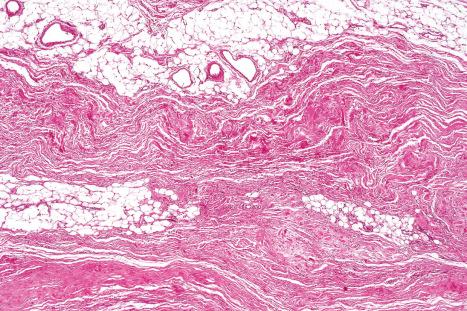
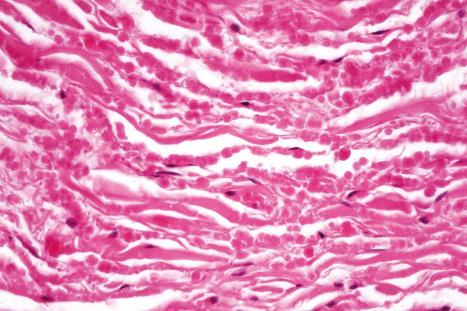
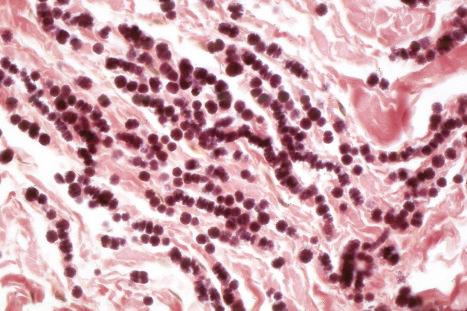
Identification of the distinctive changes in the elastic fibers allows for easy recognition of the condition. Nuchal fibroma is distinguished from elastofibroma by the absence of altered elastic fibers and the presence of fairly thick collagen bundles in the former condition.
Fibroepithelial polyps (acrochordon, skin tag, soft fibroma) are very common lesions that typically present in adults, especially obese females, with a predilection for the neck, axillae and groin. Perianal lesions are also frequently encountered. Rare lesions have been documented in the umbilicus.
These polyps are often multiple and can be associated with pregnancy. Contrary to what was proposed in the past, they do not appear to be a marker for colonic polyps. An association with diabetes mellitus has been suggested. Lesions are usually less than 1 cm in diameter and can be papular, filiform or pedunculated ( Fig. 35.83 ). Rarely, tumors such as squamous cell carcinoma, keratoacanthoma and basal cell carcinoma may develop within a fibroepithelial polyp. Lymphedematous fibroepithelial polyps have been documented in the glans penis and prepuce as a result of chronic condom and catheter use. It has been suggested that fibroepithelial polyps should not be submitted for histologic examination since malignant tumors only very exceptionally show similar clinical features. This is, however, controversial and, in our view, all should be carefully evaluated. Melanoma, for example, may very rarely grossly mimic a fibroepithelial polyp. Fibroepithelial polyps in children are very rare and their occurrence has been reported as a presenting sign of the nevoid basal cell carcinoma syndrome. Lesions identical to fibroepithelial polyps have been described in the tongue of immunosuppressed patients and may also occur in the skin. In these patients, the polypoid lesions show features of basal cell carcinoma. Fibroepithelial polyps can be associated with the rare Birt-Hogg-Dubé syndrome.
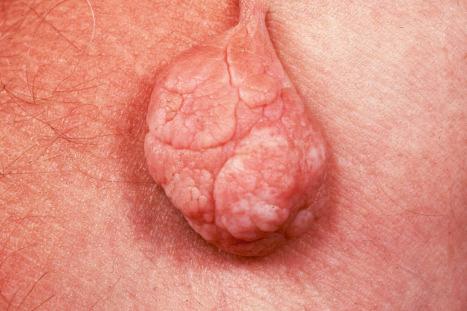
Fibroepithelial polyps show a normal or hyperplastic epidermis surrounding a core of fibrovascular tissue with loose or dense collagen fibers ( Figs 35.84 and 35.85 ). Fat cells can be present and, if abundant, the lesion shows overlap with nevus lipomatosus superficialis. Focal pagetoid dyskeratosis may be an incidental finding in keratinocytes.
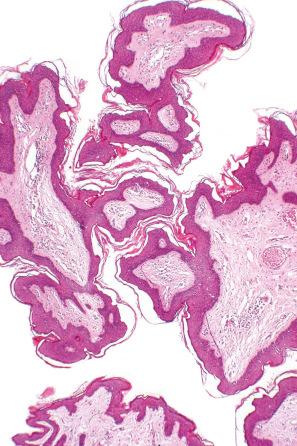
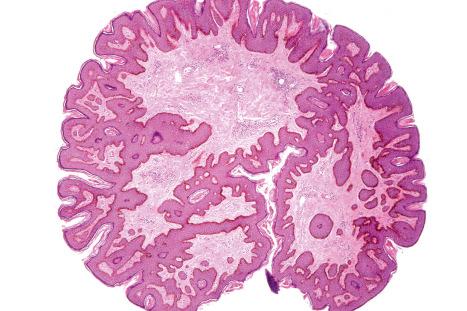
Pleomorphic fibroma refers to a small proportion of cases of acrochordons that show cells with bizarre hyperchromatic and pleomorphic nuclei ( Figs 35.86 and 35.87 ). Multinucleation is also a feature, but mitotic figures are very few and never atypical. These cells are actin positive and the changes are likely to be the result of degeneration, as seen in other tumors such as pleomorphic lipoma and ancient schwannoma. Similar lesions have been described under the name cutaneous pseudosarcomatous polyp. Changes similar to pleomorphic fibroma may also be seen in ‘regressed’ or hyalinized examples of solitary myofibroma or dermatomyofibroma.
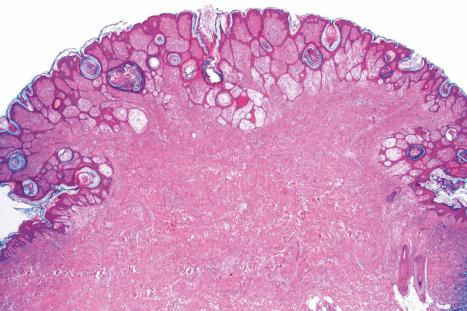
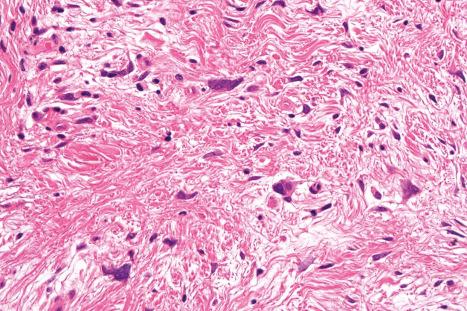
By immunohistochemistry, cells may be positive for CD34.
Pleomorphic fibroma can be distinguished from a dermal atypical lipomatous tumor by the absence of an adipocytic component including lipoblasts in the former. MDM2 immunohistochemistry and MDM2 gene amplification is not seen in pleomorphic fibroma. In a single case report however, MDM2 immunohistochemistry was positive in a pleomorphic fibroma but this was not associated with MDM2 gene amplification. Recently, uniform genetic loss of RB1 (13q) has been documented in pleomorphic fibroma as well as recurrent losses in 10q, 16q, and 17p. Loss of nuclear RB1 can also be demonstrated by immunohistochemistry. This strongly suggests a genetic relationship to spindle cell and pleomorphic lipomas as well as cellular angiofibromas and mammary-type myofibroblastomas—all of which are known to harbor RB1 loss.
Dermatomyofibroma is a rare tumor that presents as a solitary, slowly growing, asymptomatic, skin-colored or hypopigmented plaque. It usually presents on the upper trunk or neck of young adults, with a predilection for females. Most lesions are less than 4 cm in diameter. Tumors may resemble a plaque lesion of dermatofibrosarcoma protuberans or a keloid. An exceptional case presenting in a linear distribution, one with an annular configuration have been documented. Rare cases occur in children and have predilection for the neck. Multiple tumors are very rare. Local recurrence is exceptional.
Histology is distinctive and shows a plaque-like proliferation of fascicles of bland spindled cells with pale eosinophilic cytoplasm and elongated vesicular nuclei with one or two nucleoli ( Figs 35.88–35.90 ). These fascicles tend to be parallel to the epidermis. The papillary dermis is usually spared and there is entrapment, but no destruction of adnexal structures by the tumor. Focal extension into the subcutaneous tissue is sometimes seen and occurs mainly along the septa in a perpendicular fashion. Rare cases display prominent hemorrhage. Myofibroblastic differentiation is suggested immunocytochemically by actin and calponin expression ( Fig. 35.91 ). However, expression of actin and calponin is variable and may be focal or negative. CD34 may be focally positive. H-caldesmon and desmin are negative.
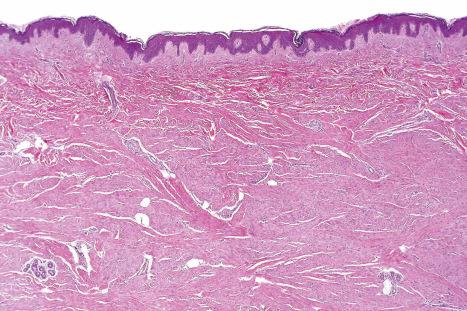
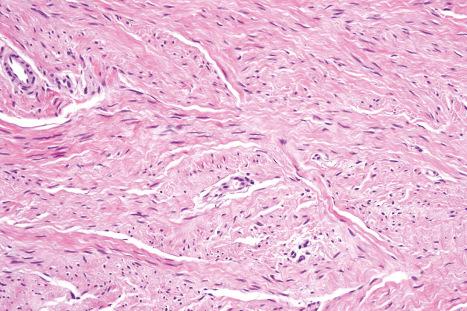
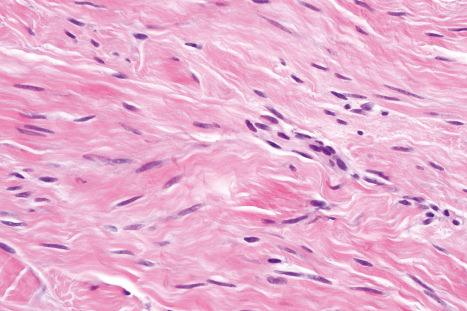
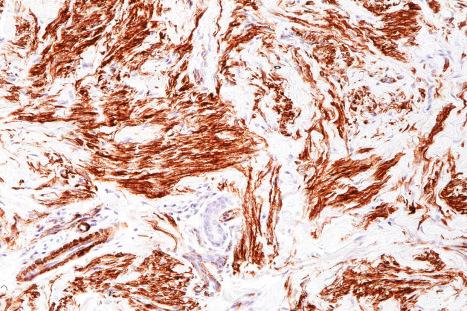
Electron microscopy shows cells with features of fibroblasts and myofibroblasts.
Dermatomyofibroma should be distinguished from plaque-stage dermatofibrosarcoma protuberans, in which the tumor cells are more basophilic and infiltrative. In addition, tumor cells in dermatofibrosarcoma protuberans are actin negative, and are usually diffusely positive for CD34. Dermatomyofibroma may also be confused with diffuse neurofibroma. The latter, however, is paler, lacks parallel orientation of tumor cells to the epidermis, and is S100 protein and CD34 positive. Rare hemorrhagic cases may be confused with nodular stage Kaposi sarcoma. However, in the latter condition, tumor cells are arranged in nodules, and are accompanied by numerous cleft-like spaces containing red blood cells. Inflammatory cells including plasma cells are always present, eosinophilic globules are prominent and all cases show nuclear reactivity with immunohistochemistry for human herpesvirus.
Storiform collagenoma (also known as circumscribed storiform collagenoma and sclerotic fibroma) is a solitary skin-colored nodule, usually less than 1 cm in diameter. It presents in adults of either sex and has a wide anatomical distribution. Simple excision is curative. Multiple lesions with identical histologic features are seen in Cowden disease (multiple hamartoma and neoplasia syndrome) and it has been suggested that they represent a marker for this condition. In this setting, and also sporadically, such lesions have also been described in the oral cavity. An exceptional case has been documented in the nail and a case associated with Rubinstein-Taybi syndrome in a young adolescent has been reported.
Microscopically, storiform collagenoma is a well-circumscribed dermal nodule composed of hypocellular hyalinized collagen bundles separated by clefts and arranged in a storiform pattern ( Figs 35.92–94 ). Rare spindle-shaped cells are occasionally seen. Occasional lesions display more cellularity and scattered pleomorphic cells as seen in pleomorphic fibroma; hence, a link has been suggested between both entities. Tumor cells are positive for CD34 and CD99. Giant cell collagenoma appears to be a variant of storiform collagenoma with scattered multinucleate giant cells, some of which have a bizarre appearance.
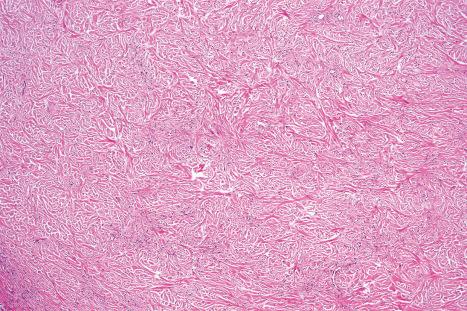
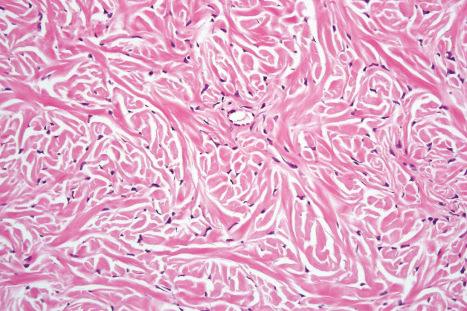
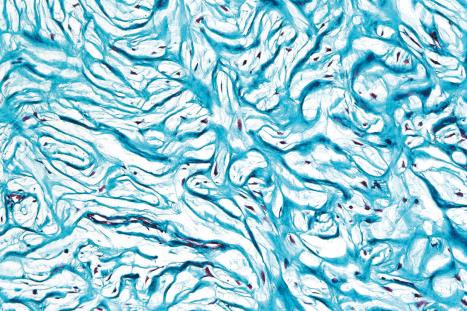
On electron microscopy the lesional cells are seen to be separated from blood vessels by laminated concentric collagen resulting in a plywood-like pattern.
Areas simulating storiform collagenoma are sometimes seen in a variety of tumors, including fibroma of tendon sheath (which is never dermal), sclerotic fibrous histiocytomas, neurofibroma, fibroadenoma of axillary accessory breast tissue and even solitary myofibromas. However, the distinctive histologic features of these latter conditions are usually apparent in neighboring fields. Dermal lipomas with prominent sclerosis may simulate a storiform collagenoma but mature adipocytes are always demonstrated in the former lesion. Sometimes it may focally simulate sclerosing perineurioma but EMA is invariably negative. Focal changes simulating sclerotic fibroma may also be seen in inflammatory conditions such as erythema elevatum diutinum and folliculitis.
Nuchal fibroma (also known as collagenosis nuchae) is a distinctive dermal and subcutaneous tumor that tends to present mainly in the posterior neck of men between the third and fifth decades of life. Despite the name, up to one-third of lesions can occur in other locations including the shoulder, back, and even the face and limbs (including a lesion on an ankle). It has been proposed that lesions occurring in extranuchal sites should be described as nuchal-type fibroma. An association with diabetes has been documented. Identical tumors – when multiple and presenting in children – are usually seen in Gardner syndrome (see below). Only exceptionally are multiple lesions not associated with the later. Tumors are asymptomatic and measure less than 3 cm in diameter. Local recurrence occurs in a small number of cases but this is not destructive. A case associated with dermatofibrosarcoma protuberans has been documented. A tumor developing concomitantly with an inflammatory myofibroblastic tumor of the pleura was documented.
Tumors are poorly circumscribed and composed of thick collagen bundles with a lobular architecture and few scattered fibroblasts ( Figs 35.95 and 35.96 ). Entrapped fat and traumatic neuroma-like changes are often seen. Occasionally, there is focal infiltration of skeletal muscle. Mononuclear inflammatory cells are rare.
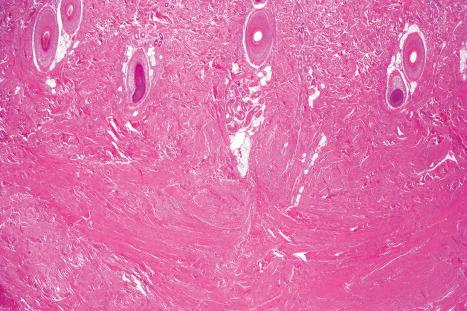
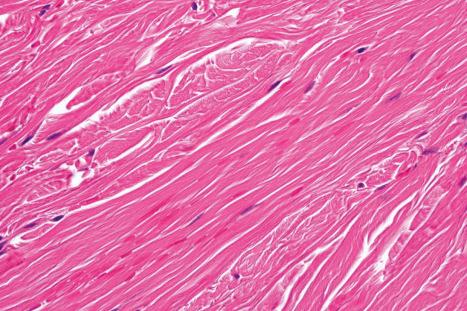
By immunohistochemistry, tumor cells are positive for CD34 and CD99 but negative for β-catenin, desmin and actin.
Distinction from Gardner fibroma may be very difficult. Nuclear accumulation of β-catenin is seen in Gardner fibroma but any lesion with morphological features of nuchal-type fibroma should be considered Gardner-associated until clinical work-up proves otherwise. Desmoid fibromatosis may show focal areas resembling a nuchal fibroma but, in most areas, tumors are more cellular and show prominent infiltration of surrounding tissues.
Gardner fibroma is a benign soft tissue tumor identical to nuchal fibroma, presenting in patients with Gardner syndrome (colonic adenomatous polyposis, epidermoid cysts), a familial adenosis poliposis (FAP) variant also associated with germline inactivating mutations in APC . The tumor may be the first manifestation of the disease and lesions tend to be multiple, arising in children and at different sites including the neck, head, trunk and extremities. Desmoid fibromatosis may develop at the sites of Gardner fibromas and the relationship of these two lesions is unclear. Lesions are poorly circumscribed, slow growing and range in size from 2 to 10 cm. Local recurrence is possible.
These tumors are driven by overaction of the Wnt/β-catenin pathway secondary to inactivation of the APC gene. Tumors are identical to nuchal fibroma (see above) but some lesions are more cellular and lack a lobular growth pattern. A case associated with elastosis, traumatic neuroma and a MUTYH polymorphism has been described. Immunohistochemistry to examine for nuclear accumulation of β-catenin can be helpful, but is not entirely specific.
Nuchal fibrocartilaginous pseudotumor is a rare distinctive proliferation described in adults and rarely in children. Patients usually (but not always) have a previous history of neck injury and present with an asymptomatic mass on the posterior aspect of the neck at the junction of the nuchal ligament and the deep cervical fascia. Tumors are only a few centimeters in diameter.
Histology shows a poorly circumscribed tumor consisting of moderately cellular fibrocartilaginous tissue within the nuchal ligament. Mitotic figures are rare and cytologic atypia is absent.
Tumor cells are positive for vimentin and CD34 and scattered chondroid cells stain for S100 protein. Actin, desmin and keratin are negative.
Ultrastructural studies show cells with features of fibroblasts and chondroblasts. No myofibroblasts are identified.
Fibromatosis colli is a rare condition seen only in infants and children. Most of the cases present within the first few weeks of life, with no sex predilection. Typically, a mass involving the distal sternocleidomastoid muscle and measuring less than 3 cm in diameter is seen. The mass results in rotation of the head and torticollis. Lytic clavicular lesions have been reported. A rare case associated with overlying hypertrichosis has been described. Surgical treatment is required only in a small number of patients. The treatment of choice is physiotherapy. The majority of cases show spontaneous resolution.
Fibromatosis colli appears to be related to trauma, as often there is a history of intrauterine positional abnormalities or complicated deliveries. Other musculoskeletal abnormalities can also be seen. An association with Wiedemann-Steiner syndrome has been reported.
Histology shows partial replacement of skeletal muscle by collagenous tissue with poor cellularity. Degenerate muscle fibers are commonly seen.
By immunohistochemistry, tumor cells are positive SMA but negative for beta-catenin.
Distinction from other types of fibromatosis is based on the typical clinical presentation and the presence of a predominantly collagenous hypocellular mass in fibromatosis colli. In addition, aberrant nuclear positivity for β-catenin is seen in most cases of fibromatosis, excepting superficial fibromatoses.
Calcifying fibrous tumor (calcifying fibrous pseudotumor, childhood fibrous tumor with psammoma bodies) is rare and presents mainly in children and young adults with slight female predilection. Most tumors occur in the gastrointestinal tract particularly the stomach, pleura, subcutaneous and deeper soft tissues, pleura, mesentery and retroperitoneum. Exceptional oral, heart, lung and gallbladder examples have been documented. Multiple lesions are very rare and appear to be mainly pleural. Familial cases are uncommon. Soft tissue lesions favor the extremities and trunk. Associations with Castleman disease, inflammatory myofibroblastic tumor and IgG4-related disease have been reported. Size varies from 1 to 15 cm. Local recurrences may occur in up to 10% of cases.
The pathogenesis is unknown. Although a close relationship with inflammatory myofibroblastic tumor was proposed in the past, it is still considered a distinctive entity.
Histology shows a well-circumscribed mass consisting of sclerotic hypocellular collagen with scattered mononuclear inflammatory cells consisting of lymphocytes and plasma cells ( Figs 35.97 and 35.98 ). The latter may form focal aggregates. A striking feature is the presence of focal calcification with formation of psammoma bodies.
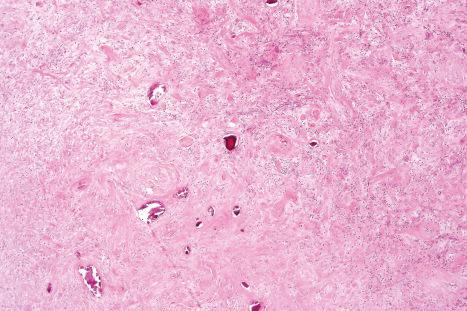
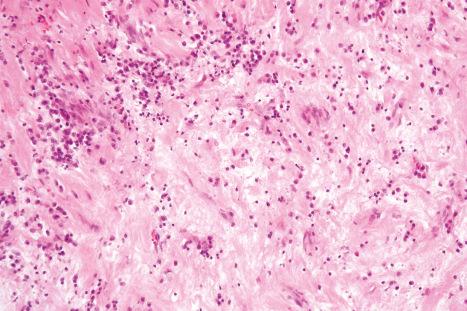
Tumor cells are diffusely positive for CD34 and rare cells may be positive for actin and desmin. ALK is negative.
The presence of a tumor combining sclerotic collagen, inflammation and calcification is distinctive and allows differential diagnosis from other tumors such as desmoplastic fibroblastoma.
Fibroma of tendon sheath is a relatively common tumor and is usually seen in the third to fifth decades. It predominates in males (3 : 1) and is virtually confined to the extremities, especially the fingers (mainly the thumb and index), hands, wrists and more rarely the knees. The lesion presents as a solitary, usually painless, subcutaneous nodule attached to a tendon or tendon sheath, particularly on the flexor aspect. It rarely exceeds 2 cm in diameter and is of variable duration. Exceptionally, bone erosion has been documented. It may occur in an intra-articular location. An association with carpal tunnel syndrome, trigger wrist and Guyon canal syndrome is occasionally seen. Local recurrence may be seen in up to 24% of cases, almost always as a result of marginal or incomplete excision.
Cytogenetic studies in a case have found a t(2;11)(q31-32;q12). The same cytogenetic abnormality has been found in collagenous fibroma (desmoplastic fibroblastoma) suggesting a genetic link between both entities. However, a recent study, based on immunohistochemical positivity for FOSL1 in the latter but not in fibroma of tendon sheath, suggests that they represent distinct entities. Furthermore, USP6 genetic rearrangements have been found in a subset of cellular, but not classic, fibromas of tendon sheath suggesting that they might represent underrecognized examples of tenosynovial nodular fasciitis. A single case with a t(9;11)(p24;q13-14) translocation has also been reported.
Fibroma of tendon sheath is a well-circumscribed encapsulated tumor with a lobulated appearance. It shows marked variation in cellularity and is composed of an admixture of dense, relatively acellular, fibrous tissue containing scattered uniform spindled cells and foci of myxoid change. Collagenous hyalinization and areas of increased cellularity, sometimes resembling nodular fasciitis, are commonly present ( Figs 35.99 and 35.100 ). In uniformly cellular lesions the spindled cells are more often arranged in fascicles. These are composed of closely packed fibroblasts showing infrequent normal mitotic figures. A cardinal feature of this lesion, irrespective of the degree of collagenization, is the presence of numerous, usually slit-like, vascular spaces lined by normal endothelium ( Fig. 35.101 ). A scattered chronic inflammatory infiltrate is not uncommon and some cases show rare, osteoclast-like giant cells and foamy macrophages focally mimicking a giant cell tumor of tendon sheath.
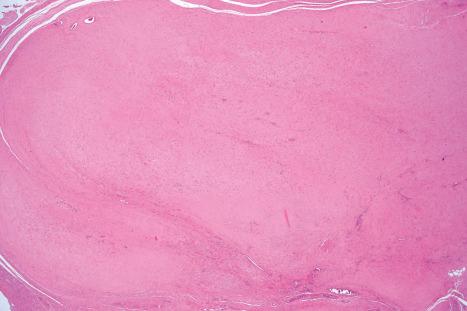
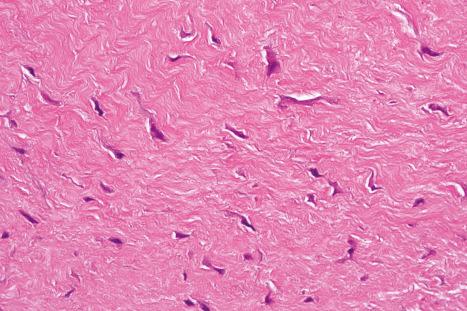
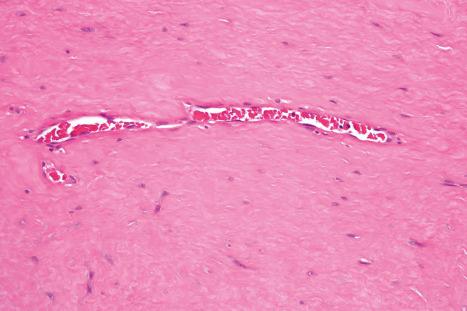
The encapsulation and presence of a distinctive vascular pattern separate fibroma of tendon sheath from nodular fasciitis and fibromatosis. Dermal lesions composed of hypocellular eosinophilic concentric collagen, and considered in the past to be examples of fibroma of tendon sheath, probably represent examples of storiform collagenoma.
Desmoplastic fibroblastoma (collagenous fibroma) is a distinctive, benign soft tissue tumor that mainly presents in a subcutaneous, fascial or intramuscular location. Presentation in the dermis is very rare and in one of the reported cases, the patient had a long-standing history of pemphigus. Lesions are asymptomatic and present as a slowly growing mass, most commonly located on the arm, shoulder, thigh, forearm, back and hands and feet. Size varies from 1 to 20 cm but the majority of tumors measure less than 4 cm.
Unusual tumors presenting on the neck mimicking a goiter, on the face mimicking a parotid tumor, in the oral cavity (including the tongue), in a lacrimal gland and within a joint have been documented. Most patients are middle-aged to elderly males but cases in younger patients and in children may rarely occur. A case with bone involvement has been described. The clinical behavior is entirely benign with no local recurrences reported in the literature to date.
Cytogenetic studies in multiple cases have shown clonal abnormalities involving 11q12 which seems to be associated with deregulated expression of FOSL1. This locus is identical to that found in a single case of fibroma of tendon sheath. However, based on other studies, it is not likely that the entities are related (see fibroma of tendon sheath ). One case with trisomy 8 has been reported.
Tumors are fairly well circumscribed, round or oval and sometimes appear lobulated ( Figs 35.102 and 35.103 ). Low-power examination reveals a lesion with very focal infiltration of surrounding tissues, poor cellularity and a prominent collagenous stroma. Tumor cells are elongated or stellate, with vesicular nuclei, a small nucleolus and pale cytoplasm. Mitotic figures are not seen. In some cases, there is focal myxoid change. Vascularity is not prominent and consists of small blood vessels with thin walls.
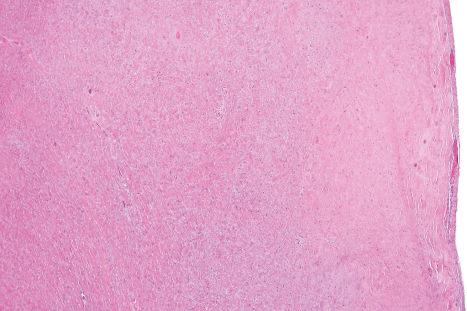
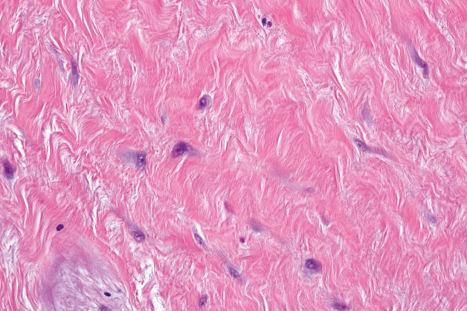
Immunohistochemistry shows diffuse positivity for vimentin, focal positivity for α-SMA and occasional positivity for keratin. In addition tumor cells are uniformly positive for FOSL1. There is negative staining for other markers including S100 protein, CD34 and desmin.
Ultrastructural studies suggest that the cells in the lesion are fibroblasts or myofibroblasts.
The main differential diagnosis is fibromatosis. The latter tumor has an infiltrative growth pattern, is cellular, tumor cells have an elongated appearance and there is a prominent vascular network. An old lesion of nodular fasciitis is usually more hyalinized, with focal inflammation and degenerative changes. Fibroma of tendon sheath almost always occurs in acral sites and has a prominent lobular architecture with a conspicuous vascularity. Also, tumor cells are negative for FOSL1.
Inclusion body fibromatosis is a rare benign neoplasm initially described as infantile digital fibromatosis. The latter term derives from the fact that almost all cases arise on the fingers or toes of infants less than 3 years of age, and one-third of the cases are congenital. However, rare cases have been reported in older children and in adults and at other sites, and a more accurate designation is that of inclusion body fibromatosis. Typically, it presents as a small (usually less than 1 cm diameter), rapidly growing, dermal or subcutaneous nodule on the dorsal or lateral aspect of one of the digits; multiple lesions arising synchronously or separately on more than one digit (fingers and toes) are not uncommon. Lesions may also be seen elsewhere on the hands and feet. Inclusion digital fibromatosis shows a marked tendency towards local recurrence after excision (up to 50%), but has no capacity to metastasize. Spontaneous regression is usually seen in most cases and therefore treatment should only be symptomatic.
The lesion is composed predominantly of an irregular mass of proliferating myofibroblasts, showing occasional normal mitoses, but no atypia, embedded in a dense collagenous stroma, which extends deeply from the dermis and may be attached to underlying osteoarticular structures ( Fig. 35.104 ). The diagnostic sine qua non and characteristic feature is the presence of brightly eosinophilic intracytoplasmic inclusions in a variable number of the myofibroblasts ( Figs 35.105 and 35.106 ) which can be seen as red inclusions with a Masson trichrome stain. A focal lymphocytic inflammatory cell infiltrate can be seen and it has been reported to be more common in areas with numerous inclusion bodies. Tumor cells are usually positive for alpha smooth-muscle actin, calponin, and desmin. Occasionally, they may be positive for h-caldesmon and beta-catenin (nuclear staining). These inclusions are actin positive, especially in alcohol-fixed tissue, and the presence of these filaments has been demonstrated by immunoelectron microscopy. The inclusions can also be highlighted with anti-calponin 1. Positivity for actin may also be demonstrated if sections are pretreated with KOH. The inclusions are composed of intermediate filaments measuring 5–7 nm. It is not clear why these inclusions are formed. It is very likely that they are the result of a defect in actin metabolism. Other myofibroblastic lesions (including myofibrosarcoma), the stromal cells of phyllodes tumor, fibroadenoma, and some leiomyomas can rarely show similar actin-positive intracytoplasmic inclusions.
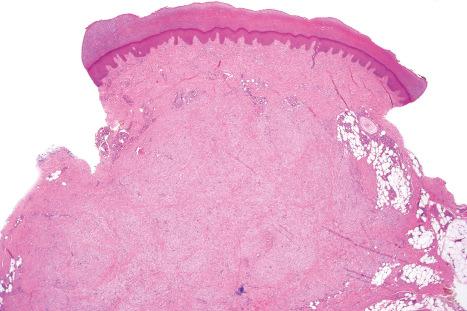
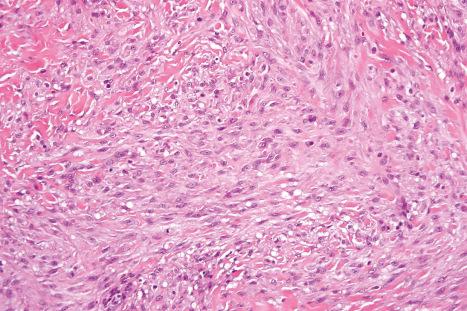
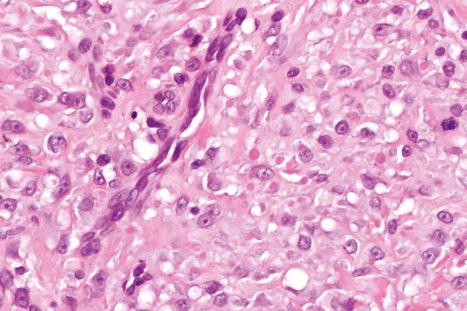
The presence of eosinophilic inclusions and the clinical history allow no differential diagnosis. Identical lesions may occur in the digits of patients with a syndrome consisting of terminal osseous dysplasia and pigmentary defects. However, in these patients, inclusions are not seen.
Calcifying aponeurotic fibroma (also known as juvenile aponeurotic fibroma) is a very rare lesion seen predominantly in the first two decades of life, with a predilection for males. It presents as a single small nodular or infiltrative mass, most often on the feet or hands, especially the palms. Involvement of other sites such as the head and neck, back, abdominal wall, legs and arms is very rare. Multiple lesions are exceptional. Bone involvement is extremely rare. Local recurrence, particularly in younger patients, is common and occurs in up to 50% of cases.
An FN1 - EGF gene fusion, not detected so far in any other neoplasm, has been reported as the main driver mutation in this tumor.
Calcifying aponeurotic fibroma characteristically forms an irregular mass of dense, fairly cellular, fibrous tissue invading subcutaneous and muscular structures widely ( Fig. 35.107 ). Myofibroblasts tend to be plump with prominent nuclei. Usually, these cells have a linear or palisaded arrangement and comprise the bulk of the tumor. As the lesion matures, the calcified areas undergo chondroid metaplasia ( Fig. 35.108 ). Extramedullary hematopoiesis may occasionally be seen.
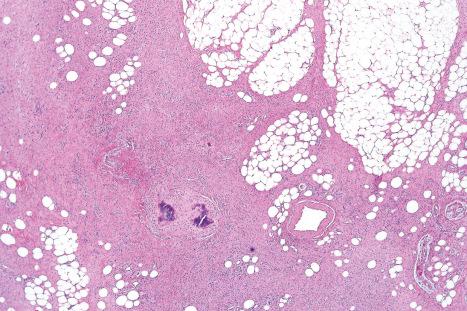
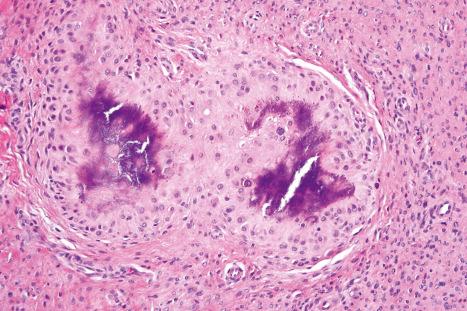
The differential diagnosis includes palmar fibromatosis, which is rare in young people and tends to be fairly circumscribed, and soft tissue chondroma, which lacks the dense myofibroblastic component and is composed solely of cartilaginous tissue, which is often rather cellular.
Knuckle pads, which are regarded as a superficial variant of palmar fibromatosis, are not uncommon, rather banal lesions that rarely come to the attention of either clinicians or pathologists. They present as fairly ill-defined foci of fibrous thickening over the metacarpophalangeal or proximal interphalangeal joints, most often in the middle aged ( Fig. 35.109 ). They may be familial, associated with Dupuytren contracture or plantar fibromatosis, secondary to repeated trauma or idiopathic. They are almost always asymptomatic. Knuckle pad-like lesions occur in epidermolytic palmoplantar keratoderma associated with mutations on keratin 9. A case of knuckle pads with leukonychia and deafness has been documented. An exceptional association with pseudoxanthoma elasticum is probably coincidental.
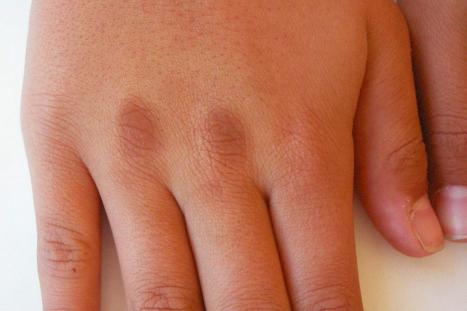
The etiology of knuckle pads is unknown but it has been suggested that they may be induced by knuckle cracking. A case induced by trauma from playing video games has been reported.
A knuckle pad is manifest as an area of non-specific fibrous proliferation in the dermis, often associated with overlying hyperkeratosis ( Fig. 35.110 ).
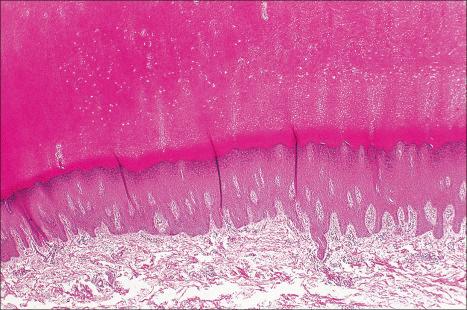
Acquired digital fibrokeratoma is of no clinical significance and arises most often in adult life, affecting males more often than females. It presents as a slowly growing firm nodule or excrescence, usually less than 1 cm in size, on the fingers or toes; as such, it may clinically resemble a supernumerary digit ( Fig. 35.111 ). Periungual lesions are known as acquired periungual fibrokeratomas. A case with multiple lesions has been reported. A similar lesion has been documented on the heel. Some regard these lesions as traumatic, although with little supporting evidence. A case associated with ciclosporine treatment has been documented. Acquired digital fibrokeratoma may be similar to the periungual fibroma that occurs in tuberous sclerosis but the latter tends to be multiple and has minimal or no epidermal component.
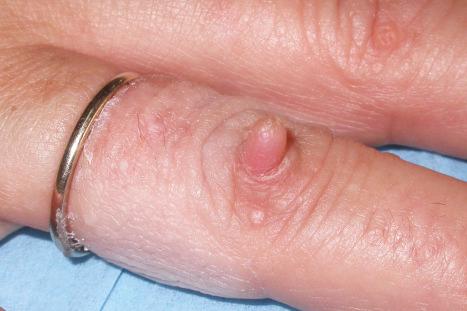
Microscopically, fibrokeratomas are pedunculated lesions covered by variably acanthotic and hyperkeratotic skin ( Figs 35.112 and 35.113 ). The core is composed of an admixture of dense collagen fibers containing a variable number of mature fibroblasts, small blood vessels and elastic tissue, all merging with the adjacent normal dermis. Within fibrokeratomas, small peripheral nerves or tactile corpuscles are inconspicuous in contrast to their prominence in accessory digits.
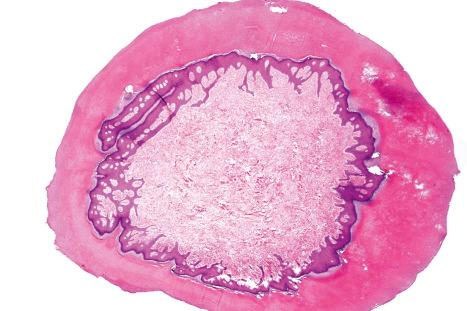
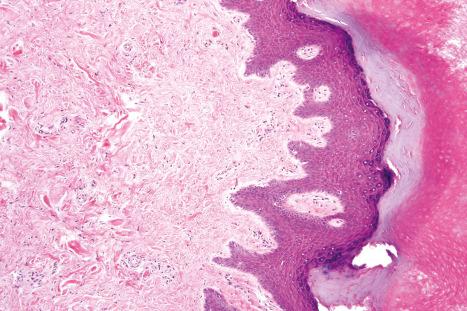
The clinical history allows their distinction from an accessory digit, periungual fibroma or knuckle pad. Local excision is curative.
This distinctive lesion was originally described as medallion-like dermal dendrocyte hamartoma to highlight the typical clinical appearance and also to suggest a possible line of differentiation towards dermal dendrocytes. Since then, isolated case reports have been described and a small series was recently published challenging the theory regarding the line of differentiation and proposing the term plaque-like CD34-positive dermal fibroma. Lesions usually present in young children, may be congenital, are rarely seen in adults and have predilection for the proximal limbs, neck, and upper trunk. Females are more often affected than males. Tumors usually measure several centimeters, are red or brown in color, and have a medallion-like appearance.
Tumors are characterized by a band-like proliferation of fibroblast-like bland cells usually occupying the upper part of the dermis. Extension into the subcutaneous tissue is rare. Scattered small dilated vascular channels are present and tumor cells are interspersed with collagen bundles with decrease in elastic fibers. Superficial tumor cells have a vertical orientation to the epidermis and deeper cells usually have a horizontal orientation with regards to the epidermis. CD34 is positive in tumor cells and there is minimal focal staining for smooth-muscle actin and few factor XIIIa-positive cells.
The main differential diagnosis is with early plaque-stage dermatofibrosarcoma protuberans. This is discussed under the latter condition.
Fibrous hamartoma of infancy is a rare benign tumor of childhood, which although occasionally manifest at birth, usually presents in the first 2 years of life as a solitary, dermal and subcutaneous mass. Congenital lesions represent around 20% of cases. Tumors in older children are rare. Males are predominantly affected. It occurs most often in the axilla, shoulder region, proximal upper limb, groin, back or forearm. Tumors rarely occur on the hands, feet, scrotum and scalp. It typically presents as an asymptomatic, firm but mobile lesion up to 10 cm in diameter. Multicentric tumors are rare. There is no family history. A likely coincidental association has been reported in a case of Williams syndrome and in a case of tuberous sclerosis. Overlying hypertrichosis has been reported in one case. Rarely, there may be local recurrence after inadequate excision. Sarcomatous features have been reported in two cases, one lost to follow-up and a further case with no aggressive behavior after 4 years of follow-up.
Cytogenetics in a single case revealed t(2;3)(q31;q21). Two further cases have shown complex chromosomal translocations. In a recent study, two tumors with sarcomatous features showed a hyperdiploid/near tetraploid karyotype suggesting that the lesion is likely to be neoplastic rather than hamartomatous.
Fibrous hamartoma of infancy is an ill-defined lesion that merges with adjacent normal tissue and involves predominantly the deep dermis and subcutaneous fat. It is characterized by varying proportions of four components:
disorderly fibrous tissue (coarse bundles of collagenous fibrous tissue with blood vessels and inflammatory cells),
orderly fascicles of eosinophilic myofibroblasts with wavy nuclei, which are actin positive ( Figs 35.114 and 35.115 ),
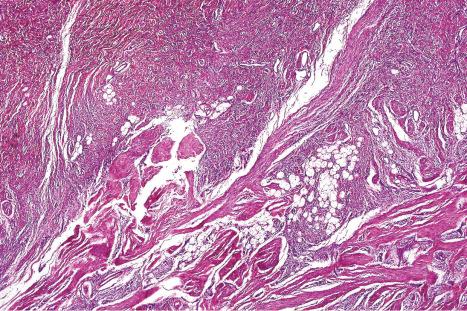
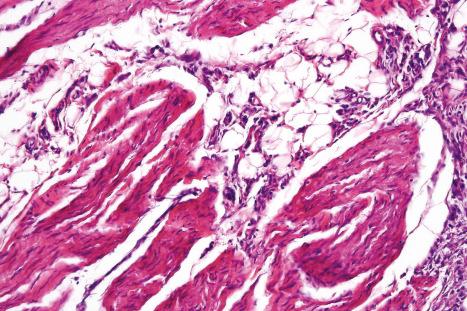
mature adipose tissue,
primitive myxoid foci containing plump, undifferentiated mesenchymal cells arranged in whorls ( Fig. 35.116 ).
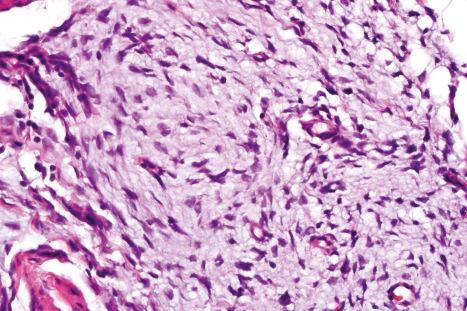
The combination of these components produces an organoid pattern. A focal pseudoangiomatous may be observed in up to 50% of cases. Areas of hyalinization with cleft lined tumor cells and mimicking giant cell fibroblastoma are commonly seen. Occasional normal mitotic figures may be seen. Numerous thin-walled capillaries are also present. This distinctive appearance makes this tumor readily distinguishable from any other. Tumors with sarcomatous change display hypercellularity, cytologic atypia and increased mitotic activity.
The myofibroblasts in the lesion stain positively for SMA and calponin. S100 and desmin are usually negative. The more primitive cells stain variably for CD34. The latter is also positive in the pseudoangiomatous and giant cell fibroblastoma-like areas.
Changes in the overlying eccrine glands have been described including hyperplasia with papillary projections, dilatation and squamous syringometaplasia.
Ultrastructurally, cells within the more mature areas show features of fibroblasts and myofibroblasts. The cells in more undifferentiated myxoid areas show no specific features except for slender cytoplasmic processes.
The clinical presentation and histologic features usually allow a diagnosis to be made. In small biopsies, the spindle-shaped component in a myxoid stroma may be confused with a neurofibroma but this is only a focal change and cells are negative for S100 protein. Distinction from a myofibroma is based on the presence of a distinctive biphasic pattern in the latter tumor.
Fibroblastic connective tissue nevus is a rare newly described variant of connective tissue nevus which is described herein because of its resemblance to fibrous hamartoma of infancy. It has been suggested that it might represent a monophasic variant of fibrous hamartoma of infancy and it is considered a developmental abnormality. It occurs more commonly in children, with predilection for females. Presentation in adults is uncommon. The lesion most commonly arises in the trunk, head and neck, and limbs as a single papule or nodule. A case presenting with agminated lesions has been described. No recurrences have been reported, even after incomplete excision.
Fibroblastic connective tissue nevus is a poorly circumscribed lesion arising in the deep reticular dermis sometimes involving the superficial subcutaneous fat ( Fig. 35.117 ). The overlying epidermis is frequently papillomatous. The lesion is composed of fibroblastic or myofibroblastic cells, with pale eosinophilic cytoplasm, and an adipocytic component is often seen in the dermis ( Figs 35.118 and 35.119 ). Entrapped adnexal structures are commonly observed. Elastic fibers are usually decreased or fragmented. CD34 is positive and SMA may be focally and weekly positive.
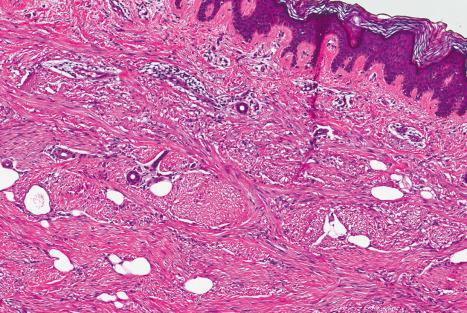
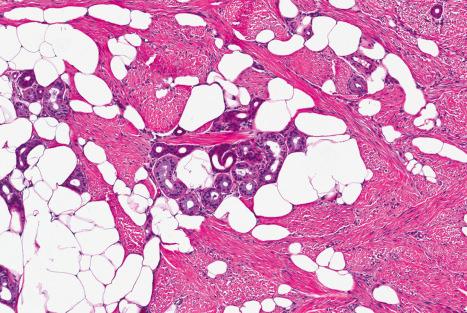
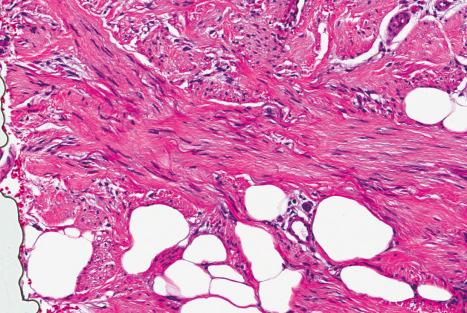
Distinction from the other CD34 positive fibroblastic lesions is usually straightforward.
Angiofibroma of soft tissues is a recently described subcutaneous or deep-seated tumor of likely fibroblastic nature which most often occurs adjacent to joints or fibrotendinous structures of extremities, usually the lower limbs. Unusual locations include trunk and pelvis. The age range is wide and there is female predilection. Lesions present as a fairly circumscribed painless mass of long duration. In some cases, however, an infiltrative growth may be seen, raising concerns for malignancy on imaging. From the limited data available, the tumor has an indolent course. Local recurrence is rare.
Angiofibroma of soft tissues is characterized by a recurrent t(5;8)(p15;q12) translocation resulting in AHRR and NCOA2 gene fusions. A GTF21 - NCOA2 fusion is rarely found. In a single case in a child, a GAB1 - ABL1 fusion has been described.
Histologically, the tumor is well circumscribed but unencapsulated. A focally infiltrative growth pattern may be seen. Lesions are characterized by a vascular and a fibroblastic bland spindle cell component of variable cellularity and low mitotic activity, embedded in a collagenous to myxoid stroma ( Figs 35.120 and 35.121 ). The vascular component is variable: small sized branching vessels are prominent whereas larger vessels with ectatic lumina may be seen, usually at the periphery of the tumor. Sometimes the latter may be slitlike or with a staghorn appearance. Secondary degenerative changes such as vascular hyalinization, fibrinoid or ischemic necrosis, edema, and hemosiderin deposition are not uncommon. Mitotic activity is low. Typically, a perivascular inflammatory infiltrate is noted. Tumor cells express CD163, ER, and nuclear NCOA2. Other positive markers include EMA, CD68, PR, and CD34. Smooth muscle actin and desmin may also be focally positive. Cells are negative for S100, CK, MDM2, CDK4, and STAT6.
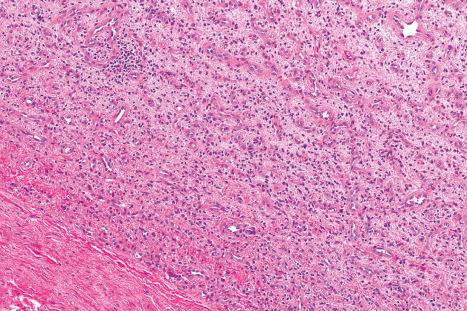
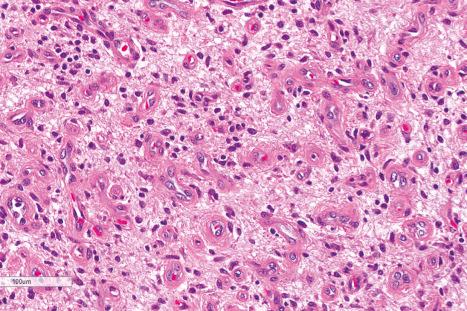
This is a rare tumor identical to myofibroblastoma that occurs in the breast. As with the latter tumor, it is most common in adult males and presents as an asymptomatic slowly growing subcutaneous mass with predilection for the groin/inguinal area. Cases in children are exceptional. Size varies but tends to be less than 2 cm. Lesions can also rarely occur on the trunk, breast, axilla, vaginal wall, paratesticular area, vulva, perianal area, and lower limb. About 10% of cases occur in an intra-abdominal/retroperitoneal location. There seems to be a predilection for tumors to occur along the milk line. Simple excision is the treatment of choice and there is no tendency for local recurrence.
Cytogenetic analysis has shown deletion or rearrangement of 13q14 that translates into loss of RB1 expression. Mammary-type myofibroblastoma appears to be part of a morphological spectrum that includes cellular angiofibroma and spindle cell lipoma (as well as pleomorphic lipoma and pleomorphic fibroma). These former tumors not only share morphological features but also the same cytogenetic abnormality. There does not seem to be a relationship between solitary fibrous tumor and mammary-type myofibroblastoma.
Tumors are well-circumscribed and composed of a mixture of bland spindled cells and variable, sometimes prominent, amounts of mature adipose tissue. The spindled cells are arranged in fascicles and display a myofibroblast-like appearance with tapering nuclei and amphophilic cytoplasm with an indistinct cytoplasmic membrane. Nuclear palisading as seen in schwannoma is sometimes seen. Cytologic atypia is rare and mitotic figures are exceptional. Epithelioid cells may rarely be seen and sometimes scattered multinucleate cells can be identified. Blood vessels are small and tend to be inconspicuous. The stroma is often myxoid, mast cells are common, and hyalinized collagen bundles are intermixed with tumor cells.
Immunohistochemistry shows positivity for CD34 and desmin and loss of RB1 expression. Rare cases negative for CD34 and desmin may be seen. Focal positivity for actin and calponin in a number of cases.
Juvenile hyaline fibromatosis is an exceedingly rare autosomal recessive disfiguring condition of younger children and usually presents as cutaneous papules and nodules, multiple soft tissue masses of variable size that particularly affect the head and neck, and gingival hyperplasia ( Fig. 35.122 ). The back and flexures of the lower limbs may also be involved, resulting in flexion contractures. Often, joint contractures and gingival hypertrophy precede the cutaneous manifestations of the disease. Other associations include mental retardation and osteolytic bone lesions, hyperpigmentation, osteosclerosis, scoliosis, atrial thrombus, and pericardial effusion. A more localized and limited form of the disease has been documented. In a single case, a squamous cell carcinoma developed in association with oral lesions.
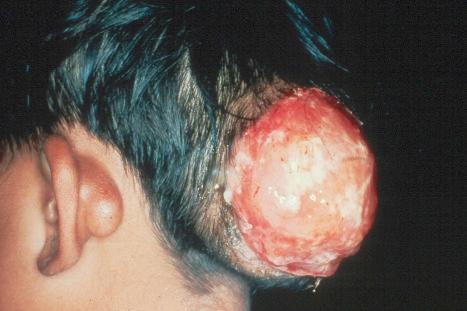
The only treatment is surgical excision of each lesion, but new tumors may continue to develop into adult life. Targeted therapy with proteasome inhibitors has been suggested as a therapeutic option.
Infantile systemic hyalinosis is considered to be an allelic disorder with similar but more severe involvement, hyaline deposits in many organs, recurrent infections and death early in life, usually within the first 2 years.
Juvenile hyaline fibromatosis, thought to be due to a genetic abnormality of collagen production, may be seen in siblings, particularly of consanguineous parents. Ultrastructural studies and skin fibroblasts from cultures have suggested defective synthesis of collagen within fibroblasts. The disease results from an abnormal assembly of basement membrane material and collagen deposition is also abnormal. The gene for the disease has been mapped to chromosome 4q21. Multiple different mutations have been identified in this gene, which encodes capillary morphogenesis protein 2 ( CMG2 ), also termed anthrax toxin receptor 2 ( ANTXR2 ). ANTXR2 is a transmembrane protein induced during capillary morphogenesis. The protein binds laminin and collagen type IV and alterations in the protein result in abnormalities in the assembly of basement membrane material with the typical manifestations of the disease. Interestingly, ANTXR2 also serves as a receptor for anthrax toxin. Infantile systemic hyalinosis has similar disease manifestations and ANTXR2 mutations and it likely represents a disease spectrum with juvenile hyaline fibromatosis. The name of hyaline fibromatosis syndrome has been proposed to include both entitites.
The tumors are largely composed of irregular poorly circumscribed masses of deeply eosinophilic, hyalinized, collagen-like material within which are embedded a variable (though usually small) number of fairly plump spindled cells ( Figs 35.123–35.125 ). Hyalinization is rarely not prominent. Scattered macrophages and multinucleated giant cells may also be seen. Basophilic calcospherules have been documented.
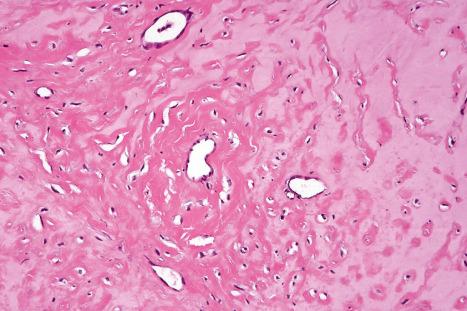
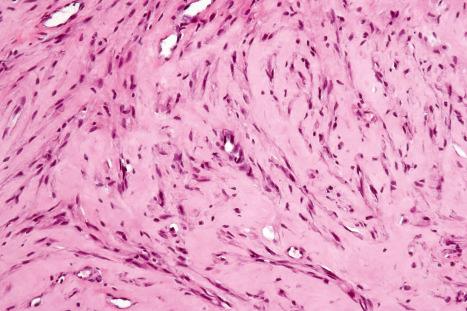
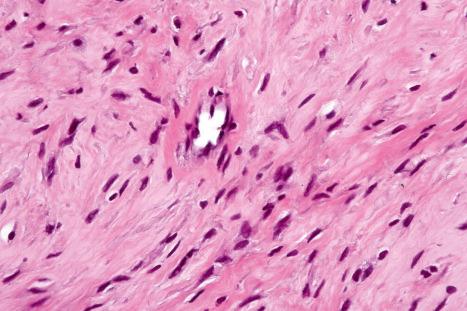
Electron microscopy shows mesenchymal cells with dilated rough endoplasmic reticulum, prominent Golgi complexes and vesicles with abundant fibrillogranular material.
The presence of multiple lesions arising in childhood and the characteristic histologic features narrow down the differential diagnosis. Infantile myofibromatosis presents with multiple lesions but the histologic features are quite different from those of juvenile hyaline fibromatosis. Nuchal fibroma presents as a single lesion and is characterized by abundant collagen lacking masses of amorphous eosinophilic material.
Locally aggressive fibrous lesions are defined as infiltrative neoplasms that are prone to local recurrence. They may be destructive, but never metastasize.
Palmar fibromatosis (Dupuytren contracture) is a common condition that is largely confined to adults; its incidence increases with age. Presentation in children is rare and occasional congenital cases may occur. Males are affected more often than females and up to 4% of the adult male population, particularly the elderly, are thought to develop this lesion. People of northern European descent are predominantly affected and women usually develop the disease much later in life than men. The disease is much less common in Oriental Jews. In contrast to keloid, Dupuytren contracture is comparatively uncommon in the dark-skinned races, but the incidence is increased in patients with plantar fibromatosis and knuckle pads. An association with diabetes and with Peyronie disease has also been documented. Traditionally, the disease has been associated with alcoholism and epilepsy but this has not been substantiated in recent studies. Bilateral involvement is common, but is usually asynchronous. There is an increased familial incidence, but no evidence of any relationship to either occupation or trauma.
Typically, palmar fibromatosis begins as firm nodules in the distal palmar aponeurosis and culminates in disabling flexion at the metacarpophalangeal joints, especially in the ring finger, giving rise to a claw-like deformity and puckering of the palmar skin. Involvement of the wrist and of the interphalangeal joints is very rare. Local recurrence is very common unless radical excision of the palmar fascia is performed.
The etiology is unknown. Although trauma has been suggested as an important factor, this has not been substantiated in a large study. Array comparative genomic hybridization has shown no gene copy number changes. Indinavir treatment in human immunodeficiency virus (HIV)-positive patients has been linked to the development of Dupuytren contracture.
TGF-β1, a multifunctional cytokine that plays a central role in wound healing, fibrosis and collagen deposition, is implicated in the pathogenesis of the disease. While β-catenin is overexpressed, mutations in the encoding gene CTNNB1 which are common in desmoid fibromatosis are not seen in palmar fibromatosis. Overexpression of β-catenin does not seem to be related to risk of recurrence. Periostin, an extracellular matrix protein, may have a role in the pathogenesis of the disease by inducing proliferation, contraction and apoptosis of fibroblasts.
A heterozygous missense variant in the Asteroid Homolog 1 ( ASTE1 ) has been described in a family with LMNA-related cardiomyopathy and palmar and plantar fibromatosis.
The microscopic appearances of palmar fibromatosis depend, to some extent, upon the duration of the lesion. In the early stages, cellular nodules composed of uniformly plump, proliferating myofibroblasts develop in the palmar aponeurosis, and may show mitotic activity but without atypia ( Figs 35.126 and 35.127 ). This proliferative process, which has very little collagenous stroma, gradually extends as an infiltrative mass into adjacent subcutaneous tissues.
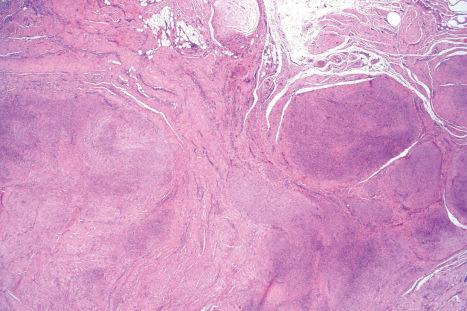
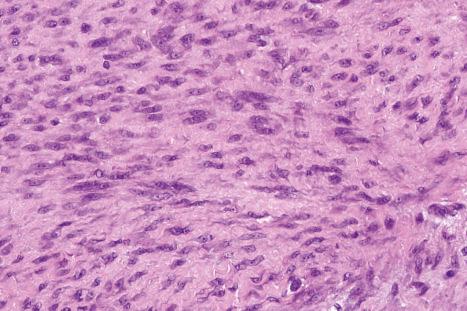
With the passage of time, maturation of the fibrous tissue leads to late lesions characterized by large amounts of hypocellular, hyalinized collagen ( Fig. 35.128 ). Scattered chronic inflammatory cells may be present at the periphery of the tumor, but there is no evidence of an active inflammatory process. Hemosiderin is uniformly absent, militating against a traumatic etiology. By immunohistochemistry, variable positivity for smooth muscle actin is seen, as expected in a myofibroblastic lesion. Desmin may be focally positive. Lesional cells are negative for CD34 and h-caldesmon. Nuclear β-catenin positivity is usually absent in superficial fibromatoses. However, occasional focal positivity may be seen. P16 is usually positive and estrogen receptor is expressed in many cases.
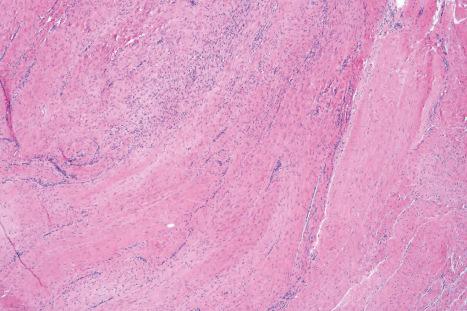
The degree of cellularity appears to correlate with the risk of local recurrence.
The only lesion that requires exclusion in the differential diagnosis is desmoid fibromatosis, which rarely occurs in the hand, is more uniformly cellular and tends to be deeper. Moreover, diffuse nuclear β-catenin positivity, although not specific for desmoid fibromatosis, is usually seen in the latter and not in palmar fibromatosis.
Plantar fibromatosis (Ledderhose disease) is essentially the equivalent of palmar fibromatosis affecting the foot (although flexion deformity only rarely develops). The condition may be bilateral, usually arising asynchronously. Although the overall age and sex distribution is similar to palmar fibromatosis, a significant proportion of cases occur in children or adolescents. Familial cases including occurrence in twins are rare. It is much less common than Dupuytren contracture and may be associated with it and with diabetes. Characteristically, it presents as single or multiple nodules on the medial aspect of the sole, usually just distal to the pedal arch. A variant of plantar fibromatosis presenting in children and characterized by nodules on the anteromedial aspect of the sole has been documented. Involvement of the plantar aspect of the heel in children is also seen.
Although most cases are asymptomatic, patients may complain of discomfort or a burning sensation, particularly after walking. Neurological symptoms due to entrapment of nerves are exceptionally encountered. Contracture of the toes is extremely rare. Local recurrence is very common. Plantar hyperkeratosis is a rare association.
Cytogenetic studies have revealed trisomy 8 and trisomy 14. Superficial fibromatoses are genetically distinct from deep fibromatoses in their lack of mutations in CTNNB1 , the gene encoding β-catenin.
The histologic and features are very similar to those of palmar fibromatosis; however, evidence of chronic inflammation or previous hemorrhage (both of which are probably secondary in nature) is more frequently present in plantar fibromatosis. Lesions also tend to be more consistently cellular and show much less tendency to hyalinize with time ( Fig. 35.129 ). Scattered multinucleated giant cells may be seen. Osseous metaplasia is exceptional.
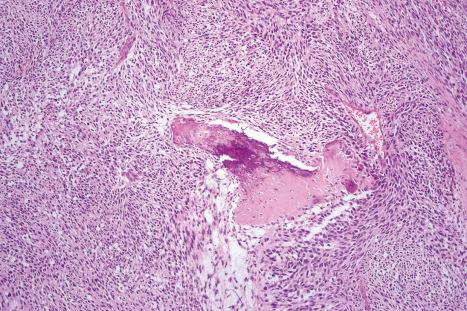
Penile fibromatosis (Peyronie disease) is an uncommon fibromatous lesion of the penis that results in pain or curvature on erection. The etiology is entirely unknown and although it has traditionally been considered to be a form of fibromatosis it appears more likely to represent an unusual fibrotic reaction developing in response to chronic inflammation, veno-occlusive dysfunction, or trauma, maybe in combination with genetic factors. Veno-occlusive dysfunction has been demonstrated by Doppler studies. The prevalence of the disease is higher in diabetic patients and in those with low testosterone levels. Hypertension and serum lipid abnormalities appear to have an impact in the severity of the symptoms and outcome. A case was reported in association with methotrexate therapy.
Peyronie disease usually presents as either solitary or multiple fibrous plaques adjacent to the corpora cavernosa, most often on the dorsal surface of the shaft. The peak incidence is in the fifth and sixth decades and there is no predilection for any particular racial group. The plaques rarely exceed 2 cm in diameter. The alleged rapidity of onset in many patients probably reflects the severe psychological problems that frequently develop. Spontaneous resolution is rare.
The microscopic appearances vary according to the duration of the condition. Early lesions are typified by a vasculitic and chronic inflammatory process in the loose connective tissue between the corpora cavernosa and penile fascia. This leads to an irregular reparative fibrotic process, culminating in the development of dense masses of hyalinized collagen with occasional foci of chronic inflammation ( Fig. 35.130 ). Occasionally, metaplastic ossification may occur. There is no differential diagnosis.
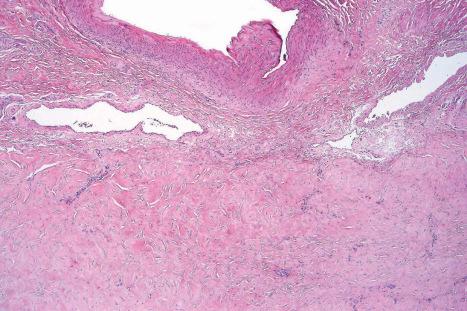
Desmoid fibromatosis represents a group of deep-seated fibrous neoplasms which can present in a variety of clinical settings. Although most cases are sporadic and solitary, some can be familial or associated with familial adenomatous polyposis (FAP, Gardner syndrome) and rare examples can be multicentric. A further subgroup presents in children. According to their anatomical distribution, desmoid tumors are classified into:
extra-abdominal (around 60% of cases),
abdominal (20–25%),
intra-abdominal (15%).
All of these anatomical subsets typically occur between the second and fourth decades of life with a predilection for females. Extra-abdominal fibromatoses are often sporadic and solitary. Most patients are young adults presenting with a slowly growing mass that may occasionally be painful. Tumors arise most often around the shoulder girdle or on the proximal lower limbs and rarely in the head and neck area, the latter group being commonest in children. Subcutaneous involvement is an occasional feature. A small proportion of tumors arise in association with a previous scar or post radiotherapy. Desmoid tumors arising in the anterior abdominal wall are particularly common in females, especially during or after pregnancy. Often, those arising after pregnancy appear at the site of the scar from a cesarean section. Many cases associated with FAP are intra-abdominal. Local recurrence is common even when excision is believed complete.
Desmoid fibromatosis occurring in children less than 10 years of age is referred to as infantile fibromatosis. Most patients with this form of fibromatosis present before the age of 5 and there is predilection for the head and neck, shoulder girdle or thigh. Infiltration of neighboring tissues may be prominent.
A nonrandom association with gastrointestinal stromal tumor has been reported. In addition, an association between desmoid fibromatosis and papillary thyroid carcinomas has been reported.
Familial adenomatous polyposis patients have germline inactivation of the adenosis polyposis coli gene ( APC ) which helps mediate the destruction of β-catenin. The location and type of mutation in FAP appear to affect likelihood of desmoid development. The tumors develop with loss of heterozygosity at the wild-type allele. Mutations in CTNNB1 , the gene encoding β-catenin, are seen in approximately 85 % of sporadic desmoids. Somatic mutations in APC can also be seen in sporadic cases. All of these genetic deficits allow unregulated accumulation of β-catenin in the nucleus. Cytogenetic anomalies include trisomies of chromosomes 8 and/or 20 and loss of Y and 5q where APC is located. Overactivation of the Wnt/APC/β-catenin pathway contributes to desmoid development by constitutive activation of pathways in common with fibrosis and scarring. In addition to β-catenin, VEGF overexpression may play a role in progression of sporadic desmoid tumors. Although etiologically there is clear evidence to suggest a genetic predisposition, this is probably secondarily influenced by trauma or sex hormones. It has been shown that high levels of estrogens can promote, but do not initiate, growth of desmoid tumors. Moreover, it has been suggested that macrophages and microangiogenesis may play a role in the biological behavior. AKT1 and BRAF mutations have been found in pediatric cases.
Histologic features are very similar in all subsets of desmoid tumor. Typical cases show a variegated appearance characterized by an admixture of plump spindled cells with rounded or tapering nuclei showing occasional mitotic figures embedded in a variably hyalinized or myxoid collagenous stroma ( Figs 35.131–35.133 ). At the periphery of the lesion, skeletal muscle fibers, subcutaneous fat and fascia are irregularly infiltrated, resulting in bizarre atrophic, degenerative or reactive muscle cell forms. Peripheral collections of chronic inflammatory cells, particularly lymphocytes, are common.
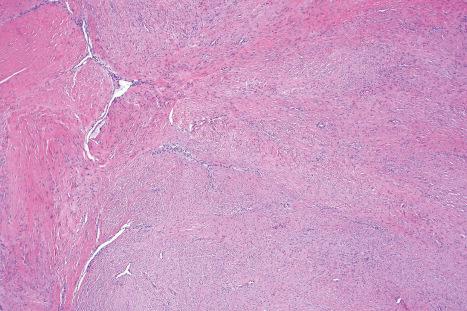
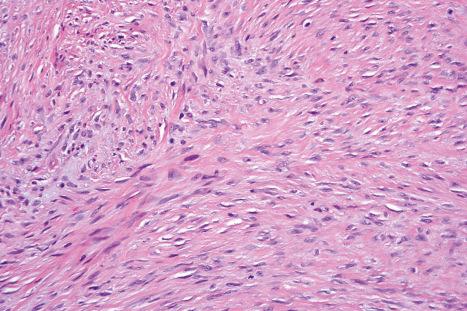
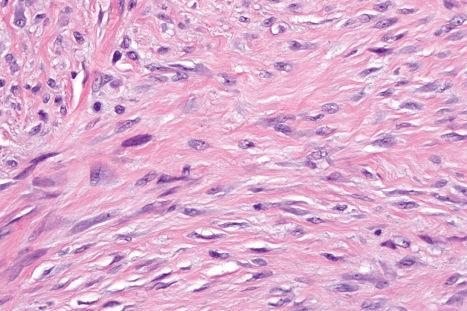
In children, tumors may show a pattern typical of extra-abdominal fibromatosis or else may show a pattern consisting of more immature round cells in a myxoid background.
Immunohistochemical studies show variable positivity of tumor cells for actin and only rarely and focally for desmin. Demonstration of nuclear accumulation of β-catenin can be helpful, but is not entirely specific ( Fig. 35.134 ).
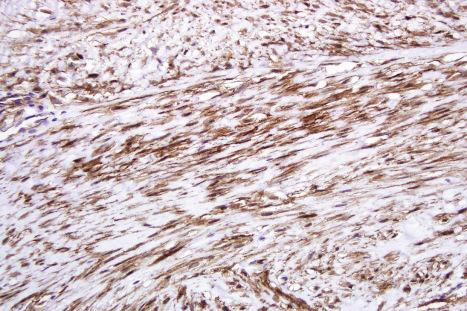
Occasional positivity for keratins and calretinin may lead to diagnostic pitfalls. Cytoplasmic, but not nuclear, positivity for WT1 has been described in young type fibromatosis. FAP-related lesions are also positive for COX2 and may be positive for cyclin D1 and TP53.
Ultrastructural studies show cells with features of myofibroblasts and fibroblasts.
The differential diagnosis is broad. The most important differential diagnosis is fibrosarcoma, which shows greater cellularity, nuclear atypia, prominent abnormal mitotic activity, a much lower collagen content and, typically, a herring-bone pattern. Scarring or reactive fibrosis can show virtually identical findings and here history is helpful. Distinction from myofibroblastic tumors including myofibroma is based on the fact that desmoid tumor is deep seated and infiltrative and shows β-catenin nuclear staining. Myofibroblastic tumors tend to be negative for the latter marker. CTNNB1 sequencing may be of help in challenging cases. CTNNB1 and APC genotyping can also aid screening for FAP when desmoid fibromatosis is diagnosed in children.
Lipofibromatosis is a neoplasm that presents in children as a subcutaneous mass measuring from 1 to 7 cm and involving mainly the upper and lower limbs, with predilection for the hand. Rare cases may present in the head and neck and back. Cardiac and orbit lesions have been reported. The rate of local recurrence or persistence is reported as being 72%.
In a single case a three-way translocation t(4;9;6) has been described.
Histology reveals large amounts of mature adipose tissue combined with a focal spindled fibroblastic element that tends to be localized mainly in the septa of the fat or within the neighboring skeletal muscle. Cytological atypia and mitotic figures are rare and univacuolated cells may be seen in the interface between the mature adipose tissue and the fibroblastic fascicles. Rarely, pigmented cells that are positive for melanocytic markers are seen. Congenital infantile fibrosarcoma with lipofibromatosis-like areas may occasionally be seen. Beta-catenin expression is not seen.
Giant cell fibroblastoma is a rare dermal or subcutaneous tumor that presents as a slowly growing mass up to 6 cm in diameter. It commonly affects children under 10 years of age (almost two-thirds of cases), especially males, but lesions may also occur in young, middle-aged and elderly adults. Exceptionally, a tumor may be congenital. It has a wide anatomical distribution with predilection for the trunk (back, chest and abdomen) and (less commonly) the proximal extremities. A tumor in the vulva and one in the penis have been reported. Local recurrence is seen in up to 50% of cases after incomplete excision. Some cases recur as dermatofibrosarcoma protuberans (see below) and this tumor is considered a pediatric form of this disease.
Giant cell fibroblastoma shares the same chromosomal abnormalities as those of dermatofibrosarcoma protuberans (see below). There is a t(17;22)(q22;q13) resulting in fusion of the platelet-derived growth factor B-chain ( PDGFB ) and the collagen gene COL1A1 . Ring chromosomes resulting from the t(17;22) are also seen. Microscopically, giant cell fibroblastoma is a poorly circumscribed dermal and superficial subcutaneous lesion composed of bland to moderately pleomorphic spindle and multinucleated giant cells (frequently floret-like) in a conspicuous loose myxoid stroma, which is sometimes focally hyalinized and typically contains irregular gaping sinusoidal spaces simulating vascular lumina ( Figs 35.135 and 35.136 ). The latter, however, are only lined discontinuously by hyperchromatic mononuclear or multinucleated giant cells, which do not stain for vascular markers ( Fig. 35.137 ). Mitotic figures are only rarely seen. Focal hemorrhage and perivascular lymphocytes in an onion-skin pattern are common. Exceptional tumors are purely dermal and rarely there is focal involvement of skeletal muscle. Tumor cells are positive for CD34 and also for CD99.
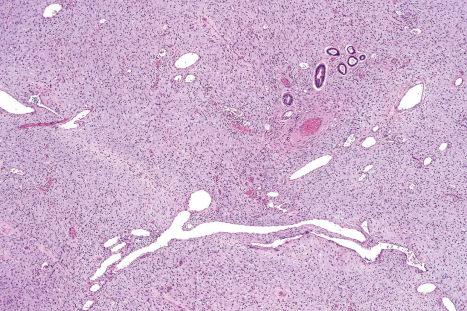
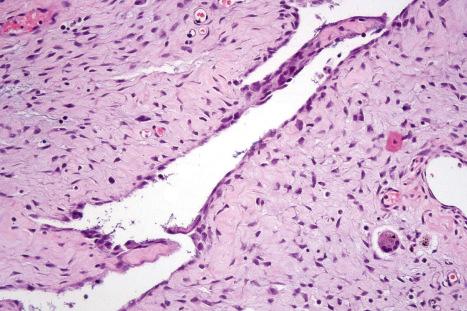
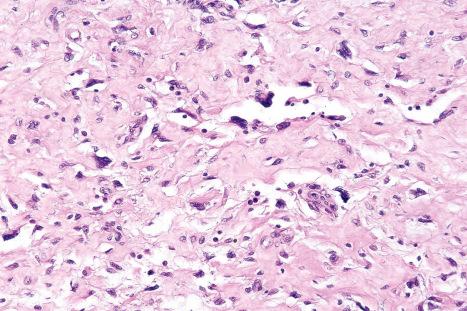
Ultrastructurally, and by immunohistochemistry, the tumor cells display fibroblastic features.
Giant cell fibroblastoma is closely related histogenetically to dermatofibrosarcoma protuberans, as demonstrated by the fact that some cases present combined histologic features, tumor cells in both lesions are CD34 positive and, more importantly, both tumors share the same cytogenetic abnormalities (see below) ( Figs 35.138 and 35.139 ). Cases of giant cell fibroblastoma may recur as dermatofibrosarcoma protuberans and vice versa. Bednár tumor (pigmented dermatofibrosarcoma protuberans) may also present primarily or recur with areas of giant cell fibroblastoma. Mixed tumors may have fibrosarcomatous areas and myoid nodules.
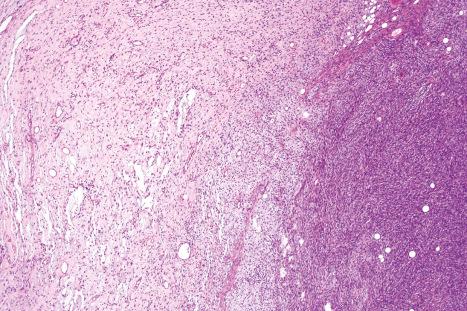
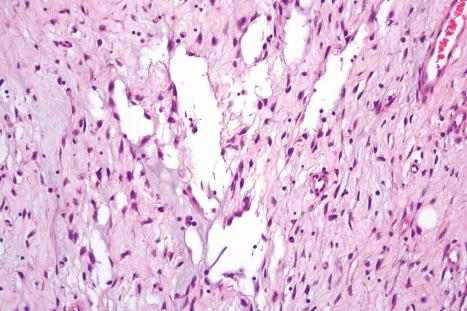
Distinction from other myxoid tumors is readily made based on the biphasic appearance of solid and angiectoid areas with giant cells. Fibrous hamartoma of infancy may rarely show areas resembling giant cell fibroblastoma and in these areas tumor cells are also positive for CD34. The diagnosis is usually established by the presence of the distinctive components seen in fibrous hamartoma of infancy.
Low-grade malignant lesions are defined as neoplasms with a high recurrence rate and very low metastatic potential.
Dermatofibrosarcoma protuberans typically presents in the third and fourth decades, shows a slight male predominance and is uncommon in the elderly. However, many patients have a long preoperative history (often 10–20 years), probably corresponding to the plaque phase. In these patients a patch develops and may have features resembling morphea, atrophoderma, or an angioma. Lesions can occur in children and some of these are congenital ( Fig. 35.140 ). Clinical diagnosis in this age group is difficult, as tumors often resemble a vascular birthmark. Occurrence at sites of previous trauma (including scars, vaccination, an arteriovenous fistula, a decorative tattoo and leishmaniasis) and even post-radiation tumors have been documented. Familial cases are exceptional and an association with HIV infection is probably coincidental. Accelerated growth during pregnancy has been reported in a case. Rare (probably coincidental) associations include multiple spindle cell lipomas and a nuchal fibroma.
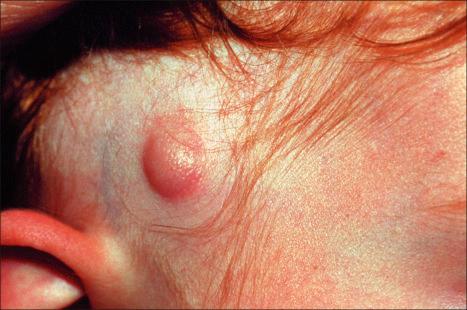
The tumor usually develops as a multinodular cutaneous mass, several centimeters in diameter that is slowly growing and appears to evolve from a dermal fibrous plaque stage. The overlying skin frequently shows a reddish-blue discoloration ( Figs 35.141–35.143 ). Presentation as an atrophic plaque is seen in some cases ( Fig. 35.144 ). Polypoid tumors are exceptionally seen. There is a marked predilection for the trunk (especially the abdominal wall and chest) and lower limbs (particularly the thighs). Involvement of distal extremities is very uncommon with most tumors developing on the foot (mainly the toes) and ankle and hardly any on the hands. Rare tumors occur in the vulva and exceptional cases have been reported in the oral cavity, penis, and male breast. Simultaneous occurrence of two tumors at different sites has been documented. Multicentric dermatofibrosarcoma protuberans in patients with adenosine deaminase-deficient severe combined immune deficiency has been documented.
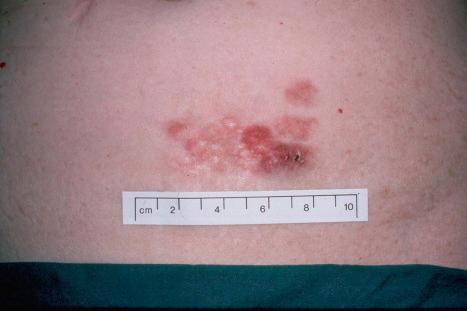
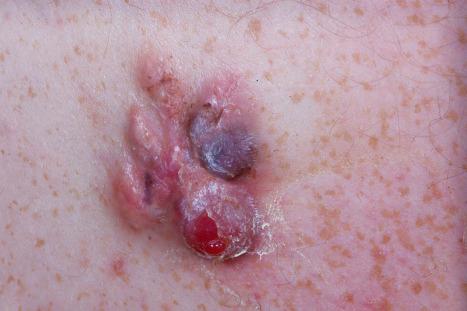
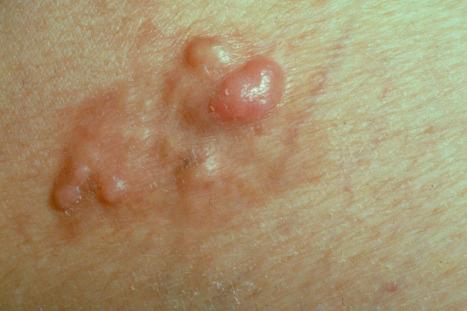
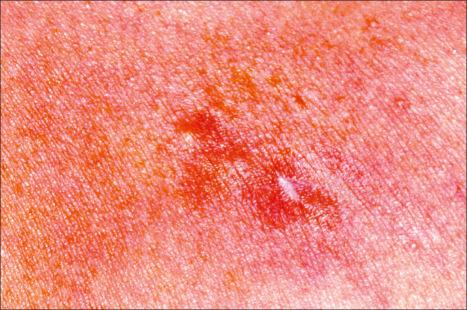
Purely subcutaneous tumors rarely occur and seem to have a predilection for head and neck.
Local recurrence is frequent and varies in different series from 20% to 50% of cases. However, in cases treated by wide excision or in those treated by Mohs micrographic surgery the rate of local recurrence is lower. A frequent subject of debate is how wide the excision has to be to reduce the rate of local recurrence. Although the tendency in the past was to advocate several excisions with margins of several centimeters, more recent studies suggest that smaller excision margins of 2 cm achieve good local control in many cases. Treatment with Mohs micrographic surgery using paraffin sections appears to be an excellent choice of treatment, allowing tissue conservation. Other therapeutic options include excision with wide margins with or without radiotherapy, depending on the margin status. For recurrent or metastatic tumors, targeted therapy may be of help (see below). A multidisciplinary approach is the best option when dealing with challenging cases. Intracranial invasion may occur in scalp lesions mainly after multiple recurrences. Metastasis is exceedingly rare, less than 0.3% in our experience; many of the cases reported to have metastasized are supported by inadequate or even incorrect histologic evidence. Metastasis usually occurs after repeated recurrences, often with fibrosarcomatous transformation. Fibrosarcomatous dermatofibrosarcoma protuberans recurs locally in 75% and the rate of metastasis is up to 23% of cases in some series. However, in a more recent series, the rate of local recurrence (20%) and metastatic rate (10%) is much less than that reported in the past. Aggressive behavior appears is suggested to be related to mitotic activity, pleomorphism and necrosis.
The genetic abnormalities found in dermatofibrosarcoma protuberans and giant cell fibroblastoma are identical, further indicating that they represent a spectrum. As expected, other histologic variants of dermatofibrosarcoma protuberans – including Bednár tumor, dermatofibrosarcoma protuberans with granular cell change and fibrosarcomatous dermatofibrosarcoma protuberans – show the same cytogenetic abnormalities. Ring chromosomes derived from chromosome 22 containing low-level amplified sequences from 17q22-qter and 22q10-q13.1 or t(17;22) are the most frequent finding. In both the rings and linear der(22) a specific fusion of COL1A1 and PDGFB is found. Ring chromosomes are mainly observed in adults, whereas translocations are present in all pediatric cases. The breakpoint localization in PDGFB is remarkably constant, placing exon 2 under control of the COL1A1 promoter. In contrast, the COL1A1 breakpoint is variably located within the exons of the α-helical coding region (exons 6–49).
Evidence of the COL1A1-PDGFB fusion by multiplex reverse transcription polymerase chain reaction or fluorescence in situ hybridization assays is present in almost all cases.
A recent study of ordinary DFSP and tumors with fibrosarcomatous transformation suggested an association between the activation of the Akt-mTOR pathway proteins and PDGFR with progression from ordinary DFSP to fibrosarcomatous DFSP. A case of fibrosarcomatous DFSP expressing programmed death-ligand 1 (PD-L1) in the metastasis but not in the primary tumor has been reported.
Clonal evolution consisting of different somatic mutations and novel focal amplifications, has been found in metastatic samples but no in those obtained before metastasis is a single patient. In a further study, no significant copy number alterations, insertion, or deletions was observed during imatinib treatment response. However, emergence of 8 new non-synonymous somatic gene mutations in imatinib-resistant tumor tissue was identified.
PDGFB appears to act as a mitogen in tumor cells of dermatofibrosarcoma protuberans by autocrine stimulation of the PDGF receptor. Interestingly, imatinib mesylate (an antagonist of the PDGF receptor α tyrosine kinase) has been found to have an inhibitory effect in vivo and has been used with variable success in multiple cases of dermatofibrosarcoma protuberans (mainly in patients with unresectable or recurrent tumors and those with metastatic disease). The rate of response has been estimated to be up to 50%.
A single case of dermatofibrosarcoma protuberans-like tumor with COL1A1 copy number gain without t(17;22) has been described. In this case, tumor cells were positive for CD3 and H-caldesmon and very focally positive for EMA and SMA.
The microscopic appearances vary little from case to case. The tumor is located in the dermis, but invariably shows diffuse irregular infiltration of the subcutaneous fat in a typical lace-like pattern or bundles of cells which ramify parallel to the epidermis ( Figs 35.145 and 35.146 ). Rare cases may be mainly or exclusively subcutaneous. Epidermal hyperplasia is very rare but does occur and the degree of hyperplasia seems to be inversely related to the distance of the tumor from the epidermis.
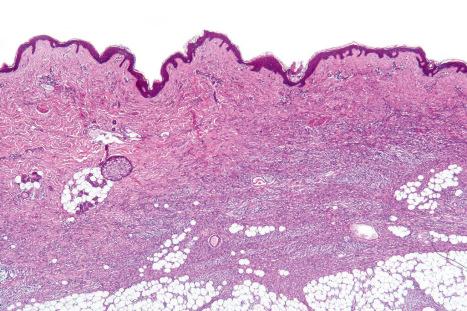
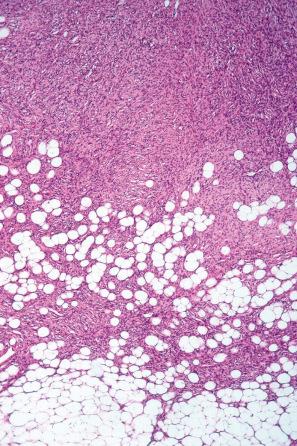
The lesion is composed almost entirely of fairly uniform spindled cells with elongated nuclei showing little or no pleomorphism and scanty pale cytoplasm. The cells are characteristically arranged in a storiform or ‘rush mat’ pattern typified by numerous whorls of cells, sometimes centered around small blood vessels ( Figs 35.147–35.149 ).
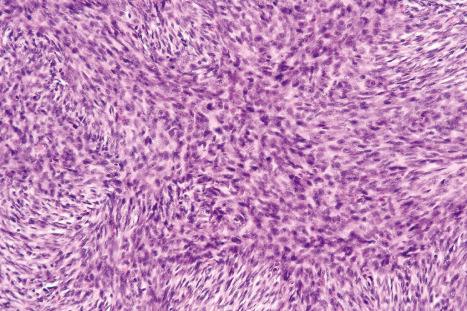
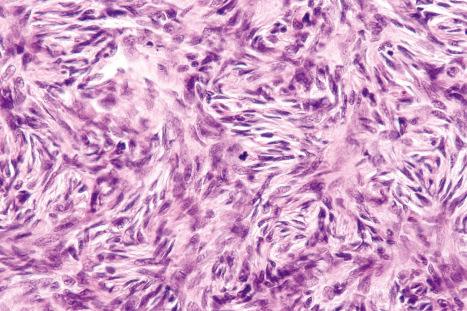
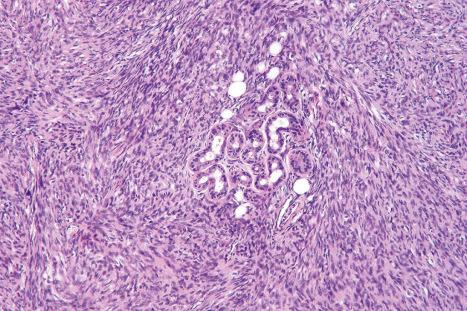
Mitotic activity, rarely abnormal in appearance, is scanty, not usually exceeding five mitoses per 10 high-power fields. Peripheral collections of chronic inflammatory cells are sometimes present, as are foci of myxoid degeneration, but necrosis is rarely a feature and is always minimal ( Fig. 35.150 ). Cytological polymorphism is not a feature except in those infrequent cases showing overlap with giant cell fibroblastoma. However, in some cases, occasional nonpleomorphic giant cells are present. Focal histologic variation may be seen and includes areas of sclerosis, palisading, formation of Verocay-like bodies, granular cell change, meningothelial-like whorls and pseudocystic spaces. In a case treated with imatinib mesylate prominent hyalinized collagen was seen.
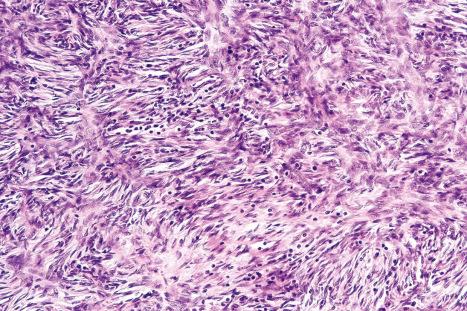
Immunohistochemically, tumor cells are usually diffusely positive for CD34 and negative for other markers including factor XIIIa, S100 protein, desmin, actin and, with rare exceptions, CD117 ( Fig. 35.151 ). Staining for EMA has been reported and, based on this finding, a perineural line of differentiation has been suggested although this marker is not specific. CD99 is also positive in a number of cases. Stromelysin, cathepsin K and D2–40 have been reported as useful markers in the differential diagnosis between dermatofibroma and dermatofibrosarcoma protuberans, as they tend to be positive in the former and negative in the latter. Cthrc1 (collagen triple helix repeat containing-1) and Apo D, on the other hand, tend to be positive in dermatofibrosarcoma protuberans and negative in dermatofibroma. Other markers that have been reported as useful in dermatofibrosarcoma protuberans include low-affinity nerve growth factor receptor (p75) and tenascin. Tumor cells in dermatofibroma and dermatofibrosarcoma protuberans show positive staining with tenascin but staining of the dermal–epidermal junction overlying the tumor is only seen in dermatofibroma.
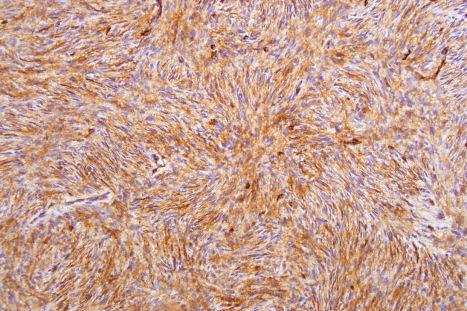
Although the line of differentiation in dermatofibrosarcoma protuberans has been controversial for many years, it is increasingly being accepted as a fibroblastic tumor ( Figs 35.152 and 35.153 ).
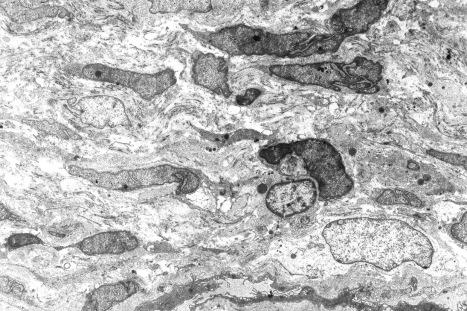
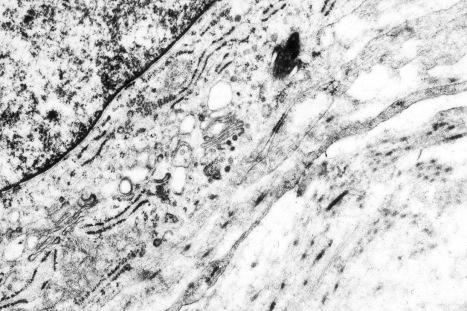
Fibrosarcomatous dermatofibrosarcoma is a variant in which a focal fascicular or ‘herring-bone’ pattern is present. Fibrosarcomatous transformation may occur either de novo or in the recurrence of a typical dermatofibrosarcoma protuberans. These areas are more cellular, show more nuclear atypia and the mean mitotic count is higher than in typical dermatofibrosarcoma ( Figs 35.154 and 35.155 ). Focal loss or less intense staining with CD34 is seen in the fibrosarcomatous areas. Fibrosarcomatous dermatofibrosarcoma combined with Bednár may occur. A case with formation of giant rosettes and one with a plexiform growth pattern have been reported.
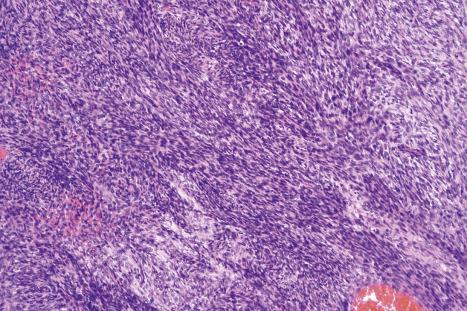
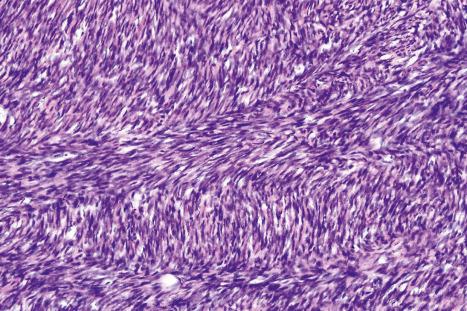
Progression in dermatofibrosarcoma protuberans to the fibrosarcomatous variant appears to be related to microsatellite instability and mutations in TP53 as early and late events respectively.
In rare cases, areas of a high-grade sarcoma may be found within an otherwise ordinary dermatofibrosarcoma protuberans. These areas can mimic a myxofibrosarcoma or a pleomorphic malignant fibrous histiocytoma. It is not clear what the prognosis of these tumors is, as the occurrence of this phenomenon is very rare. Interestingly COL1A1-PDGFB fusion transcripts is also detected in sarcomatous areas of the tumor.
Pigmented dermatofibrosarcoma (also known as the Bednár tumor or formerly as pigmented storiform neurofibroma) contains dendritic melanocytes and small deposits of melanin pigment within an otherwise typical tumor ( Figs 35.156 and 35.157 ). The presence of melanocytes within the tumor is puzzling and is probably secondary to colonization. An alternative view proposes neuroectodermal multidirectional differentiation to explain this phenomenon.
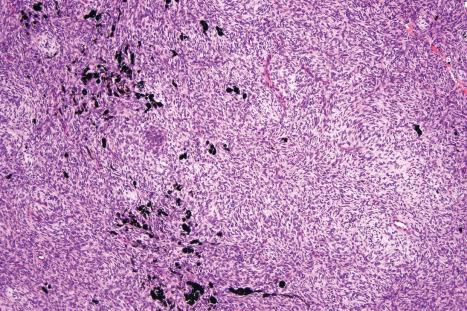
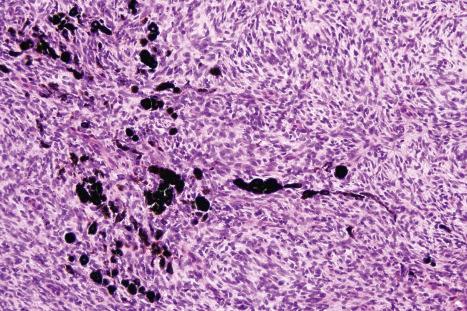
Myxoid dermatofibrosarcoma is a term used to describe rare cases in which the more typical features may be only focally identifiable because of extensive myxoid degeneration ( Figs 35.158–35.160 ). Macroscopically, tumors are gelatinous. Thin-walled blood vessels are prominent. Myxoid change may occur in association with any variant of the tumor.
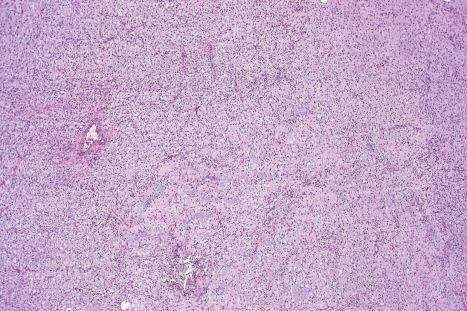
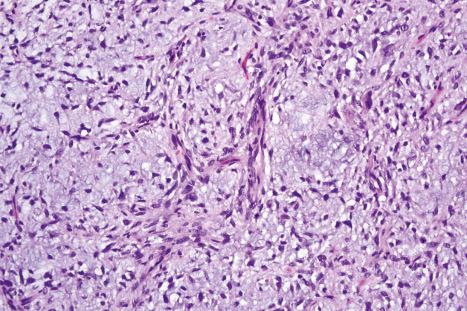
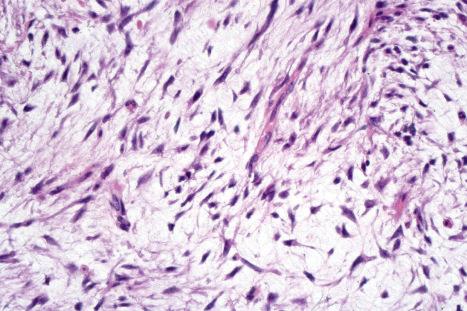
Dermatofibrosarcoma with areas of giant cell fibroblastoma has already been discussed.
Dermatofibrosarcoma with myoid nodules refers to cases showing areas composed of bundles of eosinophilic SMA-positive spindle, desmin-negative cells indicating myofibroblastic differentiation ( Figs 35.161 and 35.162 ). Most cases of dermatofibrosarcoma protuberans with myoid nodules have fibrosarcomatous areas. Small biopsies can cause confusion with myofibroblastic lesions, such as adult myofibroma, but other typical features of dermatofibrosarcoma are usually evident. It has been suggested that the myoid nodules do not represent true myofibroblastic differentiation but rather residual smooth muscle originating from blood vessels destroyed by the tumor. However, the bundles of myoid cells are usually positive for actin and negative for desmin and H-caldesmon, suggesting myofibroblastic rather than smooth muscle origin/differentiation.
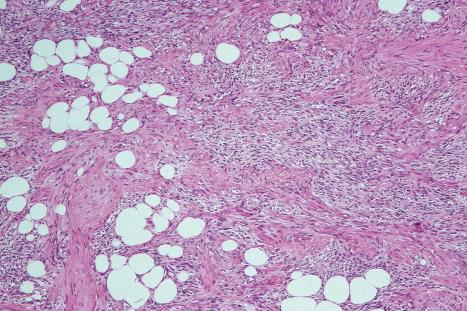
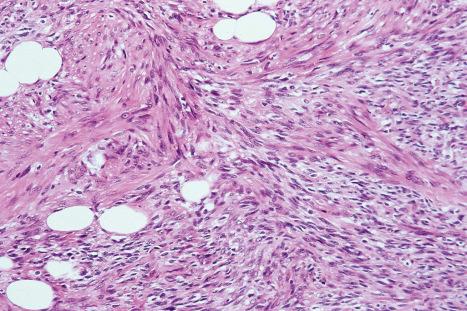
Flow cytometry studies in dermatofibrosarcoma protuberans often show aneuploidy.
The differential diagnosis includes fibrous histiocytoma, especially its cellular variant, dermatomyofibroma, perineurioma, plaque-like CD34-positive dermal fibroma (medallion-like dermal dendrocyte hamartoma) and neurofibroma (mainly in the superficial part of the tumor). Fibrous histiocytoma tends to be CD34 negative, shows cytological polymorphism, only a focal storiform pattern and limited superficial infiltration of the subcutis, usually in a radial pattern. Epidermal changes (especially hyperplasia) are much more commonly associated with fibrous histiocytoma than with dermatofibrosarcoma protuberans. Cellular fibrous histiocytoma may show positivity for CD34 but this is often in the periphery of the tumor and associated with focal staining for SMA. Plaque-like CD34-positive dermal fibroma (medallion-like dermal dendrocyte hamartoma) has to be distinguished from the plaque stage of dermatofibrosarcoma protuberans. The former occurs predominantly but not exclusively in children, is a neoplasm of the reticular dermis that tends not to extend to the subcutaneous tissue and consists of CD34-positive fibroblast-like cells with superficial cells oriented perpendicular to the epidermis and deep cells oriented parallel to the epidermis. The superficial part of a dermatofibrosarcoma protuberans may mimic neurofibroma, as the storiform pattern is usually lacking, and this is a particular problem in superficial samples. Immunohistochemistry for CD34 and S100 is crucial as the latter is positive for both markers and the former positive for CD34. It has been suggested that there is a small subgroup of indeterminate fibrohistiocytic tumors of the skin in which it is not possible to distinguish accurately between dermatofibrosarcoma protuberans and fibrous histiocytoma because of histologic and immunohistochemical overlap; however, these tumors lack the COL1A1-PDGFB fusion transcript. Distinction between neurofibroma and the myxoid variant of dermatofibrosarcoma is based on the storiform growth pattern, CD34 expression and S100 protein negative cells in the latter condition.
Myxoinflammatory fibroblastic sarcoma (acral myxoinflammatory fibroblastic sarcoma, inflammatory myxohyaline tumor, inflammatory myxoid tumor of the soft parts with bizarre giant cells) is a distinctive, rare, low-grade tumor with marked predilection for the hands (around 80% of tumors mainly affecting fingers) and to a much lesser extent, the feet. The ankles and wrists may also be involved and, rarely, tumors have been described on the forearm, upper arm, thigh, chest wall, face and nose. Most tumors present in middle-aged adults, with exceptional lesions occurring in children and adolescents. Tumors present as a slowly growing, ill-defined, dermal and subcutaneous (usually asymptomatic) mass measuring between 1 and 6 cm, and there is no sex predilection. Larger tumors may also be seen. An intramuscular location has rarely been reported. Pain is an occasional symptom. The clinical diagnosis is usually an inflammatory process, a ganglion cyst or a giant cell tumor of tendon sheath. A case occurred in a renal transplant patient. Local recurrences are seen in 22% to 67% of cases and may occur many years after the primary tumor has been excised. Regional lymph node metastasis has been reported in rare cases and distant metastases are exceptional, with only one patient dying of disease.
Cytogenetic studies have shown a t(1;10) with rearrangements of TGFBR3 and/or MGEA5 in about 18% of cases. No functional fusion transcript is formed from the translocation, but upregulation of both FGF8 and NMP3 , two genes in the vicinity of MGEA5 , does occur. Loss of material from chromosome 3 has also been reported and in rare individual cases further abnormalities include a t(2;6)(q31;p21) translocation, a complex karyotype one with supernumerary ring chromosomes composed of chromosome 3 material and one with duplication of chromosomes X and 19. Based on morphological similarities and some cytogenetic studies it has been suggested that there is a relationship between myxoinflammatory fibroblastic sarcoma, hemosiderotic fibrolipomatous tumor and pleomorphic hyalinizing angiectatic tumor. This view however, is not universally accepted. Although it seems clear that hemosiderotic fibrolipomatous tumor and pleomorphic hyalinizing angiectatic tumor are related, it is not clear whether the latter two neoplasms are related to myxoinflammatory fibroblastic sarcoma. Furthermore, recurrent BRAF gene rearrangements have been recently found in myxoinflammatory fibroblastic sarcomas, but not in hemosiderotic fibrolipomatous tumors.
Histology shows a multinodular and poorly circumscribed tumor with prominent myxoid change and focal areas of hyalinization ( Figs 35.163–35.165 ). In the background, there are neutrophils, eosinophils, lymphocytes, plasma cells and variable numbers of pleomorphic mono- or multinucleated large cells with vesicular or hyperchromatic nuclei. These cells often have a prominent inclusion-like nucleolus. They may mimic ganglion cells, Reed-Sternberg cells or lipoblasts, and are sometimes masked by the intense inflammatory cell infiltrate. Hemosiderin deposition can be prominent. Mitotic figures, although present, are not conspicuous.
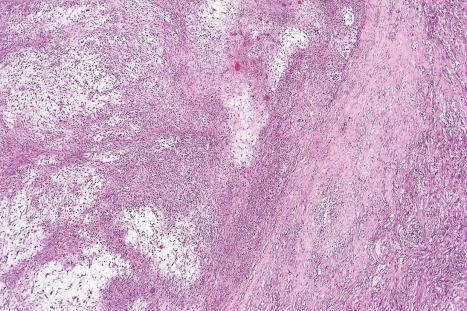
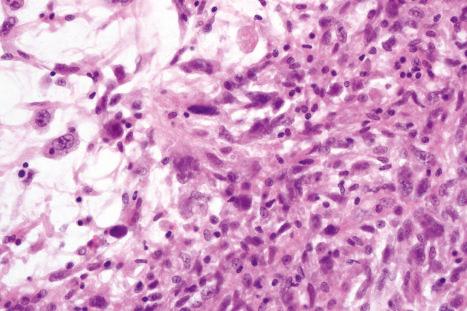
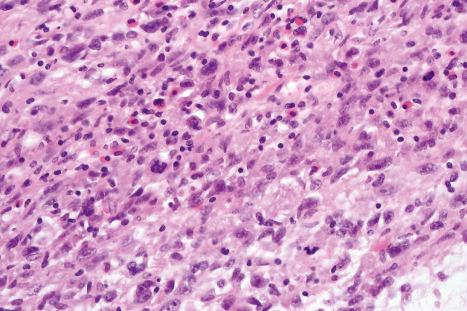
Tumor cells are positive for SMA, CD68, CD163, D240 and CD34.They may be focally positive for EMA and keratins; positivity for EGFR, D2-40 and S100 has also been reported.
Acral myxoinflammatory fibroblastic sarcoma is most likely to be mistaken for an inflammatory condition but the presence of bizarre tumor cells should alert the pathologist to the correct diagnosis. Distinction from myxofibrosarcoma is based on the absence of prominent inflammation in the latter condition and also the knowledge that myxofibrosarcoma is very rare on the hands and feet. Epithelioid sarcoma may enter the differential diagnosis. It often has areas of necrosis, tumor cells are epithelioid or short and spindled, and keratin is consistently positive.
Inflammatory myofibroblastic tumor (inflammatory fibrosarcoma, inflammatory pseudotumor) is a term that includes a heterogeneous group of lesions characterized by proliferation of fibroblasts and myofibroblasts in a background of numerous inflammatory cells. Most cases occur in children, usually in visceral organs (particularly the lung but also in the liver, heart, gastrointestinal tract, pancreas and urinary bladder), mesentery, omentum and (less commonly) the soft tissues (limbs and head and neck). Oral, laryngeal, bone and lymph node lesions may also occur. The tumor presents less frequently in young adults but is exceptional after the age of 30. Comparable examples in the skin have only exceptionally been reported. Systemic symptoms including high erythrocyte sedimentation rate (ESR), anemia, fever and weight loss occur in up to 30% of cases. Rare associations include obliterative phlebitis and dermatomyositis. Intestinal obstruction may be the cause of presentation in intra-abdominal tumors. Rare tumors have been described at the site of a tooth extraction and at the location of a pace maker. The prognosis is good in most cases but local recurrences and exceptional metastasis occur.
Excision is the most effective treatment. Targeted therapies seem promising.
Epithelioid inflammatory myofibroblastic sarcoma is an aggressive variant of inflammatory myofibroblastic tumor with the ALK fused to RANBP2 leading to a nuclear membrane or perinuclear distribution of ALK on immunohistochemistry. It occurs in young adults, usually intra-abdominally and shows male predilection.
Rearrangement of the anaplastic lymphoma kinase (ALK) gene has been detected in more than half of inflammatory myofibroblastic tumors. Immunohistochemical reactivity for the ALK protein is demonstrated in these tumors. In a subset of ALK negative tumors gene rearrangements and fusions in ROS1 , PDGFRB , ETV6 , NTRK3 have also been documented. Immunohistochemical expression of ROS1 correlates with ROS1 gene rearrangements.
Histologically the tumors are well circumscribed and those presenting in the skin are located in the deep dermis or subcutis. The proportion of fibroblasts/myofibroblasts varies among tumors. Lesions have prominent or moderate cellularity with a myxoid background or appear fairly hypocellular with areas of sclerosis and hyalinization often simulating a scar ( Fig. 35.166 ). Focally, tumor cells have a histiocyte-like or Reed-Sternberg appearance and may resemble ganglion cells. In most tumors there is a variable mixed inflammatory cell infiltrate composed of numerous plasma cells, lymphocytes, histiocytes, neutrophils, eosinophils and occasional giant cells ( Figs 35.167 and 35.168 ). Rare lesions do not display prominent inflammation. Germinal centers and proliferation of high endothelial venules may be a feature and, on low-power examination, lesions sometimes vaguely resemble a lymph node.
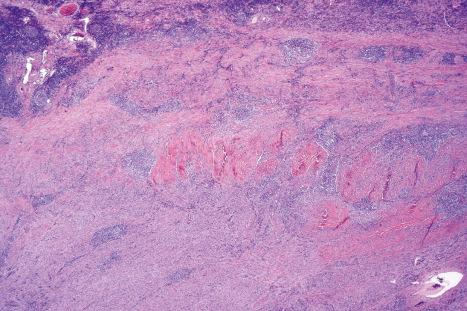
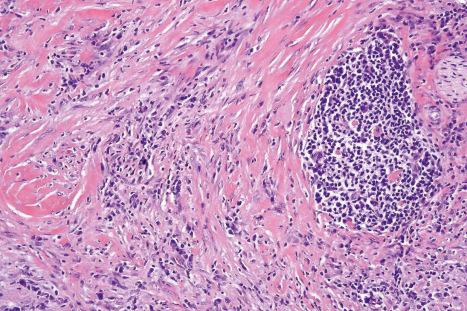
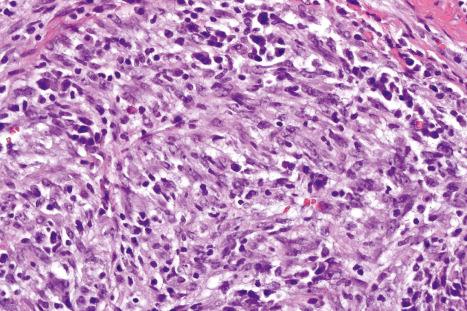
Tumor cells are usually positive for smooth muscle actin, muscle specific actin and calponin. Focal desmin and cytokeratin positivity has also been reported and in up to 50% of cases there is cytoplasmic and less often nuclear positivity for anaplastic lymphoma kinase (ALK-1) which correlates with rearrangements at chromosome 2p23 with a variety of partners that change the cellular compartment localization of the constitutively active fusion kinase. Recently, a new antibody (D5F3) for ALK, has been reported to show superior results.
Some of these translocations are also seen in anaplastic large cell lymphoma.
Epithelioid inflammatory myofibroblastic sarcoma is composed of epithelioid cells and a minor spindle cell element in a myxoid stroma. Typically, an inflammatory cell infiltrate consisting mainly of neutrophils and lymphocytes is seen. Immunoreactivity for ALK, nuclear membrane or perinuclear, is distinctive. Tumor cells may also express SMA, desmin and CD30.
The main differential diagnosis is with other myofibroblastic tumors, mainly low-grade myofibroblastic sarcoma. The latter usually lacks inflammation, is more monomorphic and infiltrative and is not associated with positivity for ALK-1 or cytokeratin.
Inflammatory processes, Epstein–Barr virus (EBV)-associated myofibroblastic proliferations, IgG4 sclerosing disease and dendritic reticulum cell sarcoma must be distinguished from inflammatory myofibroblastic tumor. IgG4 positive cells can be seen in inflammatory myofibroblastic tumor suggesting a possible pathogenetic link.
Solitary fibrous tumor is a distinctive neoplasm that presents mainly in the pleura but has increasingly been reported at numerous sites including solid organs, soft tissues (mainly limbs and head and neck) and (more rarely) the skin where a small number of cases have been documented. Lesions also occur in the oral cavity and orbit. Almost any site can be affected. Multiple tumors are very rare. Most tumors present as a fairly circumscribed, slowly growing, asymptomatic mass in middle-aged to elderly patients, with no sex predilection. Rare cases, mainly in the pleura, are associated with hypoglycemia (Doege-Potter syndrome) and finger clubbing (Pierre-Marie-Bamberg syndrome). Hypoglycemia can be due to the secretion of insulin-like growth factor 2 by tumor cells. The majority of cases behave in a benign fashion, but a small percentage may recur locally or even metastasize to internal organs. Aggressive behavior does not strictly correlate with morphology, as a number of tumors with no apparent histologic features suggestive of malignancy have metastasized. Several histologic parameters have been studied to predict clinical behavior. The most consistent reported parameter seems to be mitotic activity. Positive resection margins correlate with recurrence and metastatic potential is higher in large (>10 cm) tumors. A risk assessment model depending on patient age, tumor size, mitotic activity and necrosis has been proposed in which patients older than 55 with large tumors (> or = to 15 cm), necrosis and mitotic activity > or equal to 4 per 10 high power fields are more likely to have adverse outcome. Extrathoracic tumors metastasize more frequently than those occurring in the thorax. Some studies suggest a correlation between behavior and fusion gene variants and also with overexpression of growth factors.
Surgical excision is the treatment of choice. For aggressive or unresectable tumors radiotherapy and or systemic therapy may be considered. Although cutaneous lesions may rarely recur, a more aggressive behavior has not been reported so far in these tumors.
Inv12(q13q13)-derived NAB2 - STAT6 gene fusions have been consistently identified in solitary fibrous tumors.
The features are those of a usually well-circumscribed tumor, typically described as having a patternless architecture ( Figs 35.169–35.171 ). Hypo- and hypercellular areas alternate throughout the lesion and in the background there is prominent hyalinized collagen with a focal keloidal appearance and a prominent vascular network with a hemangiopericytomatous pattern and perivascular hyalinization ( Figs 35.172 and 35.173 ). Tumor cells are round to short and spindled, with vesicular nuclei and little or no cytologic atypia. Mitotic activity is usually low. Myxoid change may be prominent and has been highlighted in a cutaneous tumor. Accumulation of collagen may form amianthoid-like bodies. Mature adipocytes are sometimes a feature and can be prominent Such tumors were initially described as lipomatous hemangiopericytoma, are part of the spectrum of solitary fibrous tumor, and have been designated as fat forming solitary fibrous tumor. Rare lesions may show histologic features of malignancy including cytologic atypia, increased mitotic activity, high cellularity and necrosis. Giant cell angiofibroma is a variant of solitary fibrous tumor (giant cell rich solitary fibrous tumor) and is described below. Exceptional cases display abrupt transition to a high-grade sarcoma with loss of CD34 expression and strong reactivity of TP53 and P16. This feature has been regarded as dedifferentiation and is associated with aggressive behavior and mortality. Heterologous elements (osteosarcomatous and rhabdomyosarcomatous) are exceptional. Although some cases displaying dedifferentiation have been reported in soft tissues, this feature has not been reported in the skin.
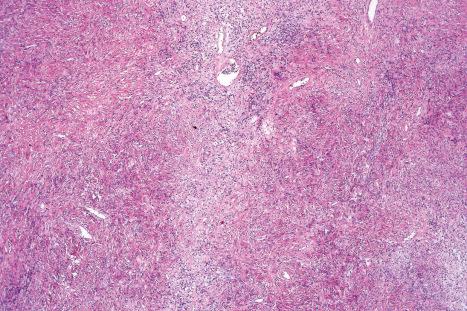
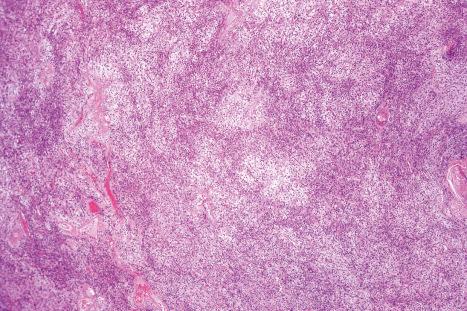
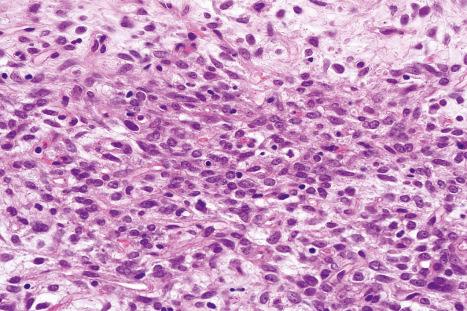
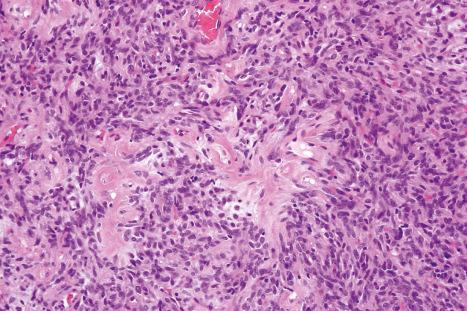
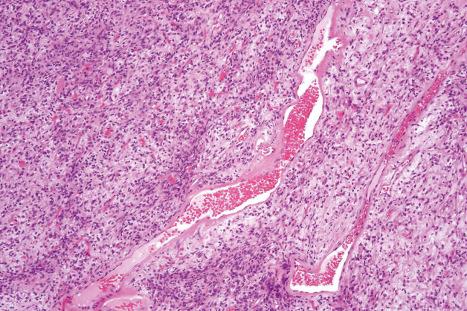
By immunohistochemistry, tumor cells are almost invariably, diffusely positive for CD34 and for CD99 ( Fig. 35.174 ), and in a smaller percentage of cases for SMA, EMA and bcl2. S100 protein, desmin and cytokeratin may be positive focally. Nuclear immunoreactivity for STAT6 is consistent but not specific for solitary fibrous tumor as is GRIA2. Nuclear β-catenin, PAX2 and PAX8 have been reported as positive in a subset of tumors. Insulin-like growth factor 2 is highly expressed in tumor cells.
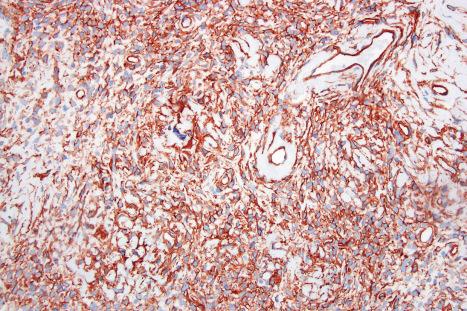
Distinction from a fibrous histiocytoma is based on the relative lack of circumscription, the polymorphism and the negative or only very focal positive staining for CD34 in the latter condition. Dermatofibrosarcoma protuberans is diffusely positive for CD34 and GRIA2 but is widely infiltrative and consists of monotonous cells arranged in a storiform pattern. Fat -forming variants should be differentiated from liposarcoma. Sometimes, depending on the predominant features, solitary fibrous tumor may resemble hemangioma, desmoid fibromatosis, sarcomas (mainly synovial sarcoma), atypical spindle cell lipomatous tumor, spindle cell carcinoma and spindle cell melanoma.
Giant cell angiofibroma is a distinctive form of a giant cell-rich variant of solitary fibrous tumor occurring mainly in the orbit but also presenting elsewhere in the head and neck (including the oral cavity and pharynx), trunk, groin, vulva and perianal area. An exceptional case in the mediastinum has also been described. Patients are usually middle-aged adults and although orbital lesions have predilection for males, extraorbital lesions affect mainly females.
Tumors are asymptomatic, subcutaneous, slowly growing and measure only a few centimeters in diameter. Local recurrence is rare. Aggressive behavior, however, has not been documented in any cases.
Cytogenetic studies in a one case showed abnormalities of chromosome 6q, while another showed t(12;17)(q15;q23). NAB2-STAT6 fusion transcripts have been identified in some cases of solitary fibrous tumor with giant cell angiofibroma-like features.
Histology shows a well-circumscribed mass with variable cellularity composed of small or medium-sized vascular channels with thick walls, pseudovascular spaces, a combination of round and short spindle-shaped cells and a variable number of multinucleated giant cells ( Figs 35.175–35.177 ). The latter often seem to be lining the pseudovascular spaces. Mitotic figures are rare. The stroma is myxoid or sclerotic.
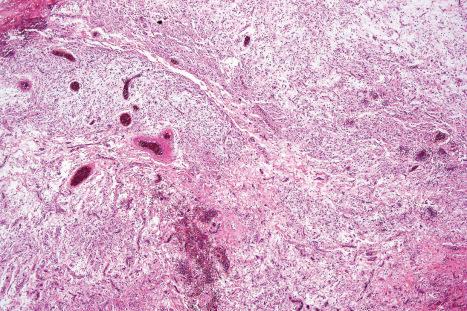
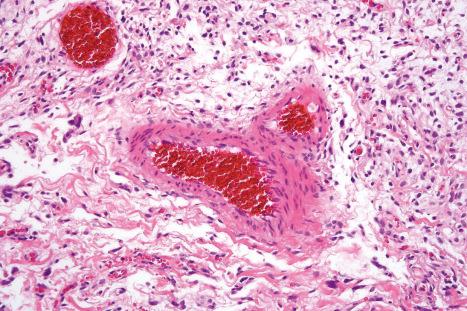
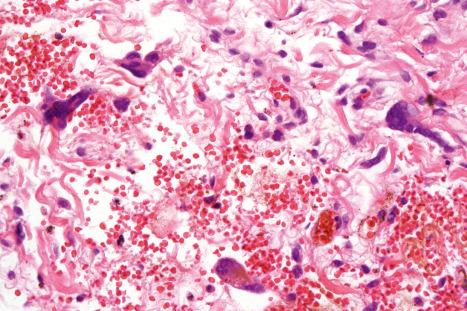
Low-grade myofibroblastic sarcoma is a rare distinctive tumor that presents as a deep-seated mass in the limbs and head and neck of adults, with a slight male predilection. Tumors may rarely occur in bone, the oral cavity, heart, abdomen, stomach, breast, vulva, thoracic spine and larynx. A single cutaneous tumor has been described. A case in association with a desmoplastic melanoma has been reported. Multicentricity is exceptional. Local recurrence is common and metastatic disease is rare.
Histology shows an infiltrative tumor composed of fascicles of cells with indistinct cytoplasmic margins, pale pink cytoplasm and elongated, vesicular nuclei. In some lesions there is variable cellularity. Cytologic atypia is not prominent but is always present. Mitotic activity tends to be low. In a single case intracytoplasmic hyaline inclusions have been reported. It has been suggested that in tumors of the head and neck, aggressive behavior is associated with higher mitotic activity and necrosis.
Tumor cells are positive for smooth muscle actin, muscle specific actin and calponin. There may be focal positivity for desmin but h-caldesmon is negative. ALK-1 and keratin are also negative a feature that allows distinction from inflammatory myofibroblastic tumor. Beta-catenin shows no nuclear staining, a feature that allows distinction from desmoid fibromatosis.
Ultrastructural examination reveals subplasmalemmal bundles of myofilaments and fibronexus.
Infantile fibrosarcoma presents before the age of 10 years. The great majority of patients are less than 2 years of age and tumors are often congenital with a predilection for males. It frequently presents as a subcutaneous tumor with predilection for the limbs, but not uncommonly arises on the head and neck. Unusual locations include penis, scalp, lung, retroperitoneum, infratemporal area and heart. Some tumors can be very large. The clinical course is much less aggressive than that of its adult counterpart and the 5-year survival is higher than 80%. Local recurrence is seen in up to 25% of cases. Metastases are rare but may occur even before birth. Cases associated hypercalcemia, a case associated with coagulopathy, one with fetal anemia and a further with urticaria pigmentosa have been described. Clinically it may mimic vascular lesions or a sacrococcygeal teratoma.
Cytogenetic studies of infantile fibrosarcoma have shown a t(12;15)(p13;q26) resulting in activation of the NTRK3 receptor tyrosine kinase gene, leading to a recurrent ETV6-NTRK3 gene fusion. This same translocation can also be associated with cellular congenital mesoblastic nephroma, which is considered its renal counterpart. This fusion has also been reported in other neoplasms such as acute myeloid leukemia, mammary type secretory carcinoma of the skin and salivary glands and secretory breast carcinoma. EML4-NTRK3 fusion transcripts are also rarely found. A small subgroup of cases displaying overlapping histologic features with infantile fibrosarcoma, occurring in older children and adolescents and with predilection for axial sites, display BRAF gene fusions. In a further case with similar features a TPM3-NTRK1 fusion transcript was identified.
Microscopic appearances are very similar to those of the adult variant ( Figs 35.178–35.180 ). However, some cases show more primitive rounded cells and/or a hemangiopericytoma-like pattern mimicking myofibroma. A case with a lipofibromatosis-like component has been described. Tumor cells are positive for vimentin and sometimes focally positive for actin.
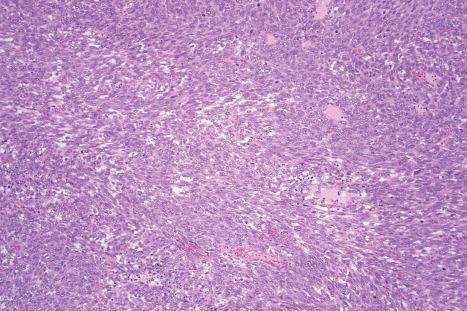
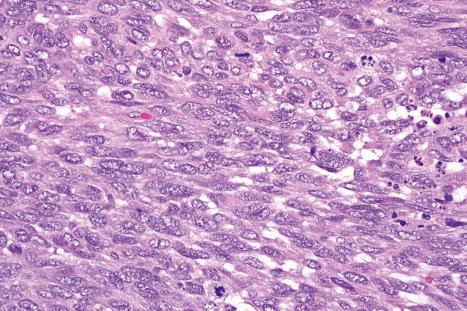
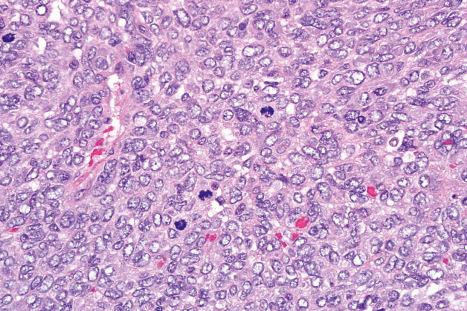
Ultrastructural studies show cells with features of fibroblasts.
Infantile myofibroma may contain focal areas resembling infantile fibrosarcoma. Careful attention should be paid in such cases to identify areas typical of myofibromatosis. Cytogenetic analysis may also be of help.
Superficial CD34-positive fibroblastic tumor is a rare neoplasm of intermediate malignancy (locally aggressive) described in 2014 in a series of 18 cases. Since then, another series of 11 cases and isolated cases reports have been published. It presents in adults with a slight predilection for males. A suprafacial long-standing mass, usually in the lower limb, is the typical clinical presentation. Local recurrence has not been reported, but in one case there was metastatic spread to a regional lymph node. Complete surgical excision is the treatment of choice. Cases successfully treated with Mohs micrographic surgery have been reported.
Rearrangements of the TGFBR3 and MGEA5 genes have not been found.
Histologically, tumors are fairly circumscribed, cellular, and composed of pleomorphic spindle to epithelioid cells arranged in fascicles and sheets ( Figs 35.181 and 35.182 ). In contrast to the degree of pleomorphism, mitotic activity is low. Tumor cells may be large with abundant granular, fibrillary xanthomatous or glassy cytoplasm; intranuclear and cytoplasmic inclusions are sometimes found. Focal granular cell change is frequent ( Fig. 35.183 ). Arborizing vessels and a mixed inflammatory infiltrate are common features.
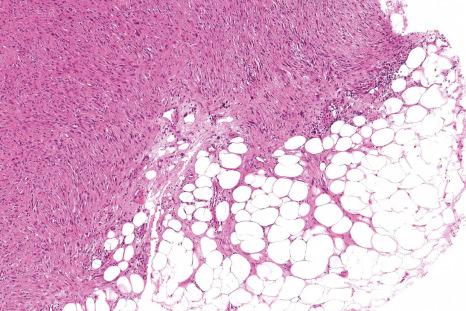
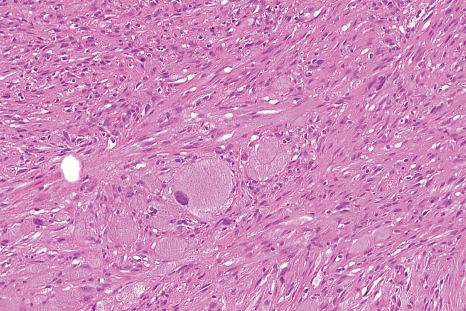
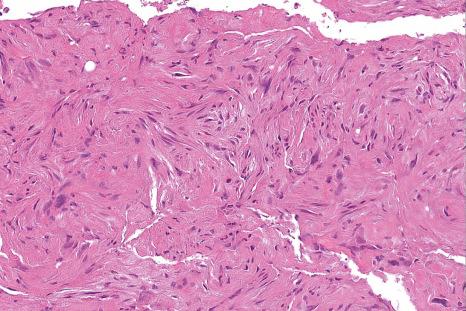
Immunohistochemically, tumor cells are diffusely positive for CD34; focal staining for cytokeratin is seen in most cases. FLI-1, ERG, S100 protein, desmin, and smooth muscle actin are negative. There is no overexpression of TP53 and SMARCB1 is retained.
The combination of pleomorphic histology with very low mitotic index and diffuse CD43 expression in a superficial location is fairly distinctive. The main differential diagnosis is with myxoinflammatory fibroblastic sarcoma. In myxoinflammatory fibroblastic sarcoma, inflammatory cells are prominent, a number of cells display virocyte-like nuclear inclusions, and expression of CD34 is more focal. Cytogenetics studies may be of help in difficult cases (see also myxoinflammatory fibroblastic sarcoma ).
Contrary to age-old teaching, adult fibrosarcoma is now regarded as distinctly uncommon. With the aid of improved diagnostic techniques, many previous cases of fibrosarcoma would now be reclassified, most often as monophasic synovial sarcoma, solitary fibrous tumor or malignant peripheral nerve sheath tumor. True fibrosarcoma accounted for less than 1% of sarcomas among 100 000 adult sarcoma patients studied.
Adult fibrosarcoma usually arises in the fifth and sixth decades, and shows a slight male predominance. It occurs most often in the lower limbs, followed by the upper limbs and trunk. Tumors presenting in children are classified separately (see below). Fibrosarcoma is most often deep seated and asymptomatic. Only very occasional tumors are subcutaneous. There is a tendency for local recurrence and metastasis, with a 5-year survival of about 50%.
A small proportion of adult tumors have been reported to be radiation induced but it is not clear whether all of these tumors represent true fibrosarcomas.
Cytogenetic studies in a small number of fibrosarcomas have shown complex chromosomal abnormalities. In two cases, tri- or tetrasomy of 2q has been described.
Adult fibrosarcoma tends to be well circumscribed and is composed of relatively uniform spindled cells with little cytoplasm, typically arranged in a herring-bone pattern ( Figs 35.184 and 35.185 ). There is usually minimal collagen production, mild pleomorphism can be present and the mitotic count varies. It is important to remember that tumors such as dermatofibrosarcoma protuberans and dedifferentiated liposarcoma may have areas identical to fibrosarcoma.
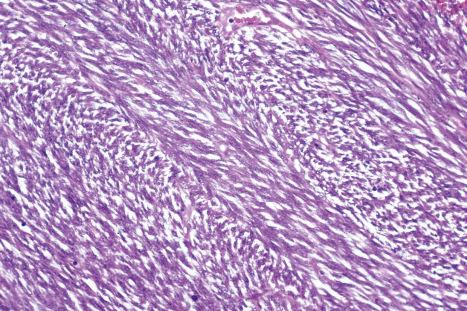
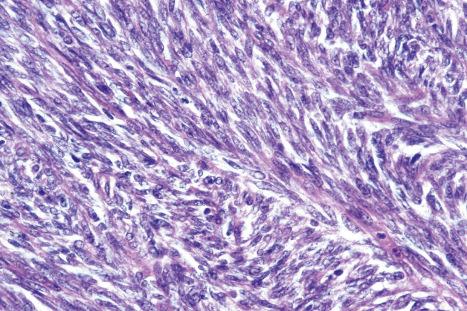
Immunohistochemistry shows that tumor cells are positive for vimentin and are occasionally focally positive for actin. Other markers including CD34, S100 protein, EMA and desmin are negative.
Ultrastructural studies show cells with features of fibroblasts and myofibroblasts.
All cases should be assessed for S100 protein, pankeratin and EMA expression to exclude malignant schwannoma and monophasic synovial sarcoma since the diagnosis of fibrosarcoma is one of exclusion. Leiomyosarcoma is composed of plumper spindle-shaped cells with abundant eosinophilic cytoplasm and cigar-shaped nuclei. Tumor cells are usually positive for desmin and staining for actin is more widespread than that seen in fibrosarcoma.
Sclerosing epithelioid fibrosarcoma is a very rare distinctive variant of fibrosarcoma. It involves deep soft tissues of the lower limbs/limb girdles followed by the trunk and upper limbs and rarely the head and neck (including the salivary gland and mouth) and bone. Rare tumors can occur in the liver, colon, kidney, intra-abdominal soft tissues, pituitary gland, and skull. One tumor developed after radiotherapy. Patients are middle-aged adults and present with a variably painful mass. There is no sex predilection. There is a high recurrence rate of up to 50% and metastatic disease occurs in up to 40% of cases.
Recently, this tumor has been described in combination with low-grade fibromyxoid sarcoma (see below) with demonstration of the characteristic t(7;16)(q33;p11) in these mixed cases. However, FUS rearrangements are uncommon in pure epithelioid fibrosarcoma, casting some doubt on the pathogenetic relationship between these two tumors in their pure, unmixed forms. Recent reports suggest that EWSR1-CREB3L1 rearrangements are predominant over FUS and CREB3L2 rearrangements in pure sclerosing epithelioid fibrosarcoma. In contrast, hybrid lesions recapitulate the genotype of low grade fibromyxoid sarcoma (most commonly, FUS-CREB3L2 fusion).
The tumor is characterized by prominent hyalinization and relatively uniform, small, round or ovoid epithelioid cells with sparse and often clear cytoplasm arranged in cords and nests ( Figs 35.186 and 35.187 ). Areas of typical fibrosarcoma may be seen. Focal calcification and bone formation are features that are sometimes present.
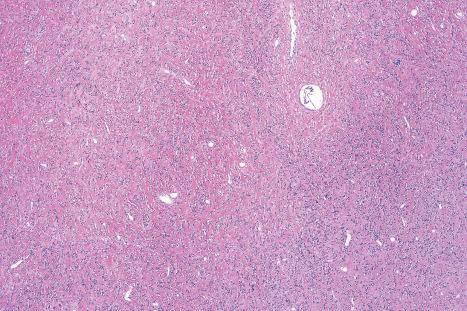
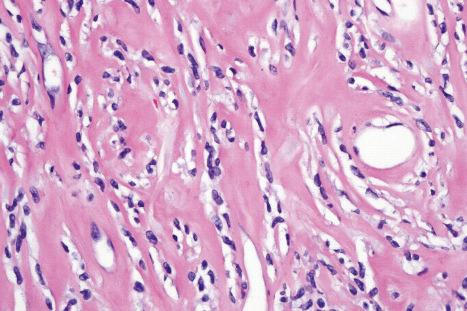
Tumor cells are generally positive for vimentin and beta-catenin. MUC4 is positive in the majority of cases; MUC4-positive cases are reported to be associated with a FUS gene rearrangement. Some show focal positivity for EMA, S100 protein and more infrequently for neuron-specific enolase (NSE). Rare tumors focally express keratin.
Low-grade fibromyxoid sarcoma is a rare distinctive tumor which belongs within the spectrum of hyalinizing spindle cell tumor with giant rosettes. It presents mainly in young adults or less commonly younger patients, including children as a slowly growing, asymptomatic large mass with a predilection for the limbs. Most lesions are deep seated, may be intramuscular and some tumors are subcutaneous. Superficial lesions tend to be more common in children. Unusual sites include intracranial, intrathoracic, mesenteric, omental, the ovary, the lung, the colon, the external anal sphincter and the falciform ligament. Although the rates of local recurrence, metastasis and death were high in the first published series, a subsequent large series reported the rates of local recurrence, metastasis and death as 9%, 6%, and 2%, respectively. Local recurrence and metastases may occur many years after excision of the primary tumor. Cases associated with radiotherapy have been reported.
The vast majority of cases are associated with t(7;16)(q33;p11) fusing CREB3L2 and FUS ; the former can be substituted by t(11;16)(p11;p11) with FUS-CREB3L1 fusion. CREB3L1 (11p11) is seen in a small subset of cases. In some examples the fusion results in a supernumerary ring and these tumors appear to recur more frequently.
Histology shows an infiltrative tumor with characteristic alternating myxoid and collagenous areas ( Figs 35.188 and 35.189 ). Cellularity is not prominent and tumor cells tend to predominate in the myxoid areas. Bundles of bland, elongated spindle-shaped cells with focal whorling are seen. Small blood vessels with surrounding fibrosis are often present and tumor cells may concentrate around vascular channels. Cytologic atypia is minimal and mitotic figures are very rare. In some cases, there is transition to areas with tumor cells that are focally epithelioid surrounding prominently hyalinized collagen with formation of giant rosettes ( Figs 35.190 and 35.191 ). The latter neoplasm was previously considered a distinct entity termed hyalinizing spindle cell tumor with giant rosettes. Rare cases contain focal areas resembling an ordinary fibrosarcoma or sclerosing epithelioid fibrosarcoma; it is still debated if the latter is related to low-grade fibromyxoid sarcoma (see also above). Recurrences may exhibit nuclear pleomorphism. A pediatric case mimicking ossifying fibromyxoid tumor has been documented.
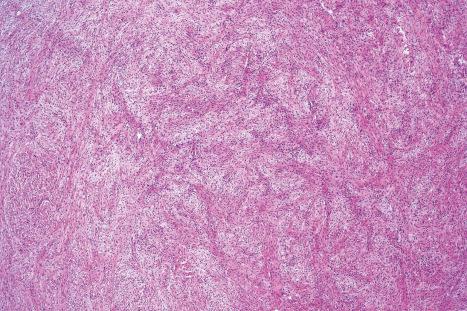
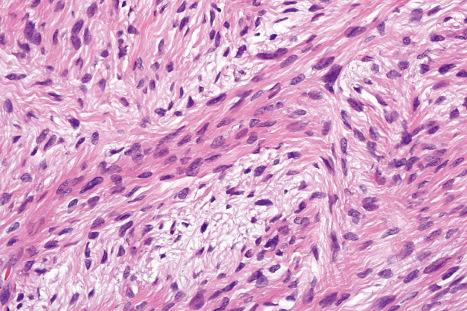
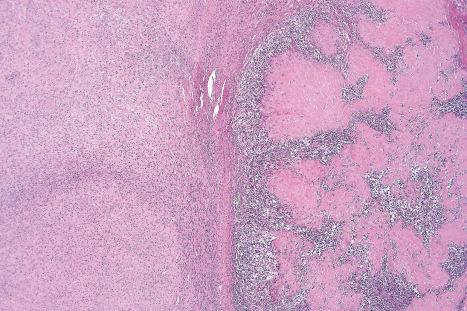
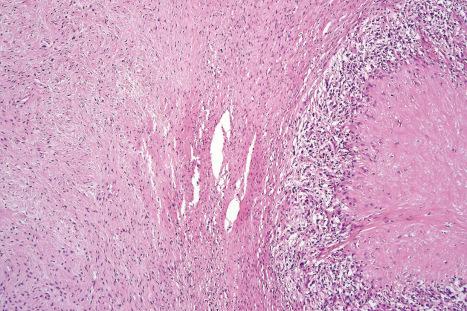
Immunohistochemistry shows staining for vimentin and very focal positivity for SMA and EMA. Claudin 1 is also often positive and this, coupled with positivity for EMA, may lead to a misdiagnosis of perineurioma. However, Glut-1 tends to be positive in perineurioma and negative in low-grade fibromyxoid sarcoma. MUC4 is a highly sensitive and specific marker of low-grade fibromyxoid sarcoma. Ultrastructural studies show cells with features of fibroblasts.
Distinction from myxofibrosarcoma is based on the presence of curvilinear blood vessels and at least focal prominent cytologic atypia with mitotic activity in the latter tumor. Tumor cells in neurofibroma are wavier and myxoid, and collagenous areas do not alternate, but focal collagen deposition is seen between tumor cells. Furthermore, tumor cells in neurofibroma are S100 protein positive. In addition, none of the benign or malignant mimickers, with the exception of sclerosing epithelioid fibrosarcoma, is positive for MUC4.
Myxofibrosarcoma, formerly known as myxoid malignant fibrous histiocytoma is currently defined as a malignant fibroblastic tumor with pleomorphism, myxoid stroma and a distinctive curvilinear vascular pattern. The tumor commonly presents in the limbs of the elderly and shows a slight predilection for males. Up to 60% of cases arise in the subcutis and secondary involvement of the skin is common ( Fig. 35.192 ). Prognosis is related to histologic grading, but behavior tends to be indolent with a high tendency for local recurrence, occasional metastasis to regional lymph nodes and a 5-year survival of up to 70%. Metastases are seen more commonly in deep-seated lesions and those with a high histologic grade. Local recurrences appear to be associated with higher histologic grade and more complex cytogenetic abnormalities, surgical margins (close or involved) and old age. Mortality is associated with tumor necrosis, large size and decrease in myxoid areas.
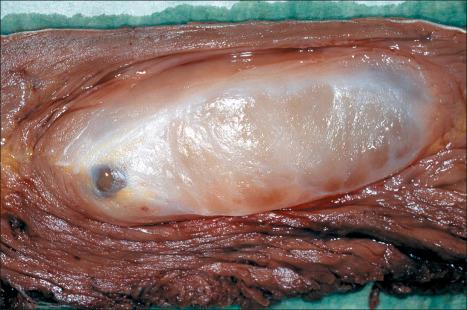
Karyotypes are highly complex and no recurrent genetic changes have been established. In addition, correlation of molecular events with malignant potential has been studied in some series. Gains at chromosome 7 have been described, and more recently, overexpression of MET (chromosome 7q31) have been reported in myxofibrosarcoma and this feature is associated with deeper, higher-grade tumors in more advanced stages. A recent studies demonstrated mutations in TP53 , ATRX , PTEN , FGFR3 , CDKN2A , and RB1 . MET is a transmembrane receptor tyrosine kinase representing the only high-affinity receptor of hepatocyte growth factor (HGF). Ezrin, as protein associated with cell adhesion-mediated signaling, is over-expressed in myxofibrosarcoma and the expression correlates with poor prognostic factors including necrosis, high mitotic activity, high histologic grade and advanced stage. Association of aggressiveness with down-regulation of p12CDK2AP1 has been reported. Of interest, chondroitin sulfate synthase 1 expression has been reported as associated with malignant potential in soft tissue sarcomas with myxoid substance. Domain-containing protein 2 (DCBLD2) is highly expressed in infiltrative myxofibrosarcoma.
Histologically, appearances vary from low-grade, markedly myxoid, hypocellular lesions, to highly cellular, pleomorphic tumors with focal myxoid change. Tumor cells range from stellate to spindle shaped with variable pleomorphism. All tumors share a multinodular growth pattern, curvilinear thin-walled blood vessels, and a minimum of 10–20% of myxoid stroma with hyperchromatic stellate or spindle-shaped cells ( Figs 35.193–35.198 ). Epithelioid cell change can be prominent, particularly in high-grade tumors.
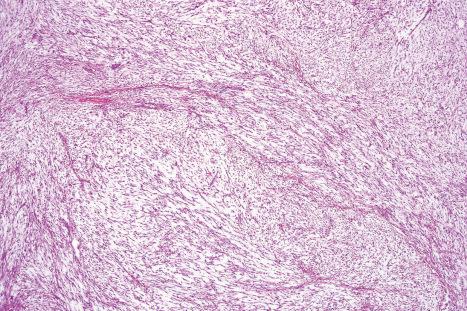
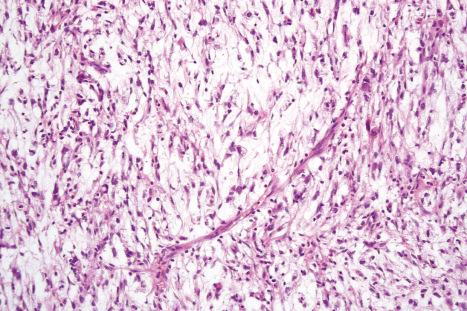
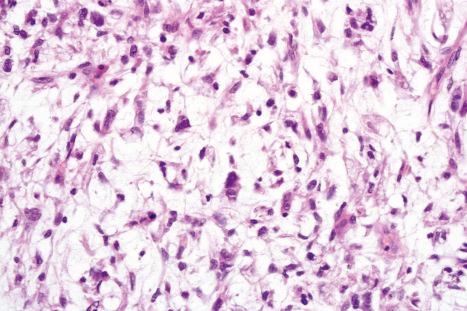
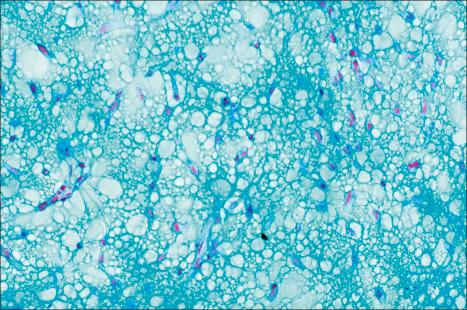
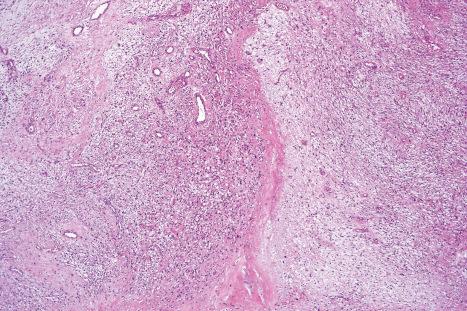
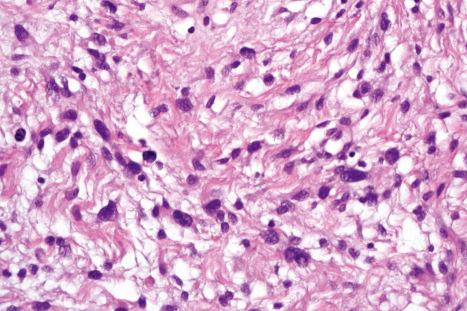
Tumor cells have ultrastructural features of fibroblasts and myofibroblasts and are only rarely focally for actin.
Distinction from superficial angiomyxoma is easy because the latter lacks cytologic atypia, is less cellular, is predominantly dermal and commonly has an epithelial component. Rare tumors can show focal changes mimicking a pleomorphic hyalinizing angiectatic tumor and sampling is very important to avoid a misdiagnosis. In low-grade fibromyxoid sarcoma, there is no pleomorphism, mitotic figures are rare and curvilinear blood vessels are usually absent. Immunohistochemical markers that have been reported to be of value in differential diagnosis from other myxoid soft tissue tumors include Claudin 6 and NY-ESO-1. The former is expressed in myxofibrosarcoma and the latter is expressed in myxoid/round cell liposarcoma but not in myxofibrosarcoma.
A group of heterogeneous soft tissue tumors, many of which probably have little in common, is traditionally included under this heading. The term ‘fibrohistiocytic’ is essentially descriptive and refers to a light microscopic morphological resemblance of tumor cells to fibroblasts and histiocytes; it does not appear to have any relationship to line of differentiation or histogenesis. However, the term is retained in this chapter due to its widespread general use and because most tumors in this category are of uncertain histogenesis.
Fibrous papule is a very common lesion that presents on the face of middle-aged adults, with predilection for the nose. It is usually skin-colored, asymptomatic and measures a few millimeters. Lesions with similar features occur in the tongue and are referred to as solitary oral fibromas. A basal cell carcinoma arising within a fibrous papule of granular cell type has been reported.
Although in the past it was suggested that fibrous papule represents an old fibrosed nevus, several studies have demonstrated that this is not the case. Mast cells may have a role in the development of fibrous papule. A recent study showed activation of the Mammalian Target of Rapamycin Pathway, similar to tuberous sclerosis complex-associated angiofibroma.
Histologically, the lesion is slightly raised, well circumscribed and located in the superficial dermis. It is composed of a collagenous stroma with increased vascular channels and scattered cells varying from spindle shaped to multinucleated ( Figs 35.199 and 35.200 ). A case with multinucleated ganglion-like cells has been reported. Mitotic figures are exceptional and some of the cells may show hyperchromatism. Variants with granular cell change, clear cell change and epithelioid cells have been described. Focal pigmentation and inflammation may be seen. Lesions with scattered pleomorphic cells overlap with pleomorphic fibroma. The overlying epidermis appears normal or slightly flattened.
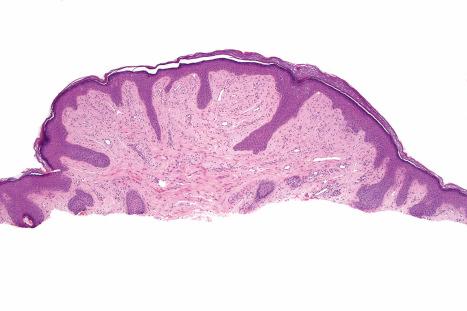
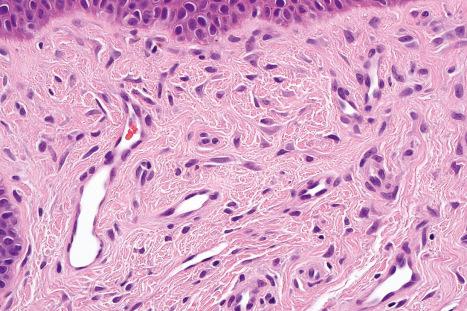
By immunohistochemistry, the cells in the lesion are positive for factor XIIIa and may also be positive for CD34. S100 protein is negative. Lesions with clear cells are positive for NKI/C3.
Ultrastructurally, the cells have features of fibroblasts.
Multinucleate cell angiohistiocytoma is a distinctive condition characterized by multiple, localized, angiomatous papules with predilection for the upper and lower limbs of middle-aged women ( Figs 35.201–35.203 ). The thigh and dorsum of the hands are frequent sites of involvement followed by face. Generalized lesions are very rare. A case developing during pregnancy has been reported.
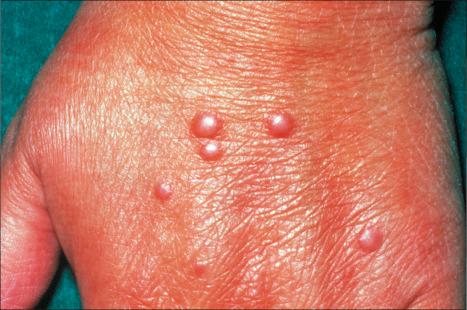
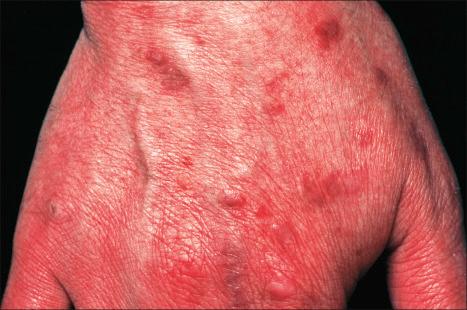
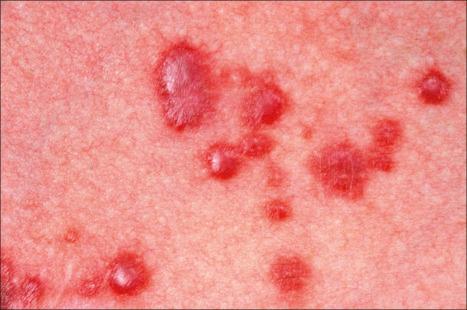
The lesions are asymptomatic and do not tend to regress spontaneously. A case has been reported in the oral cavity another in vagina and a further lesion occurred in association with an iatrogenic arteriovenous fistula. Dermoscopic features may be reminiscent of dermatofibroma.
The pathogenesis is unknown but the lesions are much more common in females and the tumor cells express estrogen receptor alpha, suggesting a possible hormonal etiological role. It is not clear whether it is a reactive or neoplastic condition.
The epidermis appears unremarkable. In the superficial and mid dermis there is a proliferation of small, thin-walled vascular channels, each of which is surrounded by a layer of pericytes ( Fig. 35.204 ). The surrounding dermis contains scattered multinucleate cells with angulated cytoplasm and a background of somewhat hyalinized collagen bundles ( Figs 35.205 and 35.206 ). Occasional lymphocytes are also seen. An exceptional case with enlarged dermal nerves has been identified. Hemosiderin deposition may be present.
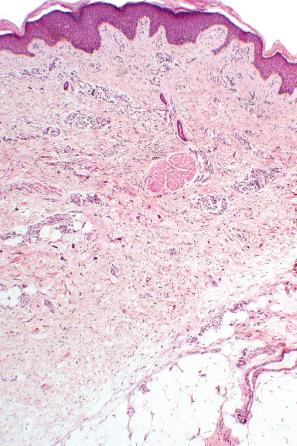
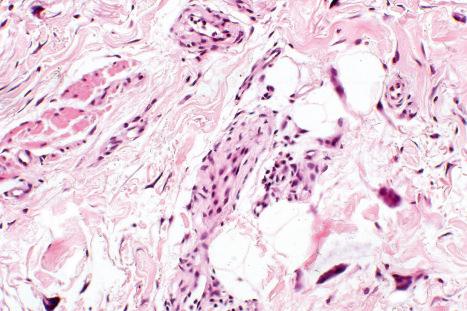
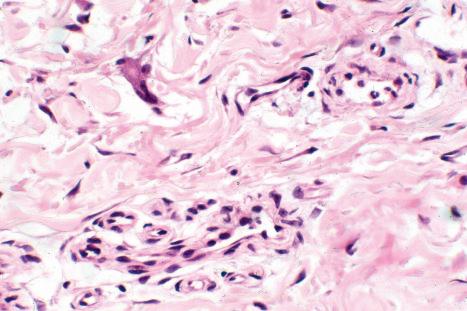
The multinucleate cells are positive for CD68 and lysozyme while the interstitial cells may be positive for factor XIIIa.
An atrophic dermatofibroma can look remarkably similar to multinucleate angiohistiocytoma; however, the former presents as a single lesion. Distinction from Kaposi sarcoma is based on the presence of irregular, jagged, thin-walled vascular channels, absence of multinucleate giant cells and presence of plasma cells. Multinucleate angiohistiocytoma lacks HHV8 on immunohistochemistry.
Fibrous histiocytoma (dermatofibroma, sclerosing hemangioma, histiocytoma cutis, nodular subepidermal fibrosis) represents one of the most common benign cutaneous soft tissue tumors. Over the years a number of variants have been described, and although they essentially highlight specific histologic features that can cause diagnostic confusion, some of them also correlate with characteristic clinical findings and behavior (see below). However, it must be emphasized that the histologic features of several variants can coexist in the same lesion.
Fibrous histiocytoma occurs most often in the middle aged and shows a slight female predominance. The majority of lesions are located on the limbs or (to a lesser degree) the trunk, and present as small, raised, hyperkeratotic cutaneous nodules usually less than 1 cm in diameter with a reddish-brown surface ( Figs 35.207 and 35.208 ). Giant variants including a plaque-like variant are very rare. .
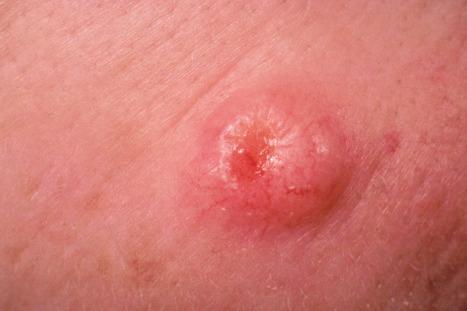
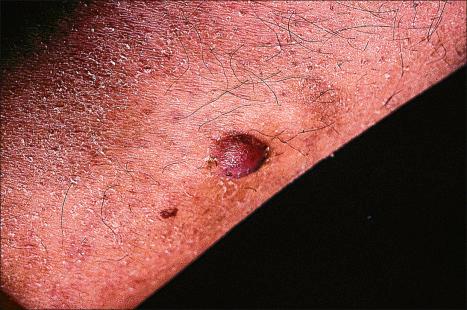
A significant proportion of cases are said to be associated with previous minor local trauma, especially insect bites. They are slow growing and painless, and may sometimes be multiple. Eruptive lesions have been documented in the context of immunosuppression, HIV infection and highly active antiretroviral therapy (HAART).
Simple excision is usually curative and local recurrence is exceptional except for some of the variants (see below) and in lesions occurring on the face, where the reported rate of local recurrence is 20%. In some variants (e.g., atypical, aneurysmal, and cellular fibrous histiocytoma) and exceptional classic tumors, rare metastases have been reported.
A small subgroup of these lesions originates in subcutaneous fat or in deeper structures (deep benign fibrous histiocytoma).
Most fibrous histiocytomas show a typical dermoscopy pattern (peripheral delicate pigment network and a central white scar-like patch) but atypical patterns may mimic melanoma, vascular tumors, basal cell carcinoma, a collision tumor and even psoriasis.
For years, it was suggested that dermatofibroma represents a reactive process. Possible etiological associations included insect bites and even trauma such as body-piercing. In later years it has become clear that the lesion represents a neoplastic process. Clinical evidence supporting the latter includes the following: tumors do not tend to regress spontaneously, in some variants there is variable potential for local recurrence, and a small number of cases have metastasized. Cytogenetic analysis has provided further support to this theory. Clonality has been demonstrated in some examples of cellular fibrous histiocytoma. More recently, further studies have demonstrated genetic aberrations by FISH analysis and RNA sequencing in rare examples of subsets of cutaneous fibrous histiocytoma (cellular and aneurysmal) and very exceptionally in regular lesions and deep fibrous histiocytoma. Rearrangements of the protein kinase C genes ( PRKCB and PRKCD ) are seen in regular, epithelioid, cellular, and aneurysmal fibrous histiocytoma, and ALK rearrangements are only seen in the epithelioid variant. 7 Rearrangements of PRKC and ALK are mutually exclusive events; overexpression of these genes drives promoter swapping with a considerable variety of other gene fusion partners including LAMTOR1, PDPN and CD63 . In another study, DNA copy number changes by comparative genomic hybridization were detected in metastatic tumors and rare cases of nonmetastatic atypical and cellular variants. The chromosomal aberrations were higher in metastatic cases resulting in death. With regards to aneurysmal fibrous histiocytoma, a translocation t(12;19)(p12;q13) was described and a pathogenetic role for LAMTOR1-PRKCD and NUMA1-SFMBT1 has been suggested.
The common variant is an ill-defined dermal lesion that may extend into superficial subcutaneous fat ( Figs 35.209–35.213 ). It is largely composed of interlacing fascicles of slender spindled cells, sometimes in a focal storiform arrangement, set within a loose collagenous or (less often) myxoid stroma. Scattered between the spindled cells are foamy histiocytes, multinucleated giant cells and thin-walled blood vessels ( Figs 35.214–35.217 ). Foci of chronic inflammatory cells, including lymphocytes and plasma cells, and hemosiderin deposition are frequently seen. A typical feature is the presence of individual hyaline collagen bundles surrounded by tumor cells in the periphery of the lesions.
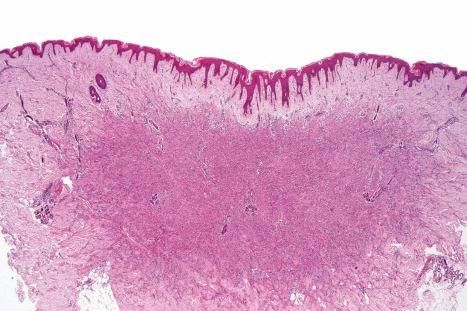
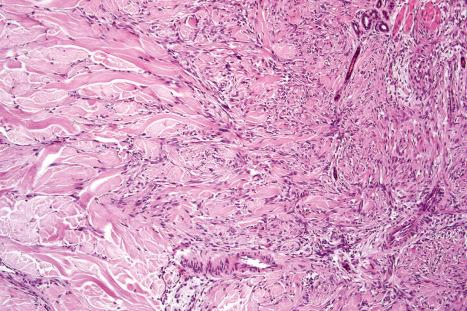
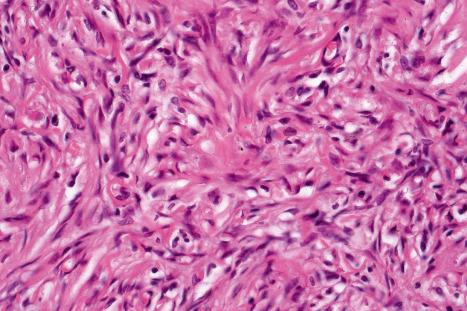
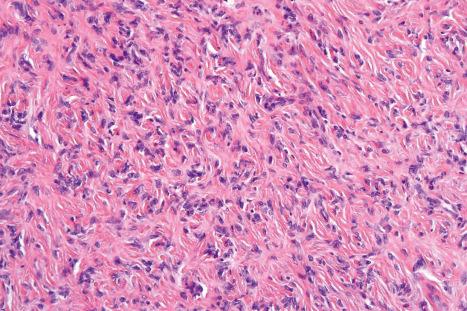
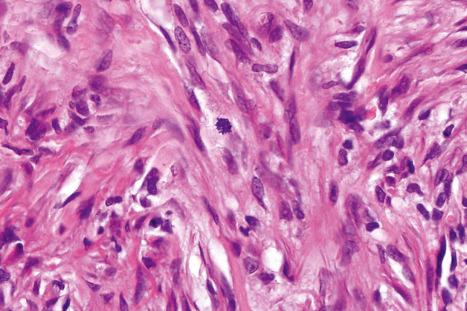
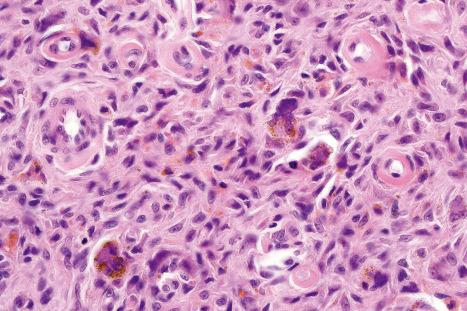
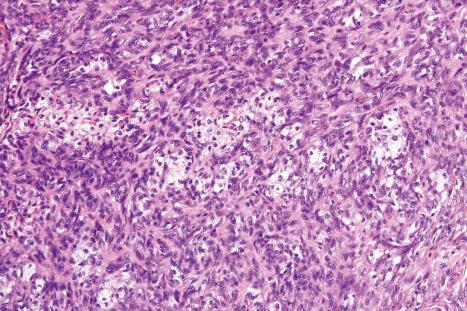
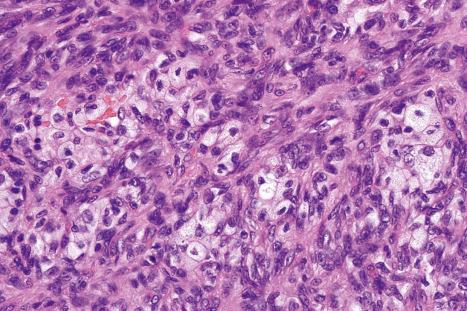
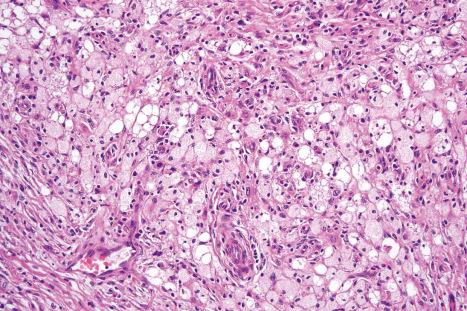
Long-standing lesions show progressive hyalinization and decreased cellularity and are usually referred to as sclerosing or atrophic dermatofibroma.
All of these tumors, including the variants, may be associated with acanthosis or even pseudoepitheliomatous hyperplasia of the overlying epidermis and hyperpigmentation of the basal cell layer ( Figs 35.218 and 35.219 ). It has been suggested that epidermal growth factor may play a role in the pathogenesis of the epidermal hyperplasia. A grenz zone of papillary dermal sparing is usually present ( Fig. 35.220 ). Changes simulating seborrheic keratosis are common, followed by proliferation of clear cells mimicking a clear cell acanthoma, and proliferation of immature hair follicle-like structures closely resembling a trichoblastoma, and induction of sebaceous glands sometimes in a reticulate pattern ( Fig. 35.221 ) Mature hair follicles are rarely induced and more unusual epidermal changes including, epidermolytic hyperkeratosis, focal acantholysis and even Bowen disease, have also been described. Most cases reported as basal cell carcinoma overlying dermatofibroma actually represent reactive induction of immature follicular structures rather than collision tumors.
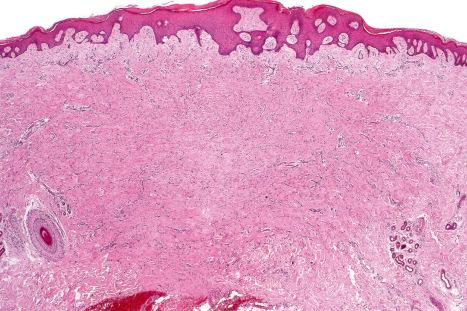
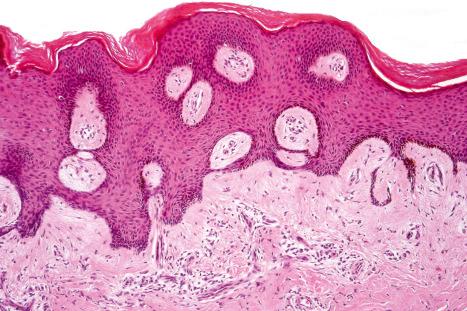
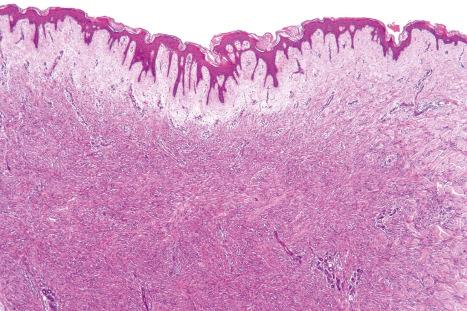
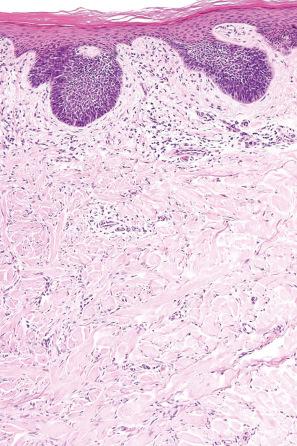
A proportion of tumors, especially the cellular variant, stain focally for α-SMA and calponin, suggesting myofibroblastic differentiation ( Fig. 35.222 ). It has been proposed that this lesion arises from a fixed dermal connective tissue cell, the dermal dendrocyte, which stains positively for factor XIIIa. Although a number of cells within fibrous histiocytomas react with this marker, especially towards the edges of the lesion, these appear to be reactive cells and not true tumor cells. In contrast to dermatofibrosarcoma, CD34 expression is not usually a feature except in the cellular variant of fibrous histiocytoma where focal positivity for this marker may be seen (see below). D2–40 is diffusely positive in dermatofibromas and only very focally positive or negative in dermatofibrosarcoma protuberans.
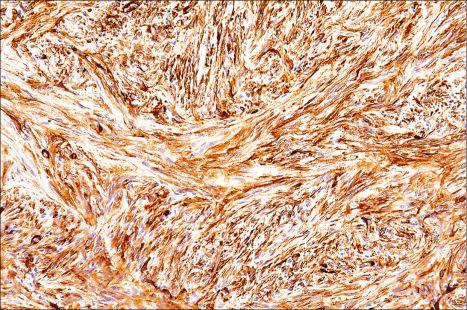
Common dermatofibroma is usually easy to diagnose and problems with differential diagnosis generally only arise with its variants.
Variants of dermatofibroma include:
cellular fibrous histiocytoma,
aneurysmal fibrous histiocytoma,
epithelioid fibrous histiocytoma,
atypical (pseudosarcomatous) fibrous histiocytoma,
lipidized (‘ankle-type’) fibrous histiocytoma,
clear cell fibrous histiocytoma,
palisading cutaneous fibrous histiocytoma,
atrophic dermatofibroma.
It is important to note that all variants of dermatofibroma except the epithelioid variant may overlap histologically.
Cellular benign fibrous histiocytoma accounts for almost 5% of cutaneous fibrous histiocytomas. It is most common in young adults, especially males, and has a predilection for the limbs and head and neck area ( Figs 35.223 and 35.224 ). These lesions are larger than common fibrous histiocytoma and have a high recurrence rate of up to 26%. Metastasis to regional lymph nodes, soft tissues and lungs has been reported in a small number of cases. Development of satellite nodules has also been described. In a further case, erosion of the phalanx occurred. Histologic features do not allow prediction of those cases that ultimately metastasize. Cases that may be more likely to metastasize appear to be those that recur early and on multiple occasions.
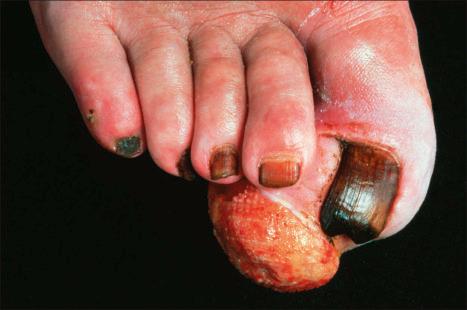
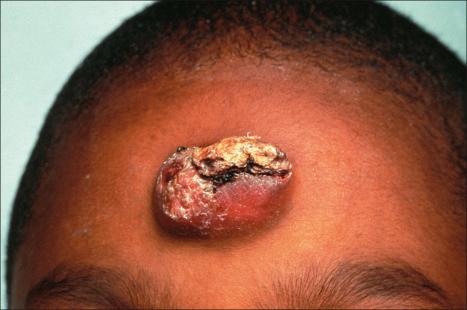
Histologically, lesions are highly cellular with a more prominent fascicular growth pattern ( Figs 35.225–35.228 ). Frequently there is involvement of the superficial subcutis. Tumor cells tend to have more abundant eosinophilic cytoplasm, and normal mitotic figures are common ( Fig. 35.229 ). Central necrosis is seen in some cases (about 10%). A pleomorphic sarcoma component has been described in a case of primary cellular fibrous histiocytoma and in a recurrent tumor.
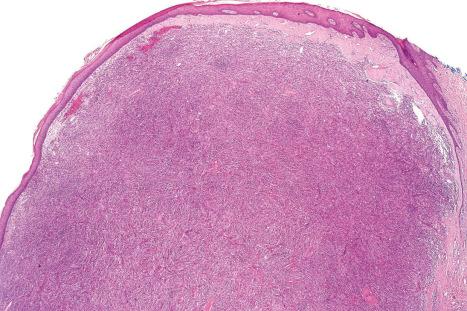
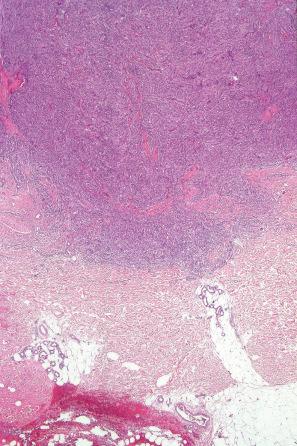
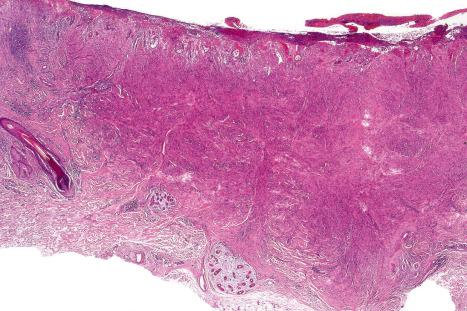
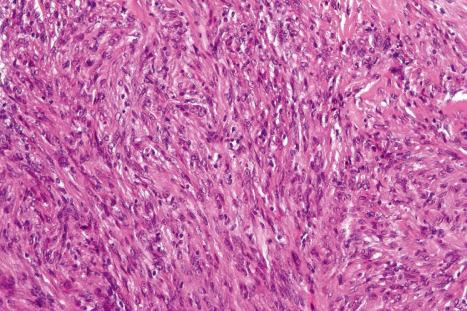
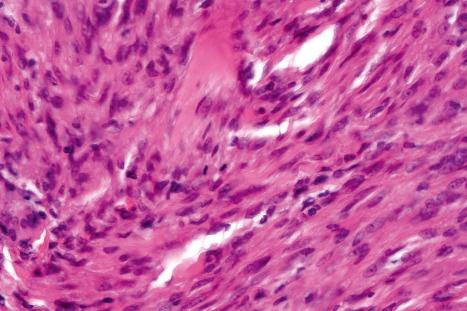
Immunohistochemistry shows variable (usually focal) staining for SMA (in most cases) and calponin and negative or only focal staining for CD34 ( Fig. 35.230 ). When the last is present, expression is limited to peripheral parts of the tumor. Focal desmin positivity may be seen in around a third of cases.
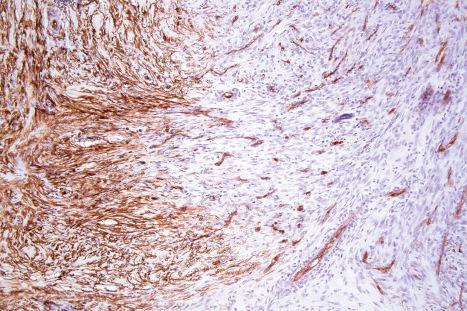
Distinction from leiomyosarcoma is possible by the presence in the latter of cells with cigar-shaped nuclei, at least focal cytologic atypia, a uniform fascicular growth pattern, diffuse positivity for SMA, desmin and H-caldesmon and frequent focal positivity for keratin. Dermatofibrosarcoma protuberans has a monotonous, storiform growth pattern, monomorphous cells and diffuse positivity for CD34.
Aneurysmal benign fibrous histiocytoma represents less than 2% of fibrous histiocytomas and presents as a blue–brown nodule on the limbs of middle-aged adults, especially females ( Fig. 35.231 ). Rapid growth can be seen due to extensive hemorrhage, and clinical confusion with a melanocytic or vascular tumor is common. The rate of recurrence is around 19%. Rare cases present with regional lymph node involvement.
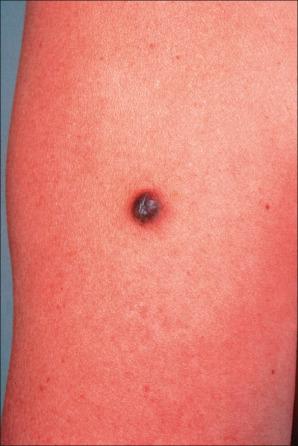
Histologically, the most striking feature is the presence (especially towards the center of the lesion) of hemorrhagic irregular cleft-like and cystic spaces mimicking cavernous vascular channels, but without endothelial lining ( Figs 35.232 and 35.233 ). Adjacent solid areas show the usual features of benign fibrous histiocytoma, but are often very cellular. Multifocal interstitial hemorrhage and intra- and extracellular hemosiderin deposition are prominent and normal mitotic figures are common ( Figs 35.234–35.236 ). Due to the extensive secondary changes this lesion is frequently diagnosed as a vascular tumor, but typical features of fibrous histiocytoma are always present and endothelial markers are only positive in normal blood vessels.
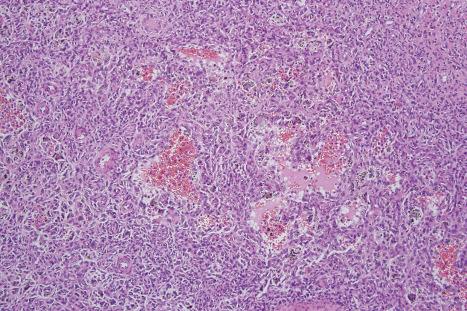
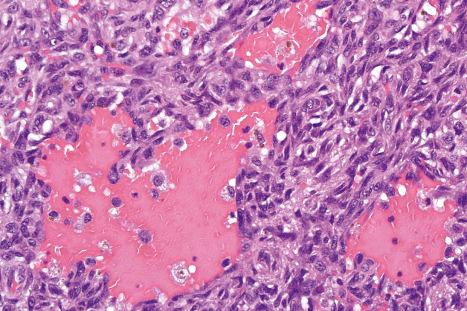
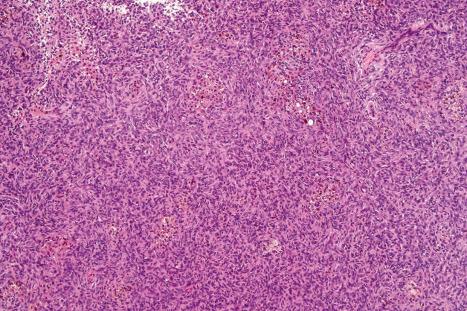
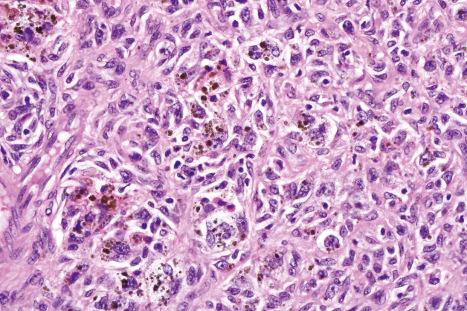
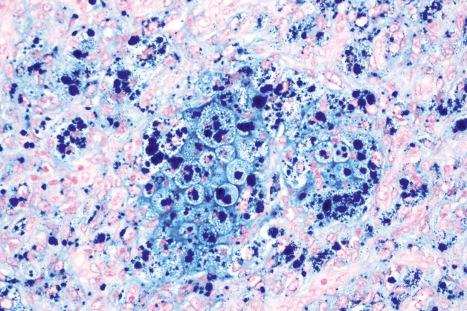
Aneurysmal fibrous histiocytoma should not be confused with angiomatoid fibrous histiocytoma, the latter being an unrelated neoplasm with EWSR1-CREB1 gene fusion. The latter is usually subcutaneous and is composed of monomorphic spindle-to-ovoid eosinophilic cells, which are usually desmin positive. A prominent lymphoplasmacytic infiltrate is commonly present. Some patients with the latter condition have striking systemic symptoms.
Hemosiderotic fibrous histiocytoma probably represents a stage in the development of aneurysmal fibrous histiocytoma.
Epithelioid fibrous histiocytoma is rare, has a wide age and anatomical distribution (with predilection for the proximal lower limb), and often presents as a polypoid red nodule, which is usually confused with a lobular capillary hemangioma (pyogenic granuloma) ( Fig. 35.237 ). Multiple lesions are exceptional and a lesion has been reported in the tongue. A case with metastatic spread has been described. Histologically, most tumors are superficial, but rare examples extend into the superficial subcutis. An epidermal collarette is often present and tumor cells are rounded with abundant eosinophilic cytoplasm and a vesicular nucleus with small eosinophilic nucleoli ( Figs 35.238–35.241 ). Binucleate or multinucleate cells are common. Rarely, cells may have granular cell change. Occasional normal mitotic figures may be evident. Some lesions are more myxoid and vascular. A rare variant of the tumor has been reported as chondroblastoma-like and consisting of pericellular calcification. Immunohistochemistry reveals a population of CD34 positive cells and a population of factor XIIIa-positive dendritic cells. Distinction from Spitz nevus is facilitated by the absence of a junctional component or nesting of tumor cells and negativity for S100 protein. Distinction from a cutaneous perineurioma with epithelioid cell change is made by the presence of diffuse EMA and claudin-1 positivity in the latter tumor. However, focal membranous EMA positivity is a frequent finding in epithelioid fibrous histiocytoma. ALK expression is typically seen (in roughly 90% of cases) and is correlated with ALK rearrangements with a variety of partner genes including SQSTM1, VCL, TMP3, EML4, PRKAR2A , and others ( Fig. 35.242 ) .
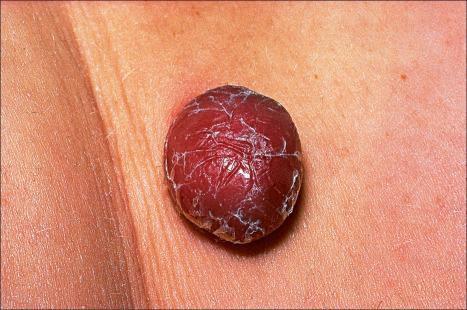
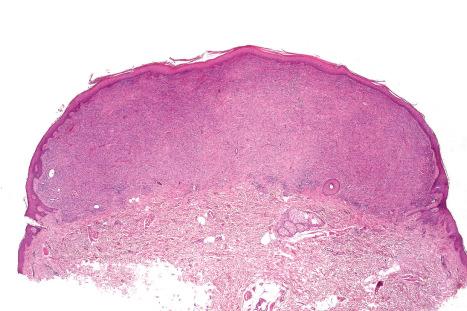
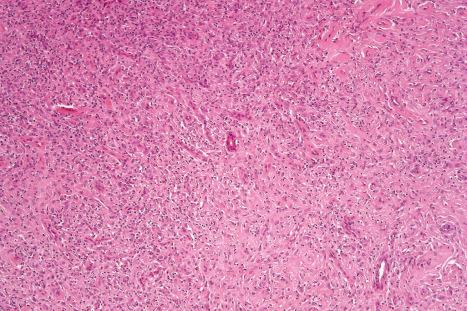
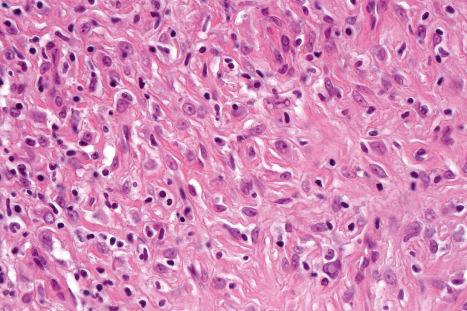
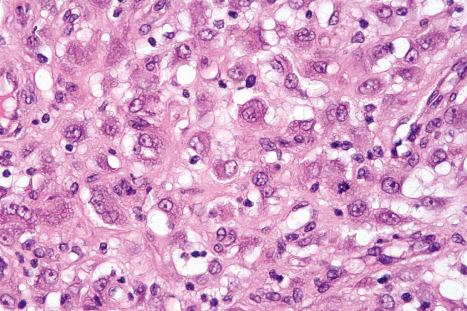
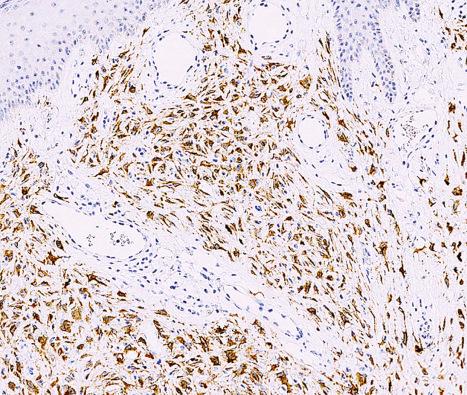
Atypical (pseudosarcomatous) fibrous histiocytoma is also known as dermatofibroma with monster cells. Clinically, it has a predilection for the limbs with some tumors occurring on the trunk and head and neck. Lesions are usually papular or nodular but may be polypoid, and rare tumors measure up to several centimeters. There is local recurrence in a minority of cases, and metastasis rarely occur with one patient dying as a result of systemic spread.
Histologically, the lesion is mainly dermal but extends into the superficial subcutis in one-third of cases. In some areas, the tumor shows the features of a more typical fibrous histiocytoma ( Fig. 35.243 ). However, a variable proportion of cells in the tumor have irregular, large and pleomorphic nuclei with prominent nucleoli ( Fig. 35.244 ). Pleomorphism may be marked. The mitotic rate varies and may be high in some cases. Atypical mitotic figures are sometimes seen. An unusual feature is that of focal necrosis. Histologic features do not allow prediction of the exceptional tumors that metastasize.
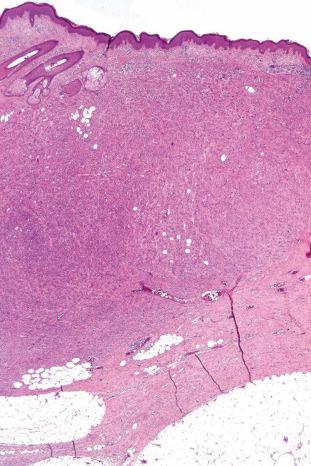
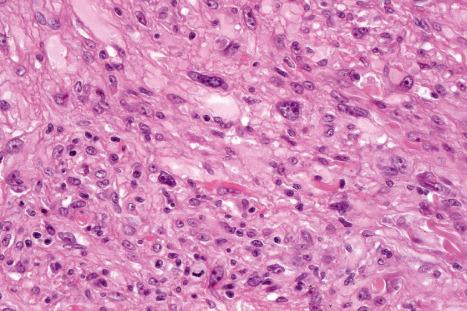
Atypical fibrous histiocytoma should not be confused with atypical fibroxanthoma. The latter occurs in a completely different clinical setting (see below) and shows diffuse pleomorphism, cytologic atypia and numerous mitoses throughout.
Lipidized (‘ankle-type’) fibrous histiocytoma presents as a polypoid yellow lesion on the lower leg. Histologically, there is a predominance of foamy histiocytes surrounded by abundant, almost keloidal, hyalinized collagen bundles ( Figs 35.245–35.247 ).
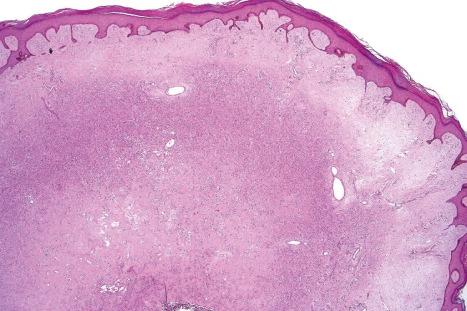
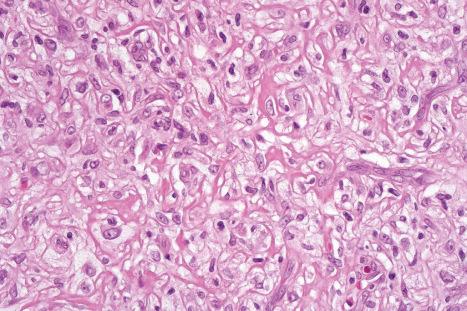
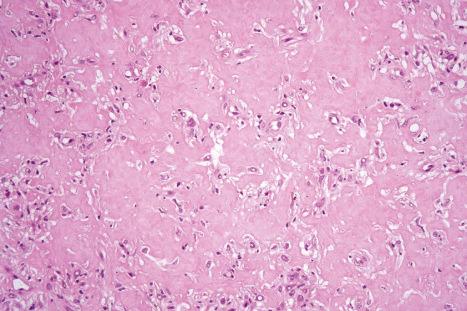
This is a very rare variant with no distinctive clinical features and with massive clear cell change throughout the lesion. The overall architecture and morphological features are not usually typical of a fibrous histiocytoma and thus may represent an altogether unrelated tumor. It is likely that tumors previously described as clear cell fibrous histiocytoma represent the entity reported as dermal clear cell mesenchymal neoplasm. Only a handful of cases of the latter entity have been described in adults with predilection for the lower limbs. Tumors consist of sheets of clear cells with vesicular nuclei that occupy the reticular dermis and may extend into the subcutaneous tissue. Cytologic atypia and mitotic figures are rare. Tumor cells are negative for most markers except vimentin, NKI/C3 and sometimes CD68. Behavior appears to be benign.
Palisading cutaneous fibrous histiocytoma refers to lesions that histologically show prominent nuclear palisading ( Figs 35.248 and 35.249 ). They appear to present most often on acral sites. Focally, there is a resemblance to schwannoma as the palisading mimics Verocay bodies. However, lesions are not encapsulated and tumor cells are S100 negative.
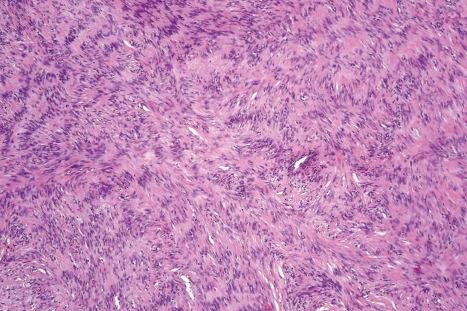
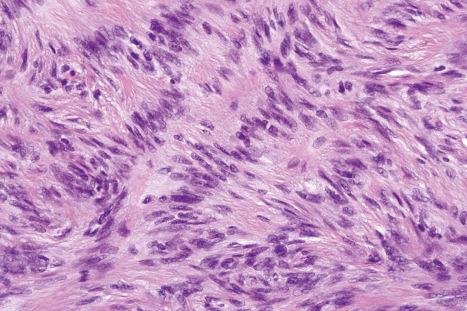
Atrophic dermatofibroma probably represents the end stage of many dermatofibromas and is characterized clinically by an area of depression or retraction, often resembling a scar or even anetoderma. Histologically, lesions are hypocellular and show prominent hyalinization of collagen ( Figs 35.250 and 35.251 ). The changes may resemble those seen in multinucleate angiohistiocytoma but the latter usually presents with multiple clinical lesions.
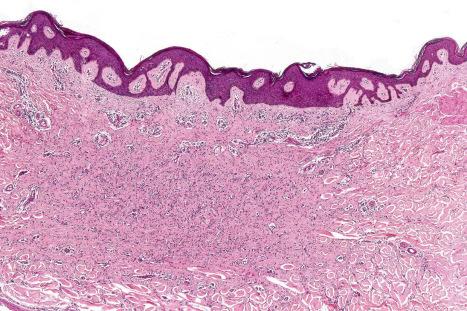
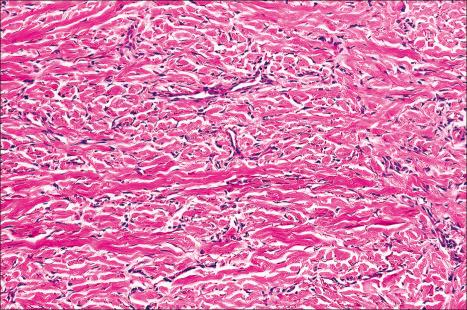
Very occasionally, tumors can show prominent osteoclast-like giant cells (occasionally with ossification), granular cell change, cholesterol deposition, focal smooth muscle proliferation, marked myxoid change, keloidal change, balloon cell change and signet-ring change. Tumors may also present with a lichenoid pattern and in a single case intracytoplasmic eosinophilic globules were described. Two cases of a tumor with scattered pigmented melanocytes, with CD34 positivity and overlapping histologic features between Bednar tumor and dermatofibroma have been reported. Unfortunately, no cytogenetic studies were performed in these cases. A further case of a melanoma overlying a dermatofibroma has been reported. Although inflammatory cells are a feature of most fibrous histiocytomas, formation of germinal centers is rare. Cases with an angiokeloidal pattern have also been described.
Cellular neurothekeoma usually presents on the head, neck and upper limbs followed by the trunk of children and young adults and shows predilection for females. Tumors in elderly patients are rare. Unusual sites of presentation include the maxilla, the bulbar conjunctiva, the oral cavity, the lip, the eyelid, hypopharynx, the ear and the vulva. Lesions are long-standing skin-colored papules, which usually measure less than 1 cm and in most cases less than 2 cm in diameter. Multiple lesions and eruptive cases are exceptional. A case in a patient with Guillain-Barre has been reported. Local recurrence is rare and the figure of around 7% reported in large series likely reflects a referral bias. Recurrent tumors are more common on the face. Some cases present with atypical features (see below), raising the possibility of malignancy. However, the behavior of these tumors is benign.
Hybrid tumors of perineurioma and cellular ‘neurothekeoma’ have been recently described (see below); the vast majority occur as a solitary papule on the lip.
Cellular neurothekeoma is no longer considered a tumor of neural lineage. Its origin remains obscure and although an association with plexiform fibrohistiocytic tumor has been proposed, this is not likely.
Lesions are poorly circumscribed and located in the reticular dermis with frequent focal extension into the subcutis. Atypical variants (see below) extend deeper into the subcutaneous tissue and an exceptional example with purely subcutaneous presentation has been documented. Facial tumors can focally involve the skeletal muscle. The tumor has a lobular growth pattern and consists of small nests and fascicles of epithelioid and short spindled cells with pale eosinophilic cytoplasm, vesicular nuclei and mild or no cytologic atypia ( Figs 35.252 and 35.253 ). More prominent cytologic atypia can be seen in up to 25% of cases. Normal mitotic figures are fairly common and in some cases are prominent, and in exceptional instances atypical mitotic figures are found ( Fig. 35.254 ). Multinucleated giant cells including osteoclast-like giant cells can be seen. The collagen around the tumor cells sometimes appears somewhat sclerotic. In some cases, the latter change is prominent and these lesions are regarded as desmoplastic. A predominantly plexiform pattern is very rare and in occasional cases larger lobules are identified. A fascicular and a sheet-like pattern is exceptional. Myxoid change is frequently observed and tends to be focal or more rarely predominant. Two rare tumors containing melanin have been documented.
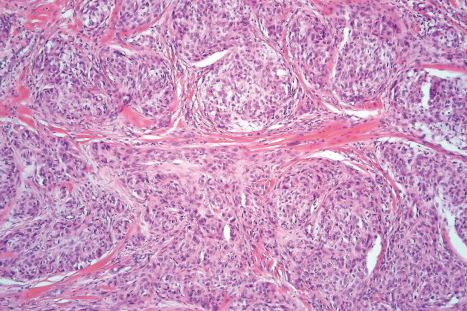
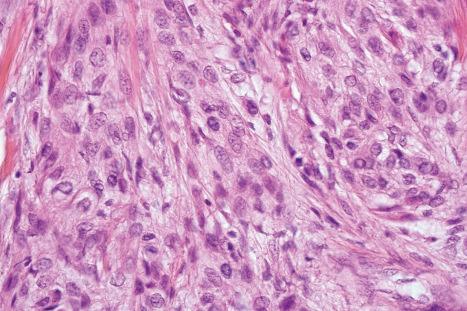
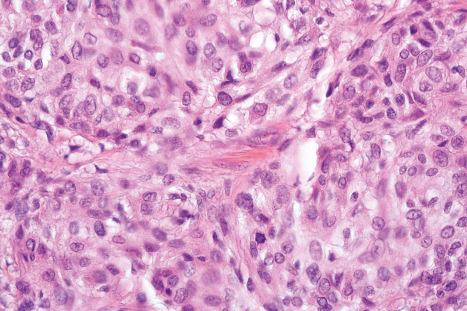
Atypical cellular neurothekeoma is characterized by larger size, deep involvement, infiltrative growth pattern, vascular invasion, perineural invasion, high mitotic rate and marked cytologic atypia ( Figs 35.255 and 35.256 ). Lymphocytic cuffing, xanthomatoid areas, a pseudonevoid appearance and chondroid stroma may be seen.28 A case with neuroendocrine differentiation has also been reported.
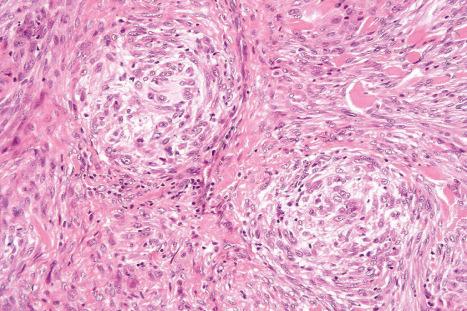
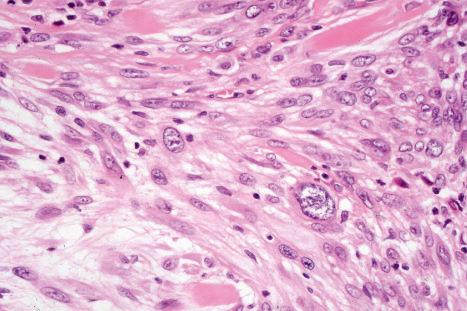
The histogenesis of this tumor remains enigmatic. It has been suggested that the line of differentiation is fibroblastic/myofibroblastic and that it may represent part of the spectrum of plexiform fibrous histiocytoma. Immunohistochemistry is quite distinctive, as cases are consistently S100 protein and SOX10 negative and NSE, NKI/C3 (described originally as a melanoma marker and a very non-specific marker) and CD10 positive ( Fig. 35.257 ). Although it has been reported that NKI/C3 tends to be negative in tumors in which spindle cells predominate this is not our personal experience. Although S100 protein is negative, S100A6 is positive in all reported cases. A proportion of cases are focally positive for SMA. PGP 9.5, microphthalmia transcription factor 1 (MITF-1) and podoplanin (D2–40) have also been reported as useful markers of cellular neurothekeoma. A single case was positive for desmin.
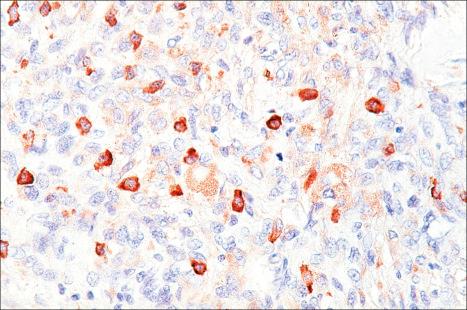
Hybrid tumors with features of perineurioma and cellular neurothekeoma are well-circumscribed, unencapsulated plexiform lesions composed of nests/nodules of tumor cells in a focally myxoid stroma. Individual tumor cells are arranged in whorls or in a lamellar pattern. By immunohistochemistry most cells are strongly immunoreactive for S100A6, MITF1, NKI/C3, PGP9.5, EMA, and NSE. In some cases, there is weaker and focal positivity for CD34, claudin-1, and Glut-1. A biphasic non-plexiform hybrid tumor has also been reported.
Although the overall growth pattern with nesting somewhat resembles a melanocytic lesion, there is no epidermal component and lesions are S100 protein, HMB-45 and Melan-A negative. Nerve sheath myxoma is a predominantly acral tumor lacking cellular areas and composed of myxoid lobules of stellate cells which are positive for S100 protein and negative for NKI/C3. MITF1 positivity may be of help when a plexiform fibrohistiocytic tumor is considered in the differential diagnosis. PG9.5 is not a helpful marker as it has very low specificity.
Deep benign fibrous histiocytoma is a rare tumor that presents most often between the fourth and fifth decades of life in the subcutis or deep soft tissues, with a predilection for males. It occurs mainly on the limbs followed by the head and neck and trunk. Rare cases present in the mediastinum, retroperitoneum and pelvis. Tumors are usually a few centimeters in diameter but larger tumors also occur. There is local recurrence in up to 22% of cases and two cases of metastatic lesions that resulted in death have been recorded. These tumors did not look histologically different from nonmetastasizing lesions.
The pathogenesis is unknown but these tumors are the deep counterpart of dermal fibrous histiocytoma (dermatofibroma). Cytogenetic studies of a single case demonstrated a t(16;17)(p13.3;q21.3). However, this change appears to be very rare as it was not demonstrated in a further six cases studied. Gene fusions involving protein kinase C ( PRKC ) genes have been described.
Histologically, tumors are very similar to those occurring in the dermis. They are well-circumscribed and polymorphic (although less so than cutaneous counterparts), with a mixture of histiocyte-like cells, spindle-shaped cells and rare multinucleated giant cells and foamy cells. A sprinkling of lymphocytes is common. Areas of hemorrhage and cystic change are frequent. More monomorphic tumors very similar to cellular fibrous histiocytoma are common. Atypical variants of the tumor are rarely seen and are also identical to more superficial tumors. Deep tumors have a more prominent storiform appearance. Mitotic activity may be seen and is usually no more than 5 per 10 HPFs. Up to 42% of cases display a hemangiopericytoma-like pattern and stromal hyalinization is present in 39% of cases. A palisading pattern is exceptional. Necrosis and lymphovascular invasion are very rarely seen.
Immunohistochemically, tumor cells are often positive for CD34 and smooth muscle actin in about two-thirds of cases and very rarely for desmin.
The main differential diagnosis is with solitary fibrous tumor and dermatofibrosarcoma protuberans. The former is less monomorphic and displays hypo- and hypercellular areas lacking a storiform pattern and the latter is infiltrative with replacement of the subcutaneous tissue with a lace-like pattern. CD34 is of limited help as is tends to be positive in deep benign fibrous histiocytoma and in the latter tumors.
Giant cell tumor of tendon sheath (tenosynovial giant cell tumor: localized variant) is a frequently encountered tumor that occurs most often in the third to fifth decades and has a slight predilection for females. Lesions in children are rare. It occurs almost exclusively on the hands and feet, especially the fingers and less commonly the toes ( Fig. 35.258 ).
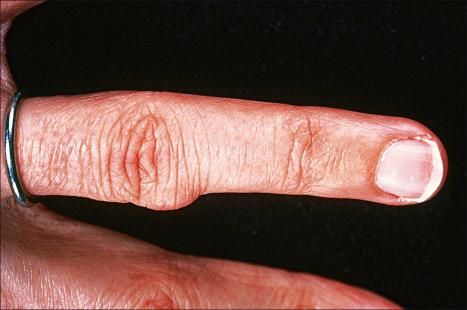
It presents as a slowly growing, usually painless nodule and is most often less than 2 cm in diameter. Multiple or bilateral lesions are uncommon. This lesion has no malignant potential, but may recur locally in up to 30% of cases, usually as a consequence of incomplete excision. It appears that there is increased risk of local recurrence in lesions involving the flexor and extensor tendons and the joint capsules. Invasion of the underlying bone has been reported in up to 11% of cases. Nerve-adherent tumors have been reported.
The diffuse tenosynovial giant cell tumor is a rare variant which tends to involve the distal limbs, the larger joints of the limb girdles (especially the hip) and more rarely the vertebral column. It is locally aggressive and there is quite often infiltration of extra-articular soft tissues and occasionally bone. Recurrence in up to a third of cases is common following incomplete surgical excision. Exceptional tumors with benign histology may metastasize to regional lymph nodes, and tumors with sarcomatous change may develop distant metastases.
The reactive or neoplastic nature of giant cell tumor of tendon sheath has debated for years, and it has finally been confirmed as a neoplastic process. The most common cytogenetic abnormality is t(1;2)(p13;q37) placing the colony-stimulating factor (CSF) under the COL6A3 promoter. Substitution of COL6A3 by other promoters is also possible. These cytogenetic abnormalities result in overexpression of CSF-1, but only in a small subset of cells. The majority of apparently nonclonal cells, particularly macrophages, express CSF-1 receptor, a situation described as ‘tumor landscaping effect’. This may explain why some studies fail to demonstrate clonality.
The tumors are usually lobulated and well defined, often with a fibrous pseudocapsule ( Fig. 35.259 ). They are composed of mononuclear cells with eosinophilic cytoplasm and vesicular nuclei, xanthomatous cells, siderophages, osteoclast-like multinucleated giant cells and mononuclear inflammatory cells ( Figs 35.260–35.262 ). The cells are typically set in a variably prominent collagenous stroma within which cholesterol clefts or evidence of previous hemorrhage in the form of stromal hemosiderin may be apparent. Normal mitotic figures are commonly seen and may be numerous. Old lesions can show prominent hyalinization. Tumors lacking giant cells and some with hepatoid cells have been reported.
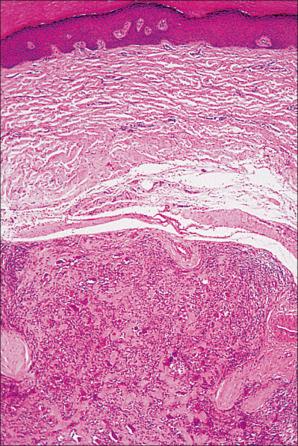
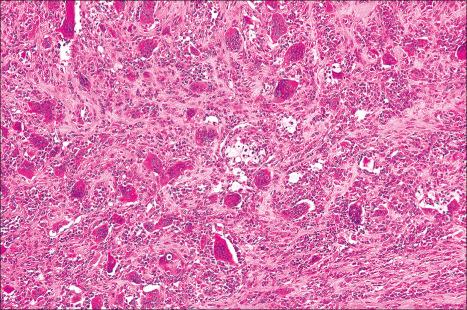
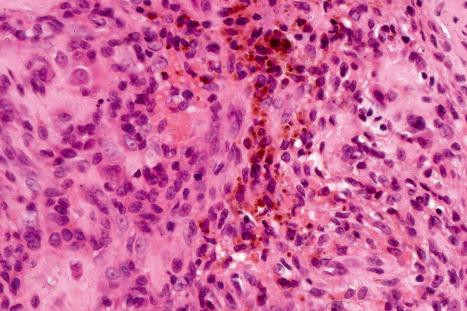
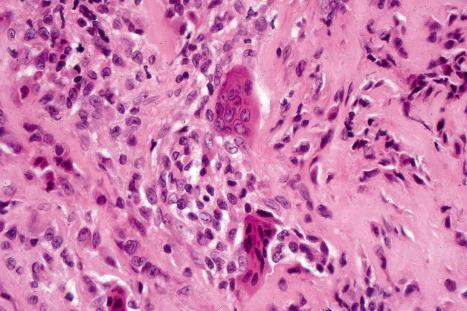
Immunohistochemically, some of the mononuclear cells and most of the osteoclastic giant cells are CD68, CD163 and CD45 positive. Actin may be focally positive in the mononuclear cells. Large mononuclear cells may express D2-40. Other markers are generally uninformative.
Histologic appearances of diffuse giant cell tumor are similar to those of the localized variant, except that cellularity is often higher, osteoclastic cells tend to be fewer and intralesional cleft-like spaces are common. An additional feature seen in most cases is the presence of a subpopulation of large, desmin-positive, dendritic histiocyte-like cells. These have abundant eosinophilic cytoplasm, large vesicular nuclei, paranuclear eosinophilic inclusions and rare intranuclear inclusions.
Fibroma of tendon sheath may be distinguished by its more uniform spindled cell appearance, its greater tendency for stromal hyalinization and the presence of characteristic slit-like vascular spaces. However, as mentioned under fibroma of tendon sheath, some cases show overlapping features. Granulomatous inflammatory lesions are not usually circumscribed, show greater infiltration by chronic inflammatory cells and usually contain well-developed epithelioid granulomata. Diffuse-type lesions can be distinguished from synovial sarcoma by the absence of an epithelial lining in the clefts and negativity for epithelial markers.
Giant cell tumor of soft tissues (also known as soft tissue giant cell tumor of low malignant potential) is regarded as the soft tissue counterpart of giant cell tumor of bone, although it seems to be genetically distinct (see below). It is rare and presents mainly in adults, with no sex predilection. The great majority of lesions occur in the limbs followed by the trunk and only exceptionally in the head and neck. Most tumors are well circumscribed and subcutaneous but dermal (exceptionally polypoid) and deeper lesions may occur. The size ranges from less than 1 cm to up to 10 cm. In a single documented case, the tumor had been present for 46 years. Local recurrence is seen in up to 10% of cases and metastases are exceptional and include one from a case arising in the skin.
The pathogenesis is unknown but rare associations with trauma, surgical scars and Paget disease of bone have been reported. Although tumors are morphologically very similar to those presenting in bone, recent studies showed not only immunophenotypical differences between both lesions, but also failed to identify point mutations of the H3F3A gene often found in bone tumors in lesions presenting in soft tissues.
Histology shows a well-defined tumor that is often multinodular and has focal areas of hemorrhage ( Fig. 35.263 ). A peripheral shell of bone is seen in some cases. Focal areas of bone formation can also be present elsewhere in the tumor. Hemorrhage, aneurysmal bone cyst-like areas and sclerotic changes are additional features. Vascular invasion is found in up to one-third of the cases. Tumor cells consist of a mixture of osteoclast-like giant cells and mononuclear cells ( Fig. 35.264 ). The osteoclast-like giant cells often form nodular aggregates.
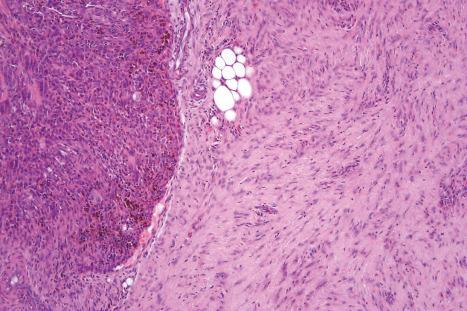
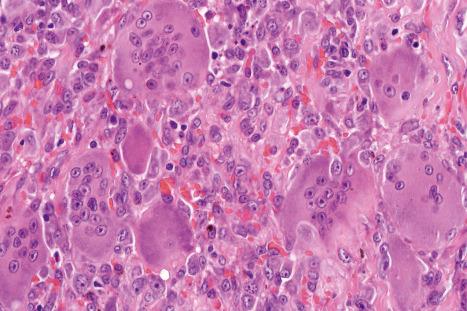
Both the osteoclast-like giant cells and the mononuclear cells are positive for CD68. Positive staining for actin may be focally present in mononuclear cells but not in the giant cells. Exceptional focal positivity for keratin and S100 protein can be seen.
Angiomatoid fibrous histiocytoma (previously known as angiomatoid malignant fibrous histiocytoma) is a rare tumor. It usually arises in the subcutaneous tissues and only exceptionally in the dermis of the extremities or trunk in children or young adults of either sex. Presentation in the head and neck is exceptional. Unusual sites include the lung, brain, mediastinum, vulva, retroperitoneum and ovary. Lesions arising in deeper soft tissues are less common. A congenital example has been documented. A case arising in the background of chronic radiodermatitis, a tumor developing in an HIV-positive child and one in a child with neuroblastoma have also been reported. Most tumors are slow growing and less than 2 cm in diameter. Patients sometimes present with systemic symptoms including fever, weight loss, anemia and paraproteinemia. Systemic symptoms usually disappear after removal of the tumor and might be caused by EWSR1-CREB1 induced excess of interleukin-6 (IL-6). There is local recurrence in 2–12% of cases. Recurrences appear to be associated with deep-seated lesions, those with an infiltrative margin and lesions located in the head and neck. Metastases to local lymph nodes occur in up to 1% of cases but behavior is usually benign with only very exceptional cases presenting with distant metastases and death. No histologic features allow prediction of which tumors will recur or metastasize.
The most common chromosomal translocation is t(2;22) resulting in EWSR1-CREB1 in the large majority of cases. An EWSR1-ATF1 or FUS-ATF1 fusion is found in a small subset of cases. CREB1, ATF1 and CREM are closely related members of the cAMP response element binding protein (CREB) family. The same EWSR1-CREB1 and/or EWSR1-ATF1 fusion is also seen in clear cell sarcoma, clear cell sarcoma-like tumor of the gastrointestinal tract, primary pulmonary myxoid sarcoma, hyalinizing clear cell carcinoma of the salivary gland, clear cell odontogenic carcinoma, and most recently, a ‘novel mesenchymal tumor with predilection for intracranial location.’ These fusions are thus among the most promiscuous in biology indicating that EWSR1 fused to CREB family members can result in neoplastic, and usually malignant, transformation in a variety of cellular contexts – both mesenchymal and epithelial. The type of fusion found is not associated with prognosis. A recent study emphasizes the importance of performing RT-PCR in conjunction with FISH to increase the diagnostic yield.
Angiomatoid fibrous histiocytoma is characterized by well-circumscribed nodules composed of relatively uniform, pale, round or short spindle-shaped eosinophilic cells with ovoid vesicular nuclei, interspersed with blood-filled pseudovascular spaces and foci of hemorrhage ( Figs 35.265–35.267 ). Mitotic figures are usually not prominent. Typically, there is a dense lymphoplasmacytic mantle around and within the tumor, which thereby often simulates a lymph node. Cytologic atypia (which may be prominent) and mitotic activity may sometimes be more prominent but this does not correlate with behavior. Scattered giant cells are seen. Other unusual histologic findings include a solid growth pattern lacking pseudoangiomatoid spaces, perivascular hyalinization, nuclear palisading, myxoid stroma with reticular arrangement reminiscent of myoepithelioma, sclerosis with a perineurioma-like pattern, and atypical mitotic figures. Late-stage lesions may present with marked fibrosis. A case of a ‘pure’ spindle cell tumor arising in the forearm musculature of a 19-year-old female has been reported.
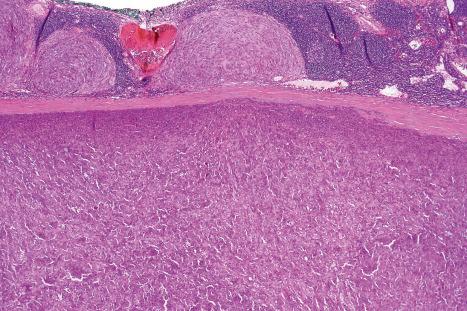
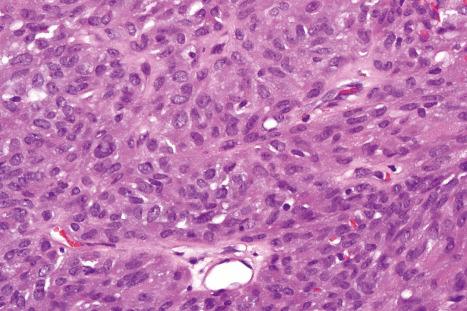
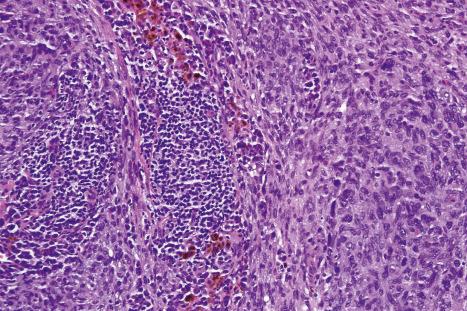
Immunohistochemically, tumor cells are positive in about 50% of cases for desmin and for muscle actin (HHF-35), but not for smooth muscle actin ( see Fig. 35.203 ). Positivity for EMA, CD68 and CD99 is usually seen in up to 50% of cases. Tumor cells are negative for S100 protein, keratins and vascular markers. It is possible, combining morphology with immunophenotype, that these lesions show myoid (probably myofibroblastic) differentiation, although the combination of EMA and desmin is unusual.
Ultrastructural studies show a variety of cells including fibroblastic, myofibroblastic, histiocyte-like or undifferentiated forms.
Distinction from aneurysmal fibrous histiocytoma is discussed under the latter entity.
Plexiform fibrohistiocytic tumor is a rare but distinctive neoplasm that most commonly presents on the limbs of children and young adults (more than 50% of patients are younger than 20 years) and has a slight predilection for females. A single congenital case has been documented. About 60% of the cases occur on the upper limbs (particularly the forearms, hands and wrists) followed by the lower limbs (about one-third of cases). Involvement of the trunk and face and neck is very rare. Lesions present as an ill-defined nodule or plaque that predominantly involves the subcutaneous tissue but may extend into the dermis. Dermal variants of the tumor may occur. There is a tendency for local recurrence varying from 12% to 37.5% of cases. Local lymph node metastasis has been reported in three cases and in one of these spread to the lungs was also seen. Presentation in bone and multiple tumors are very rare.
Cytogenetic studies have been performed in some cases with differing clonal chromosomal abnormalities. It has been suggested that plexiform fibrohistiocytic tumor and cellular neurothekeoma are part of the same spectrum, based on morphological and phenotypic similarities. This is however, not a view that has been generally accepted.
Tumors are infiltrative and most are located mainly at the junction between the dermis and subcutaneous tissue, and occasionally there is involvement of underlying skeletal muscle ( Figs 35.268–35.271 ). About one-third of cases are predominantly dermal. Microscopic appearances vary according to the proportion of two main components, one of which may predominate:
fascicles of fibroblast/myofibroblast-like cells, which usually predominate (fibroblastic),
nodules of histiocyte-like cells (histiocytic).
Varying numbers of osteoclast-like giant cells are also present, mainly in the histiocytic variant. Areas of hemorrhage with hemosiderin deposition can be seen in and around the nodules, which may also show peripheral hyalinization. Often, the fibroblastic fascicles appear to radiate from a more solid central area. Entrapment of fat with the presence of microfat cells and myxoid change is occasionally observed. A focal lymphocytic inflammatory cell infiltrate is seen in most cases and it tends to be more prominent in the fibroblastic variant. Perineural and peripacinian extension is rarely seen and in a few cases there is cytologic atypia and increased mitotic activity. Occasionally, vascular invasion is present ( Fig. 35.272 ). Bone formation has also exceptionally been documented. Dermal tumors spare adnexal structures. A variant of plexiform fibrohistiocytic tumor with prominent granular cell change has been described. A myxoid stroma is an unusual finding.
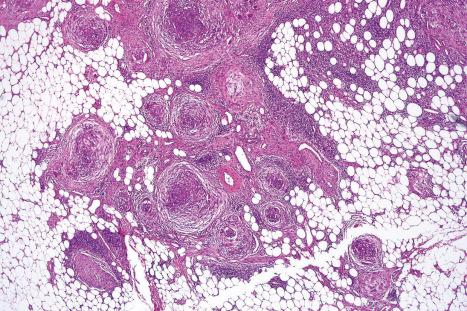
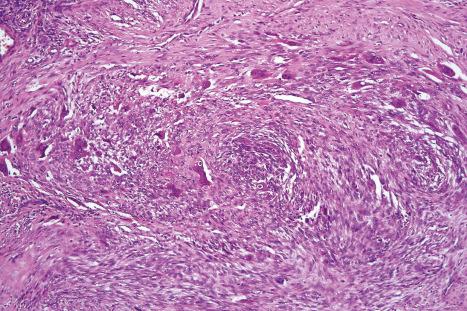
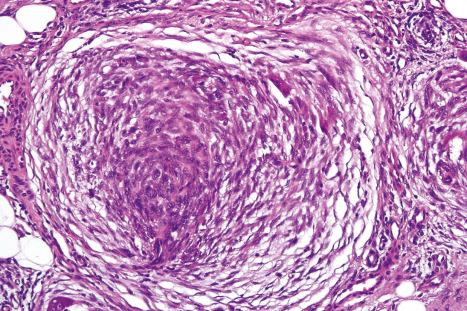
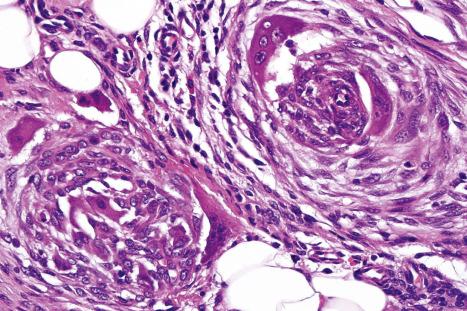
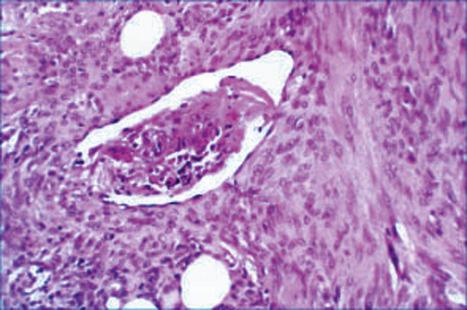
There are no histologic findings that allow prediction of tumors that will recur or metastasize.
By immunohistochemistry, most of the giant cells and some of the mononuclear cells within the nodules express CD68, while the spindle-shaped cells outside the nodules label for SMA and calponin. Some of the mononuclear cells within the nodules are focally positive for SMA. Myofibroblastic differentiation of the latter cells is also suggested by ultrastructural studies.
Cases with a prominent fibroblastic component may be confused with dermatomyofibroma and fibromatosis ( Fig. 35.273 ). The former, however, is mainly dermal and the latter is deep seated. Both lack a plexiform growth pattern. Fibrous hamartoma of infancy has a typical organoid growth pattern and lacks histiocytic nodules with osteoclast-like giant cells. Dermal and deep benign fibrous histiocytomas usually have a more cohesive growth pattern and polymorphism is seen throughout the lesion. Other entities with a plexiform pattern (e.g, cellular neurothekeoma, dermal nerve sheath myxoma, plexiform schwannoma, and plexiform neurofibroma) can be differentiated with the use of immunohistochemical stains especially in small biopsies. MITF may be of help in distinguishing, plexiform fibrohistiocytic tumor rich in histiocyte-like cells from cellular neurothekeoma especially in small samples, as in the former, tumor cells are negative for this marker, while in the latter they are very commonly diffusely positive.
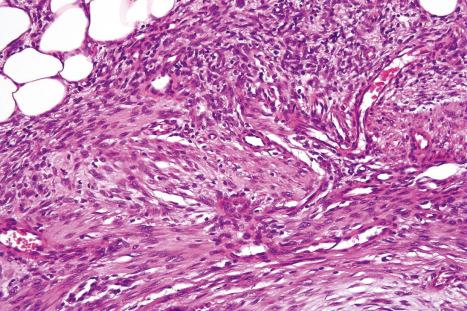
Atypical fibroxanthoma and pleomorphic dermal sarcoma are described together as they are likely to represent part of the spectrum of the same neoplasm as suggested by clinical, histologic, immunophenotypic, and molecular features (see below). Distinction between both is important because of the more aggressive behavior of the latter and it is based on histologic features as described below.
Tumors almost always present on the sun-exposed actinically damaged areas of the head and neck of individuals in the seventh or eighth decade of life. An atypical fibroxanthoma in a 115 -year-old man has been reported. Incidence figures depend on local climate and skin pigmentation. The lesion presents as a firm solitary cutaneous nodule, which is often ulcerated, rarely exceeds 3 cm in diameter and has typically been present for less than 1 year ( Figs 35.274 and 35.275 ). Tumors may arise in the setting of xeroderma pigmentosum and solid organ transplantation. Although the latter patients generally do not seem to be at increased risk of developing the tumor, multiple lesions developed in a heart transplant patient. A case in an African-American woman, one following hair transplantation, another in the palpebral conjunctiva, one arising in the background of a nevus sebaceous, one at the site of a thermal burn and one on a pacemaker pocket have been reported. However, as the pathogenesis of these tumors is related to sun exposure, such a diagnosis should only be accepted in the setting of sun-damaged skin.
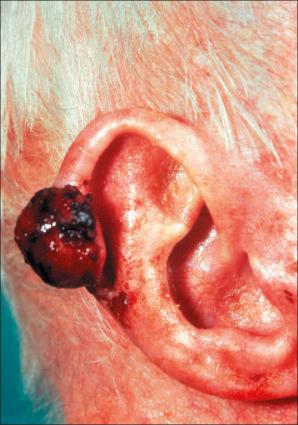
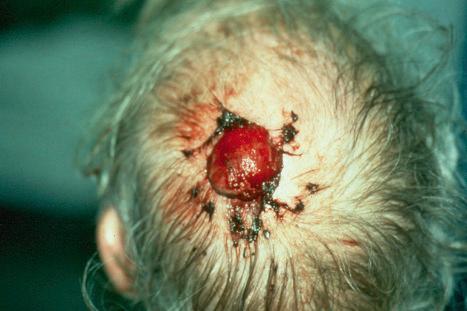
Complete excision is the treatment of choice. The overall rate of local recurrence is about 5% of patients and metastatic spread is very rare. Most of the cases with metastasis reported in the older literature before immunohistochemistry was available are likely to represent examples of other pleomorphic malignancies and therefore most probably represent misdiagnoses. The great majority of tumors that metastasize are those classified as pleomorphic dermal sarcoma. In this group, a local recurrence rate of 28% and a metastatic rate of 10% has been reported. A more recent study of a small series of cases has suggested a more aggressive course for dermal pleomorphic sarcoma with a metastatic rate of 20%. Exceptional cases of atypical fibroxanthoma which do not fulfill the criteria for the diagnosis of pleomorphic dermal sarcoma may develop metastatic disease. Metastatic lesions have been reported to lymph nodes, lungs and peritoneum. An exceptional case with recurrence, satellite nodules and lymph node metastasis has been reported.
The rate of local recurrence appears to be less in patients treated with Mohs micrographic surgery although this has not been confirmed in a recent study.
Etiologically, almost all cases are associated with solar or therapeutic irradiation damage. Support for the pathogenetic role of ultraviolet light in the genesis of this tumor is given by the recent demonstration of classical p53 UV-induced mutations (C–T and C–G transitions). Further support comes from the demonstration of immunoexpression of UV photoproducts of cyclobutane pyrimidine dimers in atypical fibroxanthoma. In a small percentage of cases, Merkel cell polyomavirus DNA has been detected but the significance of this finding is not clear. Both atypical fibroxanthomas and pleomorphic dermal sarcoma have been found to have high number of similar recurrent mutations in multiple genes including FAT1, NOTCH1/2, CDKN2A , and TP53 as well as the TERT promoter. This strongly supports the contention that these two neoplasms are part of the same spectrum.
Atypical fibroxanthomas are characteristically reasonably well-defined, predominantly dermal lesions, which may show extremely superficial invasion of subcutaneous fat in a small proportion of cases; they usually abut on the basal layer of the epidermis and ulceration is common ( Figs 35.276–35.278 ). Most lesions are polypoid and often have an epidermal collarette. The deep margin is generally pushing.
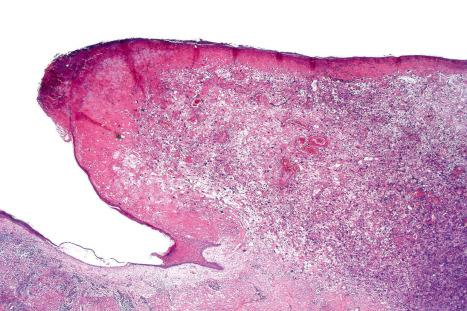
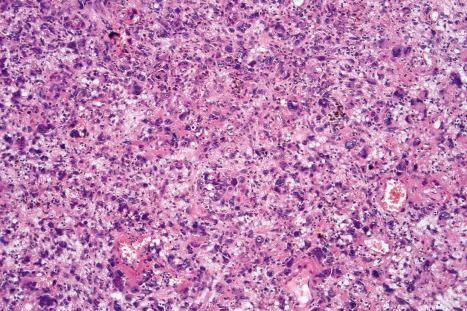
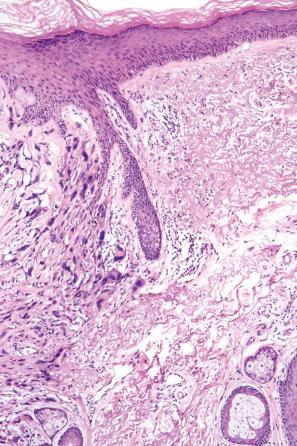
The appearances comprise an admixture of spindle-shaped cells, histiocyte-like cells, xanthomatous cells and multinucleated giant cells, any or all of which may show marked pleomorphism, hyperchromasia and prominent mitotic activity ( Figs 35.279–35.282 ). Abnormal forms are also common. In some tumors, epithelioid cells may be prominent. From a purely cytological point of view, therefore, atypical fibroxanthoma appears malignant. A chronic inflammatory infiltrate may be seen, particularly at the periphery of the tumor. The adjacent dermis shows marked solar elastosis.
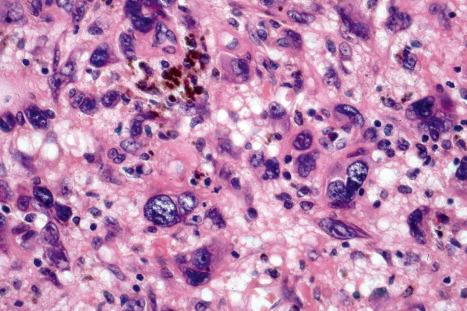
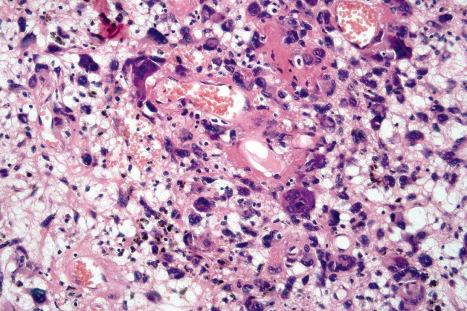
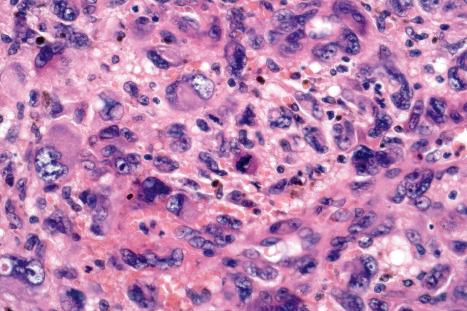
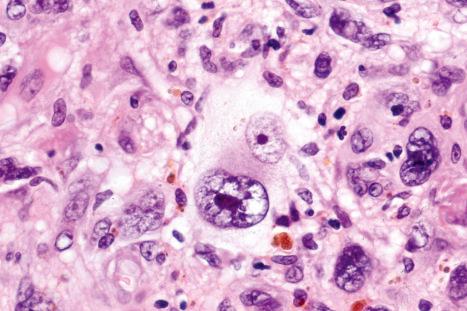
Histologic variants of atypical fibroxanthoma include tumors with pigment, clear cell change, granular cell change, with osteoclast-like giant cells, myxoid change, and with keloidal change in the collagen. Hemorrhage may be prominent and tumors may mimic a vascular lesion ( Figs 35.283 and 35.284 ). Occasional cases display prominent sclerosis and even regression (focal or extensive). An osteosarcomatous or chondrosarcomatous component, a lymphomatoid CD30-positive reaction and amyloid are exceptional.
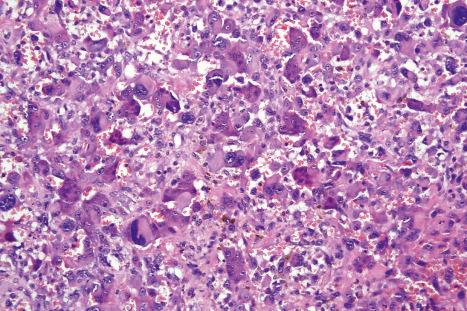
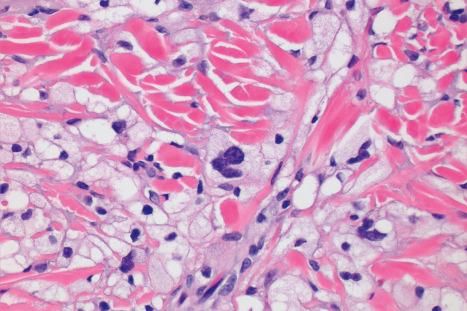
Spindle cell atypical fibroxanthoma is a relatively monomorphic variant which is composed predominantly of spindle-shaped cells with mild to moderate pleomorphism ( Figs 35.285–35.287 ).
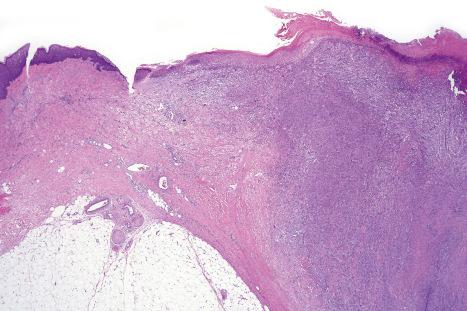
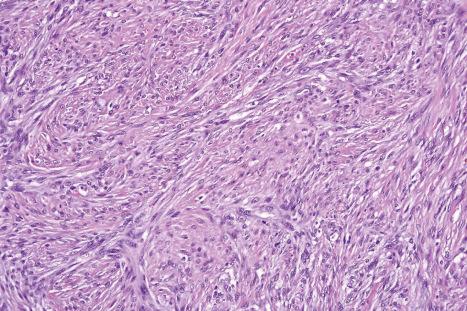
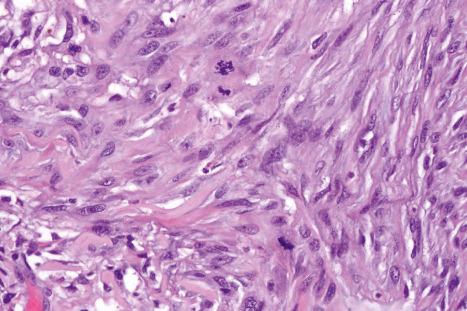
Pleomorphic dermal sarcoma shows the same histologic spectrum described before but in addition the displays; invasion of the subcutaneous tissue, necrosis, lymphovascular invasion or perineural invasion ( Figs 35.288–35.291 ) . Immunohistochemistry as described below is essential to confirm this diagnosis of exclusion as neoplasms like melanoma and sarcomatoid squamous cell carcinoma may display the latter findings.
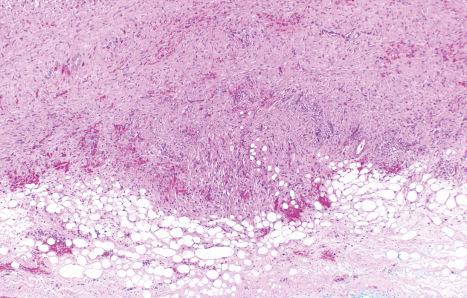
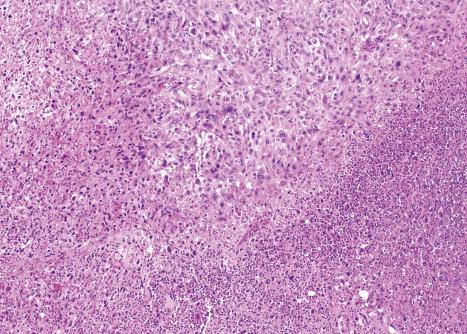
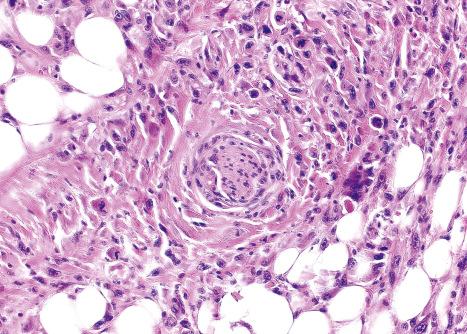
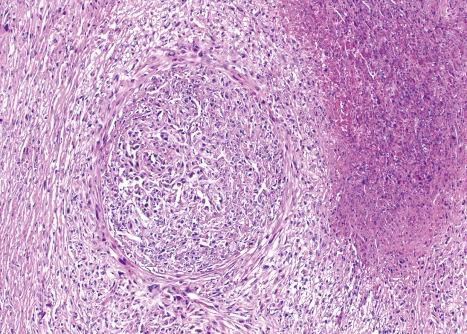
By immunohistochemistry ( Figs 35.292 and 35.293 ), the spindle cells are focally positive for SMA and calponin and the mononuclear and multinucleated cells are variably positive for CD68. Focal positivity for EMA and p63 may also be seen. Other markers that are positive in tumor cells include CD99 and procollagen I. CD163 is focally positive in some cases. CD10 has been regarded as a useful marker, as most tumors show strong diffuse positivity for this marker. However, any tumor with spindle cell morphology may show positivity for CD10, including sarcomas such as myxofibrosarcoma. CD31 may be focally positive, albeit in a granular pattern analogous to the one observed in histiocytic markers. FLI1 may also be positive and this may lead to an erroneous diagnosis of angiosarcoma, especially in cases associated with hemorrhage. In one case, focal positivity was reported for HMB-45 and MART-1 but only in the neoplastic giant cells. In a further tumor with clear cell change, HMB-45 was expressed. Tumor cells are negative for S100 protein, but may be positive for MITF. Keratins, desmin, h-caldesmon and CD117 are negative. An important pitfall is that a number of tumors contain a prominent number of reactive, dendritic S100 protein-positive cells in the background, and this may be interpreted as positivity of tumor cells.
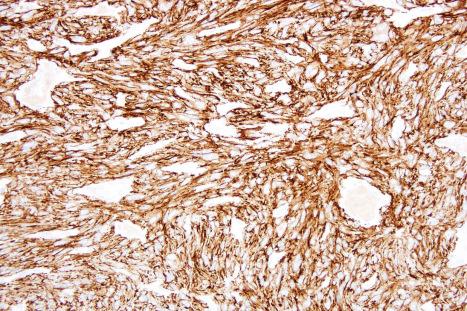
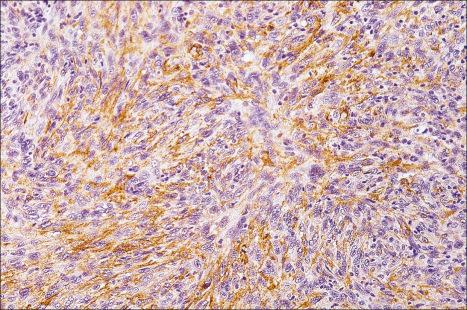
Atypical fibroxanthoma and pleomorphic dermal sarcoma are diagnoses of exclusion. Distinction from spindle cell variants of squamous carcinoma or melanoma is helped by adequate tissue sampling to detect an epithelial origin, a junctional component or more obviously differentiated areas, but this is not often found. Immunocytochemical stains for S100 protein, keratin and desmin expression should always be undertaken to exclude melanoma, spindle cell squamous cell carcinoma, an unusual metastasis or a leiomyosarcoma. P63 is a useful marker as it is diffusely positive in sarcomatoid squamous cell carcinoma and usually negative or minimally positive in atypical fibroxanthoma/pleomorphic dermal sarcoma. It is important to highlight that sarcomatoid squamous cell carcinomas of the skin are often negative for CAM 5.2.
Merkel cell carcinoma, which recurred with features mimicking atypical fibroxanthoma, has been described as has a ‘collision tumor’ of these two types. A collision with basal cell carcinoma and one with invasive melanoma have also been documented and this may represent a source of error in small samples.
Tumors reported in the past as atypical fibroxanthoma occurring in non–sun-exposed skin of young patients represent examples of atypical fibrous histiocytoma.
Traditionally, undifferentiated pleomorphic sarcoma (malignant fibrous histiocytoma) has been regarded as the most common soft tissue sarcoma and five distinctive variants were originally described including pleomorphic, myxoid, angiomatoid, giant cell and inflammatory. Over the years, however, it has become apparent that not only there is no true histiocytic differentiation in these tumors, but also that some of these variants have very little in common. The angiomatoid variant has been reclassified as angiomatoid fibrous histiocytoma. Moreover, the existence of a pleomorphic subtype (by far the most common tumor in the group) as an independent entity has been challenged. In the current WHO classification (2013) the term ‘malignant fibrous histiocytoma’ is omitted. Under the heading ‘tumors of unknown origin,’ the term undifferentiated/unclassified sarcoma is used with the following subdivisions: spindle cell, pleomorphic, round cell, epithelioid, and NOS. Some of the round cell variants described as ‘Ewing-like’ are associated with specific translocations. Likely these will become distinctive entities outside of the undifferentiated sarcoma category in next WHO classification. These entities are briefly described in the Ewing sarcoma section (see page 1810 ).
Pleomorphic malignant fibrous histiocytoma as classically described is characterized histologically by prominent cytological pleomorphism, bizarre multinucleated giant cells, often a storiform pattern, and a mononuclear inflammatory cell infiltrate with foamy macrophages. However, these features are non-specific and pleomorphic malignant fibrous histiocytoma as mentioned before, represents a waste basket for pleomorphic neoplasms, which, if studied by appropriate techniques such as immunohistochemistry and molecular methods, demonstrate a specific line of differentiation in the vast majority of cases. Although most prove to be sarcomas (pleomorphic variants of leiomyosarcoma, rhabdomyosarcoma, liposarcoma), a small proportion represent melanomas or epithelial or even lymphoid neoplasms, and around 10% defy further classification.
Excluding the spectrum of atypical fibroxanthoma/pleomorphic dermal sarcoma, other pleomorphic sarcomas are very rare in the skin and it is important to remember that the majority of ‘sarcomatoid’ cutaneous lesions are not true sarcomas but spindle cell variants of melanoma and carcinoma. Most true pleomorphic sarcomas in the skin represent extension from tumors arising in deeper soft tissues.
The groups described as giant cell malignant fibrous histiocytoma and inflammatory malignant fibrous histiocytoma, are no longer accepted as discreet entities. They are briefly discussed here for the sake of completeness to highlight that many of these lesions can be further subclassified into a distinctive group of neoplasms with the use of ancillary techniques.
Giant cell malignant fibrous histiocytoma represents a heterogeneous group of tumors, which have in common a multinodular growth pattern and the presence of multiple osteoclast-like multinucleated giant cells. It was originally described in older individuals and show a predilection for the limbs. More than 50% of cases show neoplastic osteoid or bone formation and they are better classified as soft tissue osteosarcomas. A smaller proportion of tumors represent leiomyosarcomas rich in osteoclast-like giant cells and a further group of lesions is indistinguishable from giant cell tumor of bone. The last has a benign histology and behavior is generally benign; as such it has been reclassified as giant cell tumor of soft tissue or soft tissue giant cell tumor of low-grade malignant potential (see page 1772 ). It should be remembered that a variety of other lesions with a different phenotype, including atypical fibroxanthoma can be rich in osteoclast-like giant cells and that immunohistochemistry is an important aid in differential diagnosis.
Inflammatory malignant fibrous histiocytoma was originally described as a variant of so-called malignant fibrous histiocytoma presenting mainly in the retroperitoneum and other visceral soft tissues. Since its original description, it has been proven, by the use of ancillary techniques, that in the majority of cases it represents a pattern of dedifferentiation in a dedifferentiated liposarcoma.
Undifferentiated pleomorphic sarcomas located superficially in the skin and subcutis, often display a highly infiltrative growth pattern. Local recurrence is therefore common. These tumors display a complex karyotype and only TP53, RB1 and ATRX are noted to be significantly mutated.
Become a Clinical Tree membership for Full access and enjoy Unlimited articles
If you are a member. Log in here